Collaboration Networks Analysis
VerifiedAdded on 2020/07/22
|39
|12745
|84
AI Summary
This assignment requires a comprehensive analysis of collaboration networks in various contexts, including scientific research, innovation management, governance, and social networks. The task involves examining the structure, growth patterns, and vulnerabilities of these networks, as well as exploring the benefits and challenges associated with collaborative efforts. A detailed study of case studies and real-world examples is also expected to provide insights into successful collaboration strategies.
Contribute Materials
Your contribution can guide someone’s learning journey. Share your
documents today.
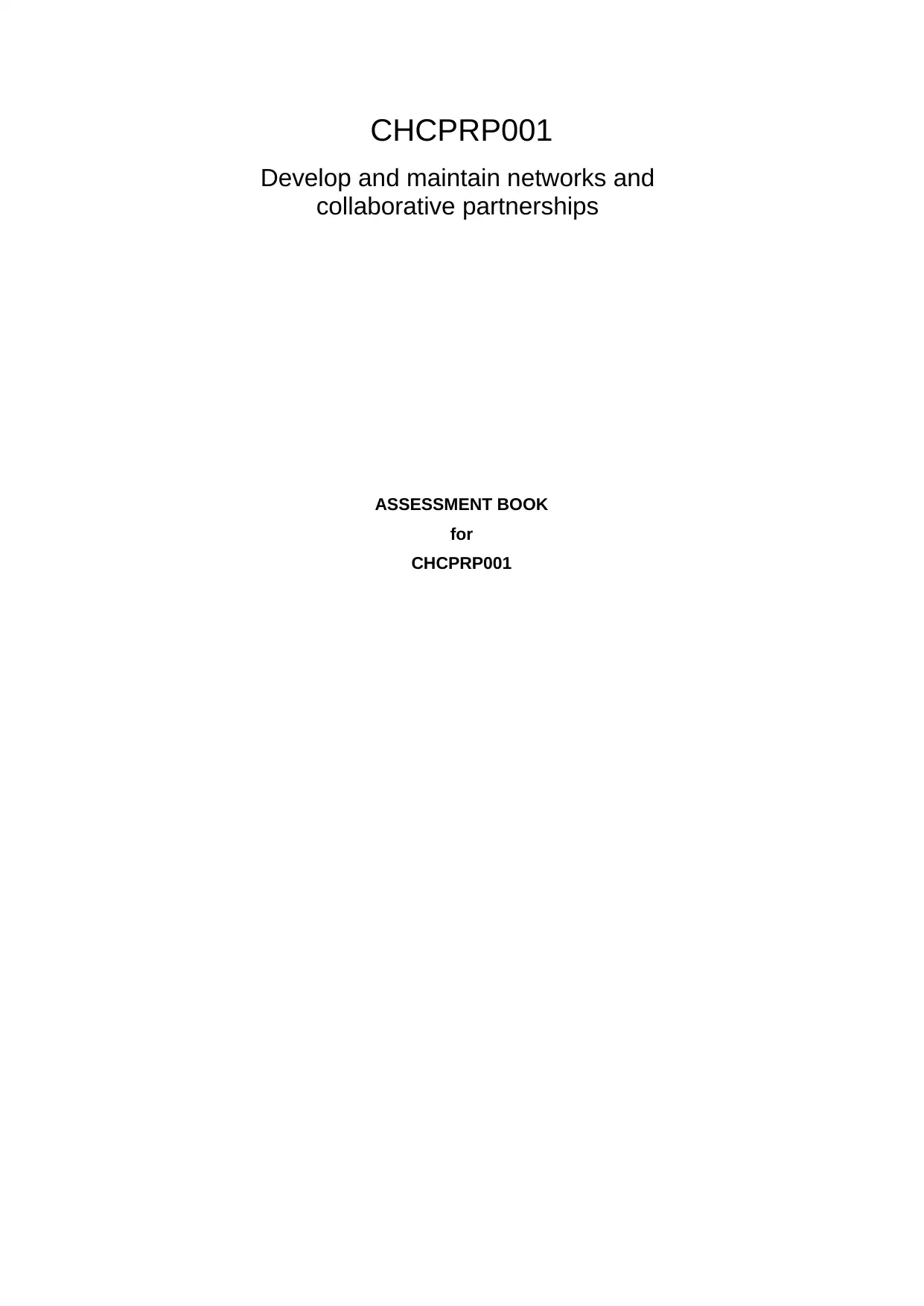
CHCPRP001
Develop and maintain networks and
collaborative partnerships
ASSESSMENT BOOK
for
CHCPRP001
Develop and maintain networks and
collaborative partnerships
ASSESSMENT BOOK
for
CHCPRP001
Secure Best Marks with AI Grader
Need help grading? Try our AI Grader for instant feedback on your assignments.

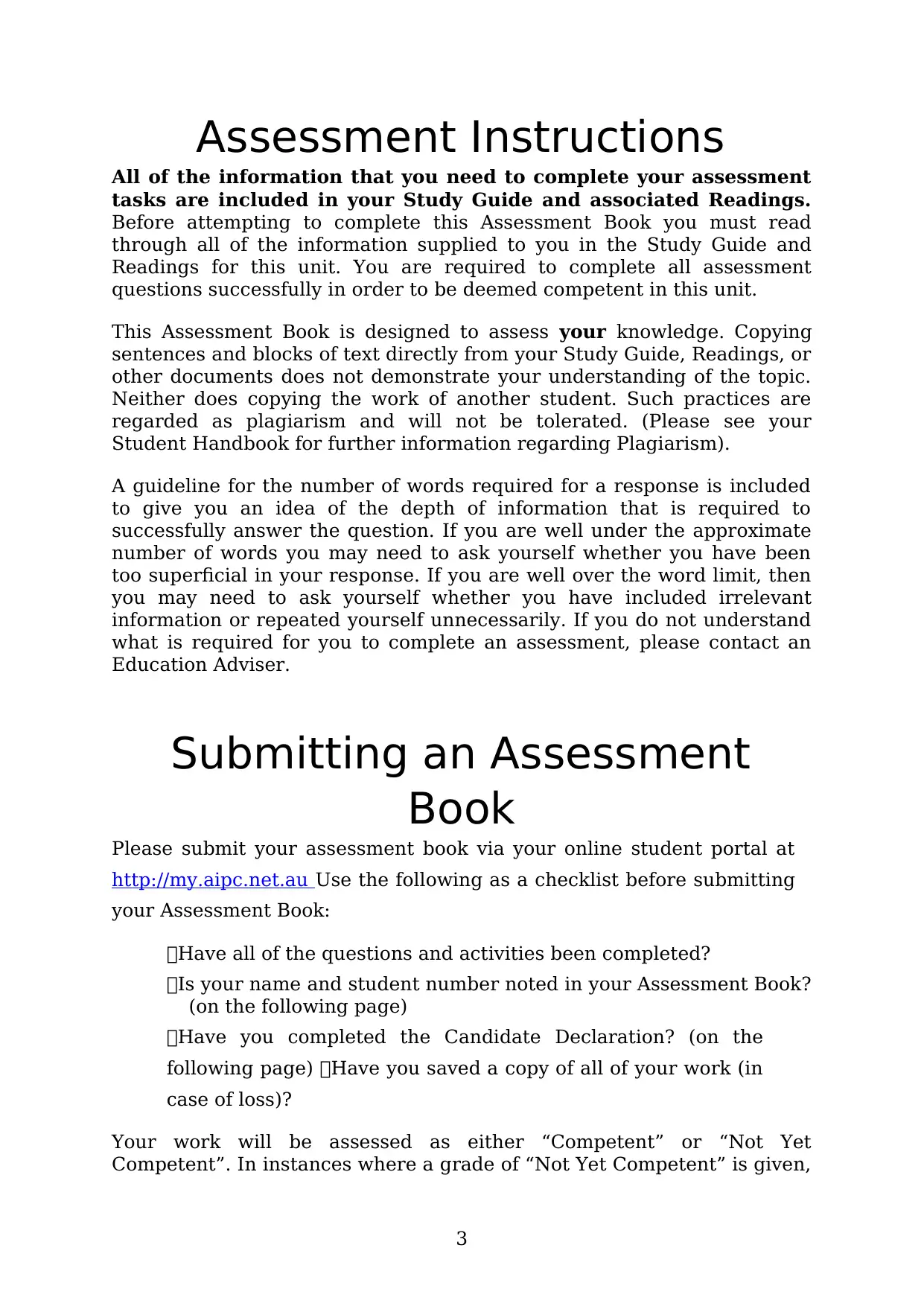
Assessment Instructions
All of the information that you need to complete your assessment
tasks are included in your Study Guide and associated Readings.
Before attempting to complete this Assessment Book you must read
through all of the information supplied to you in the Study Guide and
Readings for this unit. You are required to complete all assessment
questions successfully in order to be deemed competent in this unit.
This Assessment Book is designed to assess your knowledge. Copying
sentences and blocks of text directly from your Study Guide, Readings, or
other documents does not demonstrate your understanding of the topic.
Neither does copying the work of another student. Such practices are
regarded as plagiarism and will not be tolerated. (Please see your
Student Handbook for further information regarding Plagiarism).
A guideline for the number of words required for a response is included
to give you an idea of the depth of information that is required to
successfully answer the question. If you are well under the approximate
number of words you may need to ask yourself whether you have been
too superficial in your response. If you are well over the word limit, then
you may need to ask yourself whether you have included irrelevant
information or repeated yourself unnecessarily. If you do not understand
what is required for you to complete an assessment, please contact an
Education Adviser.
Submitting an Assessment
Book
Please submit your assessment book via your online student portal at
http://my.aipc.net.au Use the following as a checklist before submitting
your Assessment Book:
Have all of the questions and activities been completed?
Is your name and student number noted in your Assessment Book?
(on the following page)
Have you completed the Candidate Declaration? (on the
following page) Have you saved a copy of all of your work (in
case of loss)?
Your work will be assessed as either “Competent” or “Not Yet
Competent”. In instances where a grade of “Not Yet Competent” is given,
3
All of the information that you need to complete your assessment
tasks are included in your Study Guide and associated Readings.
Before attempting to complete this Assessment Book you must read
through all of the information supplied to you in the Study Guide and
Readings for this unit. You are required to complete all assessment
questions successfully in order to be deemed competent in this unit.
This Assessment Book is designed to assess your knowledge. Copying
sentences and blocks of text directly from your Study Guide, Readings, or
other documents does not demonstrate your understanding of the topic.
Neither does copying the work of another student. Such practices are
regarded as plagiarism and will not be tolerated. (Please see your
Student Handbook for further information regarding Plagiarism).
A guideline for the number of words required for a response is included
to give you an idea of the depth of information that is required to
successfully answer the question. If you are well under the approximate
number of words you may need to ask yourself whether you have been
too superficial in your response. If you are well over the word limit, then
you may need to ask yourself whether you have included irrelevant
information or repeated yourself unnecessarily. If you do not understand
what is required for you to complete an assessment, please contact an
Education Adviser.
Submitting an Assessment
Book
Please submit your assessment book via your online student portal at
http://my.aipc.net.au Use the following as a checklist before submitting
your Assessment Book:
Have all of the questions and activities been completed?
Is your name and student number noted in your Assessment Book?
(on the following page)
Have you completed the Candidate Declaration? (on the
following page) Have you saved a copy of all of your work (in
case of loss)?
Your work will be assessed as either “Competent” or “Not Yet
Competent”. In instances where a grade of “Not Yet Competent” is given,
3
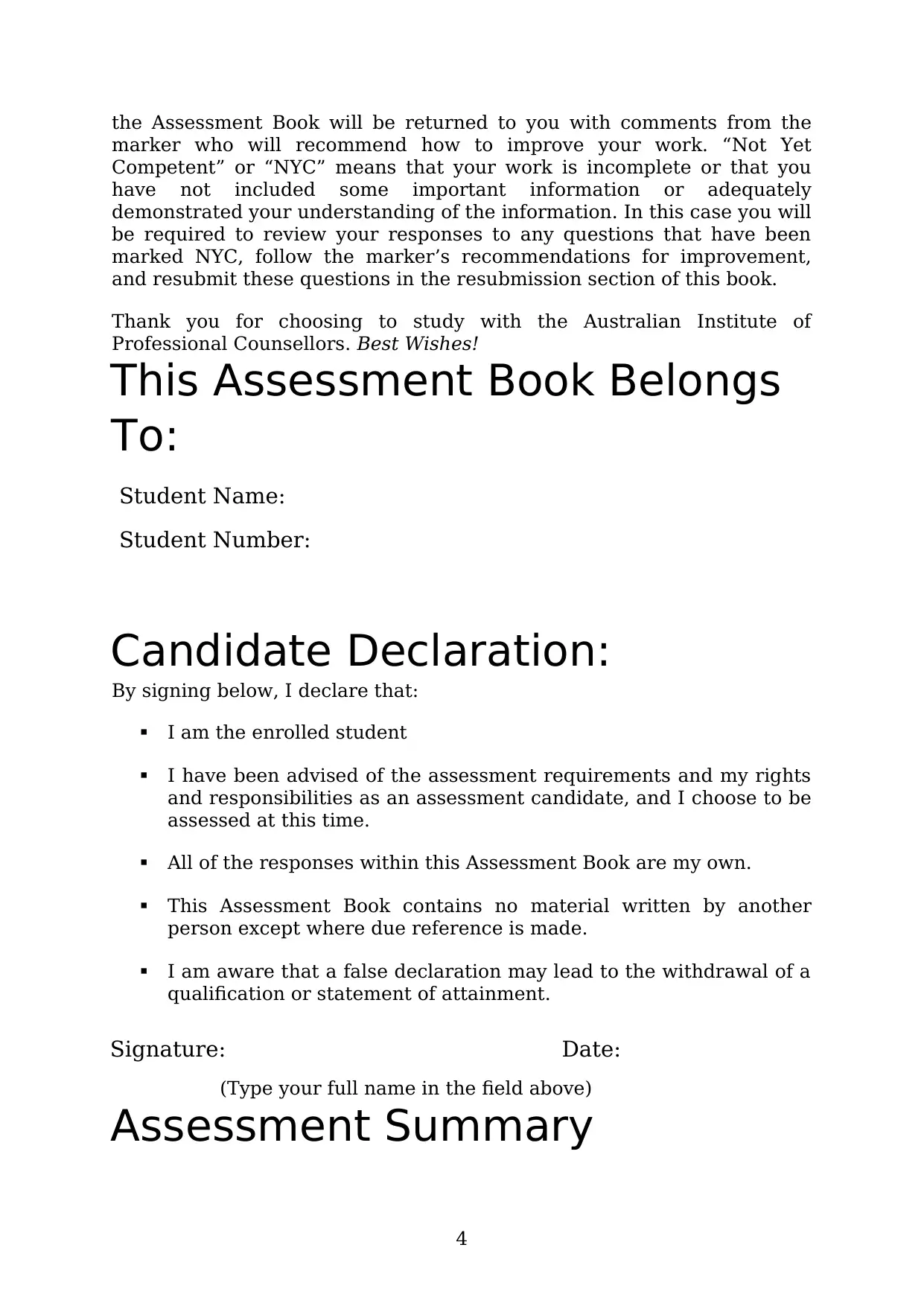
the Assessment Book will be returned to you with comments from the
marker who will recommend how to improve your work. “Not Yet
Competent” or “NYC” means that your work is incomplete or that you
have not included some important information or adequately
demonstrated your understanding of the information. In this case you will
be required to review your responses to any questions that have been
marked NYC, follow the marker’s recommendations for improvement,
and resubmit these questions in the resubmission section of this book.
Thank you for choosing to study with the Australian Institute of
Professional Counsellors. Best Wishes!
This Assessment Book Belongs
To:
Student Name:
Student Number:
Candidate Declaration:
By signing below, I declare that:
I am the enrolled student
I have been advised of the assessment requirements and my rights
and responsibilities as an assessment candidate, and I choose to be
assessed at this time.
All of the responses within this Assessment Book are my own.
This Assessment Book contains no material written by another
person except where due reference is made.
I am aware that a false declaration may lead to the withdrawal of a
qualification or statement of attainment.
Signature: Date:
(Type your full name in the field above)
Assessment Summary
4
marker who will recommend how to improve your work. “Not Yet
Competent” or “NYC” means that your work is incomplete or that you
have not included some important information or adequately
demonstrated your understanding of the information. In this case you will
be required to review your responses to any questions that have been
marked NYC, follow the marker’s recommendations for improvement,
and resubmit these questions in the resubmission section of this book.
Thank you for choosing to study with the Australian Institute of
Professional Counsellors. Best Wishes!
This Assessment Book Belongs
To:
Student Name:
Student Number:
Candidate Declaration:
By signing below, I declare that:
I am the enrolled student
I have been advised of the assessment requirements and my rights
and responsibilities as an assessment candidate, and I choose to be
assessed at this time.
All of the responses within this Assessment Book are my own.
This Assessment Book contains no material written by another
person except where due reference is made.
I am aware that a false declaration may lead to the withdrawal of a
qualification or statement of attainment.
Signature: Date:
(Type your full name in the field above)
Assessment Summary
4
Secure Best Marks with AI Grader
Need help grading? Try our AI Grader for instant feedback on your assignments.
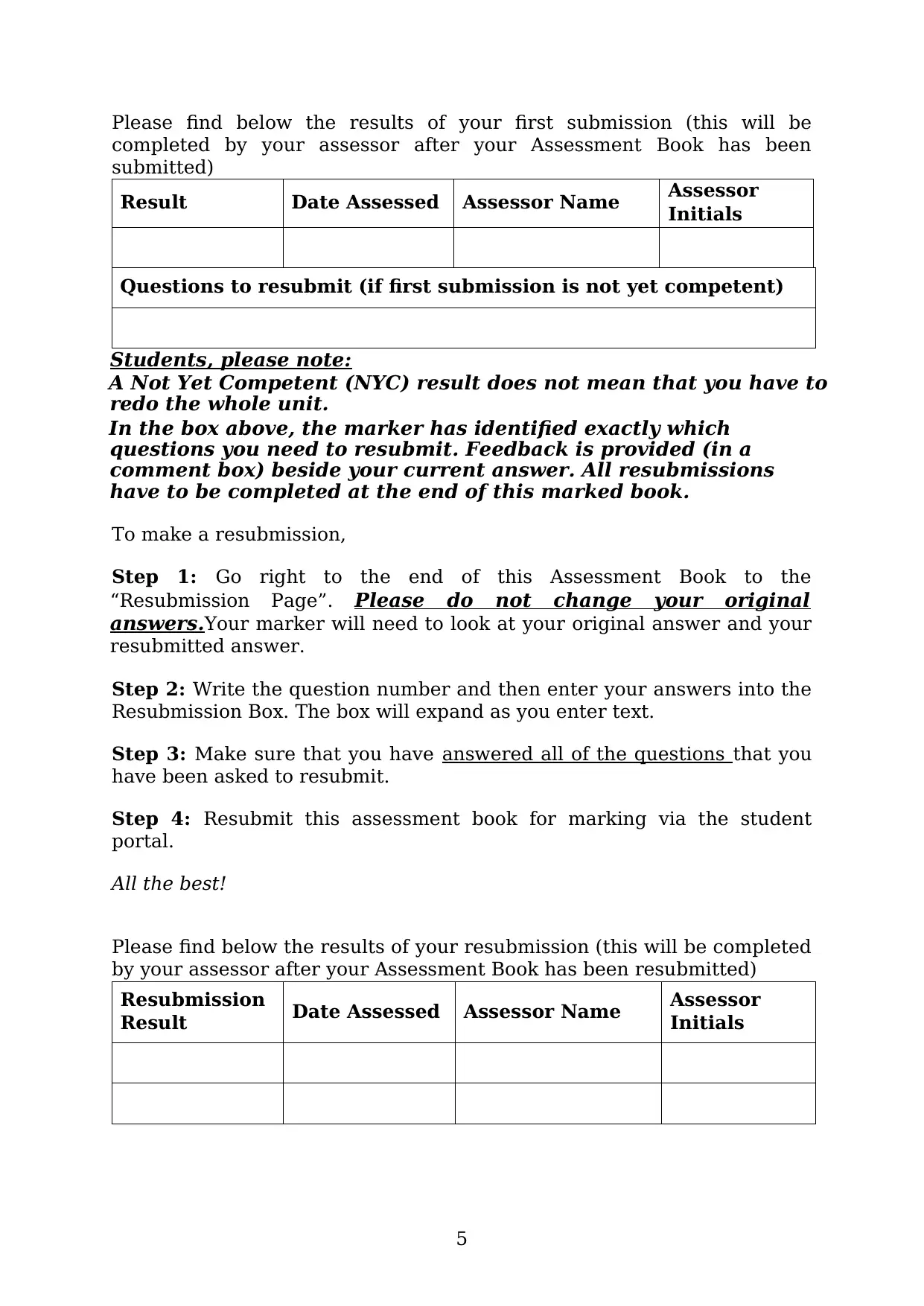
Please find below the results of your first submission (this will be
completed by your assessor after your Assessment Book has been
submitted)
Result Date Assessed Assessor Name Assessor
Initials
Questions to resubmit (if first submission is not yet competent)
Students, please note:
A Not Yet Competent (NYC) result does not mean that you have to
redo the whole unit.
In the box above, the marker has identified exactly which
questions you need to resubmit. Feedback is provided (in a
comment box) beside your current answer. All resubmissions
have to be completed at the end of this marked book.
To make a resubmission,
Step 1: Go right to the end of this Assessment Book to the
“Resubmission Page”. Please do not change your original
answers.Your marker will need to look at your original answer and your
resubmitted answer.
Step 2: Write the question number and then enter your answers into the
Resubmission Box. The box will expand as you enter text.
Step 3: Make sure that you have answered all of the questions that you
have been asked to resubmit.
Step 4: Resubmit this assessment book for marking via the student
portal.
All the best!
Please find below the results of your resubmission (this will be completed
by your assessor after your Assessment Book has been resubmitted)
Resubmission
Result Date Assessed Assessor Name Assessor
Initials
5
completed by your assessor after your Assessment Book has been
submitted)
Result Date Assessed Assessor Name Assessor
Initials
Questions to resubmit (if first submission is not yet competent)
Students, please note:
A Not Yet Competent (NYC) result does not mean that you have to
redo the whole unit.
In the box above, the marker has identified exactly which
questions you need to resubmit. Feedback is provided (in a
comment box) beside your current answer. All resubmissions
have to be completed at the end of this marked book.
To make a resubmission,
Step 1: Go right to the end of this Assessment Book to the
“Resubmission Page”. Please do not change your original
answers.Your marker will need to look at your original answer and your
resubmitted answer.
Step 2: Write the question number and then enter your answers into the
Resubmission Box. The box will expand as you enter text.
Step 3: Make sure that you have answered all of the questions that you
have been asked to resubmit.
Step 4: Resubmit this assessment book for marking via the student
portal.
All the best!
Please find below the results of your resubmission (this will be completed
by your assessor after your Assessment Book has been resubmitted)
Resubmission
Result Date Assessed Assessor Name Assessor
Initials
5
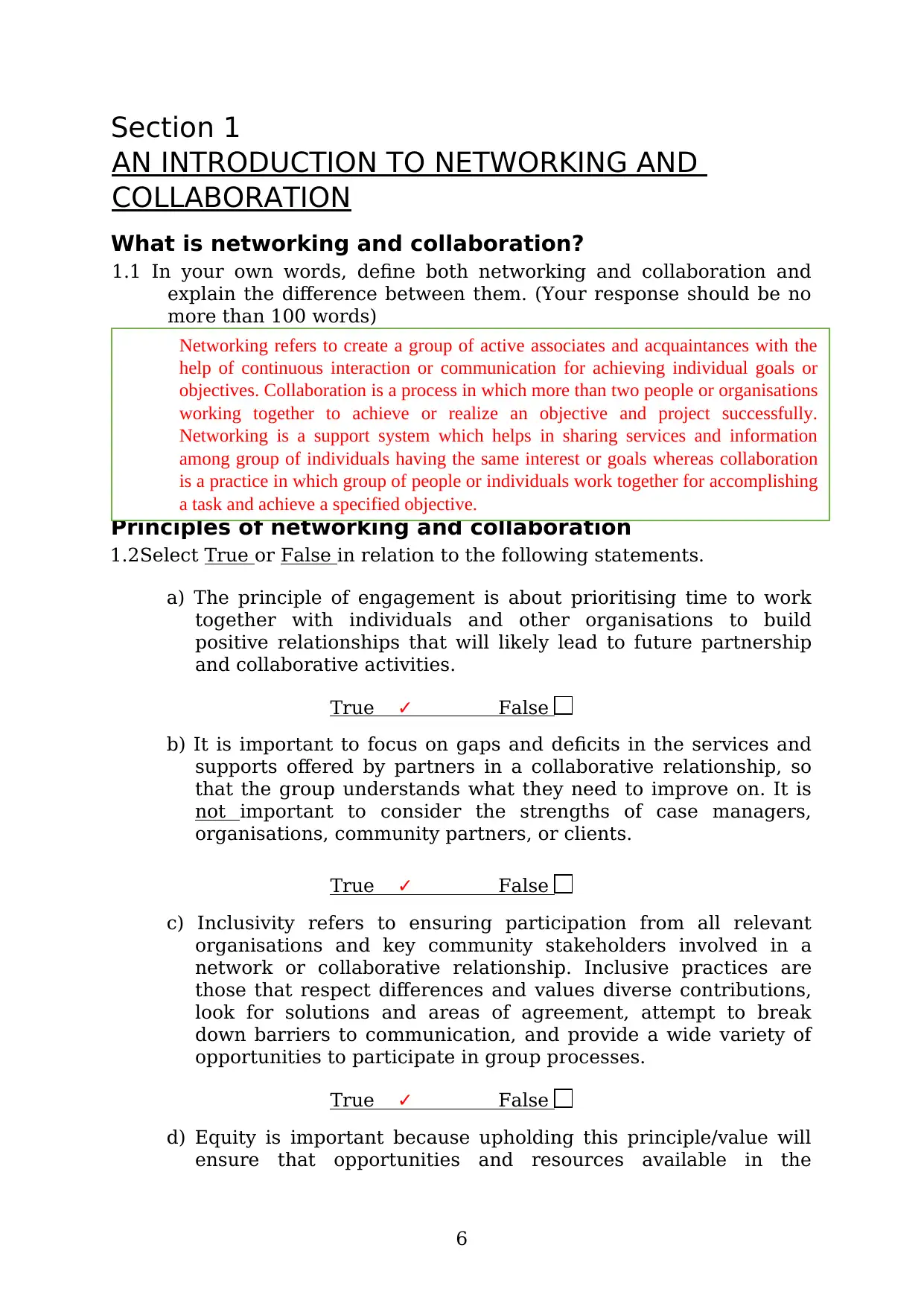
Section 1
AN INTRODUCTION TO NETWORKING AND
COLLABORATION
What is networking and collaboration?
1.1 In your own words, define both networking and collaboration and
explain the difference between them. (Your response should be no
more than 100 words)
Principles of networking and collaboration
1.2Select True or False in relation to the following statements.
a) The principle of engagement is about prioritising time to work
together with individuals and other organisations to build
positive relationships that will likely lead to future partnership
and collaborative activities.
True ✓ False
b) It is important to focus on gaps and deficits in the services and
supports offered by partners in a collaborative relationship, so
that the group understands what they need to improve on. It is
not important to consider the strengths of case managers,
organisations, community partners, or clients.
True ✓ False
c) Inclusivity refers to ensuring participation from all relevant
organisations and key community stakeholders involved in a
network or collaborative relationship. Inclusive practices are
those that respect differences and values diverse contributions,
look for solutions and areas of agreement, attempt to break
down barriers to communication, and provide a wide variety of
opportunities to participate in group processes.
True ✓ False
d) Equity is important because upholding this principle/value will
ensure that opportunities and resources available in the
6
Networking refers to create a group of active associates and acquaintances with the
help of continuous interaction or communication for achieving individual goals or
objectives. Collaboration is a process in which more than two people or organisations
working together to achieve or realize an objective and project successfully.
Networking is a support system which helps in sharing services and information
among group of individuals having the same interest or goals whereas collaboration
is a practice in which group of people or individuals work together for accomplishing
a task and achieve a specified objective.
AN INTRODUCTION TO NETWORKING AND
COLLABORATION
What is networking and collaboration?
1.1 In your own words, define both networking and collaboration and
explain the difference between them. (Your response should be no
more than 100 words)
Principles of networking and collaboration
1.2Select True or False in relation to the following statements.
a) The principle of engagement is about prioritising time to work
together with individuals and other organisations to build
positive relationships that will likely lead to future partnership
and collaborative activities.
True ✓ False
b) It is important to focus on gaps and deficits in the services and
supports offered by partners in a collaborative relationship, so
that the group understands what they need to improve on. It is
not important to consider the strengths of case managers,
organisations, community partners, or clients.
True ✓ False
c) Inclusivity refers to ensuring participation from all relevant
organisations and key community stakeholders involved in a
network or collaborative relationship. Inclusive practices are
those that respect differences and values diverse contributions,
look for solutions and areas of agreement, attempt to break
down barriers to communication, and provide a wide variety of
opportunities to participate in group processes.
True ✓ False
d) Equity is important because upholding this principle/value will
ensure that opportunities and resources available in the
6
Networking refers to create a group of active associates and acquaintances with the
help of continuous interaction or communication for achieving individual goals or
objectives. Collaboration is a process in which more than two people or organisations
working together to achieve or realize an objective and project successfully.
Networking is a support system which helps in sharing services and information
among group of individuals having the same interest or goals whereas collaboration
is a practice in which group of people or individuals work together for accomplishing
a task and achieve a specified objective.
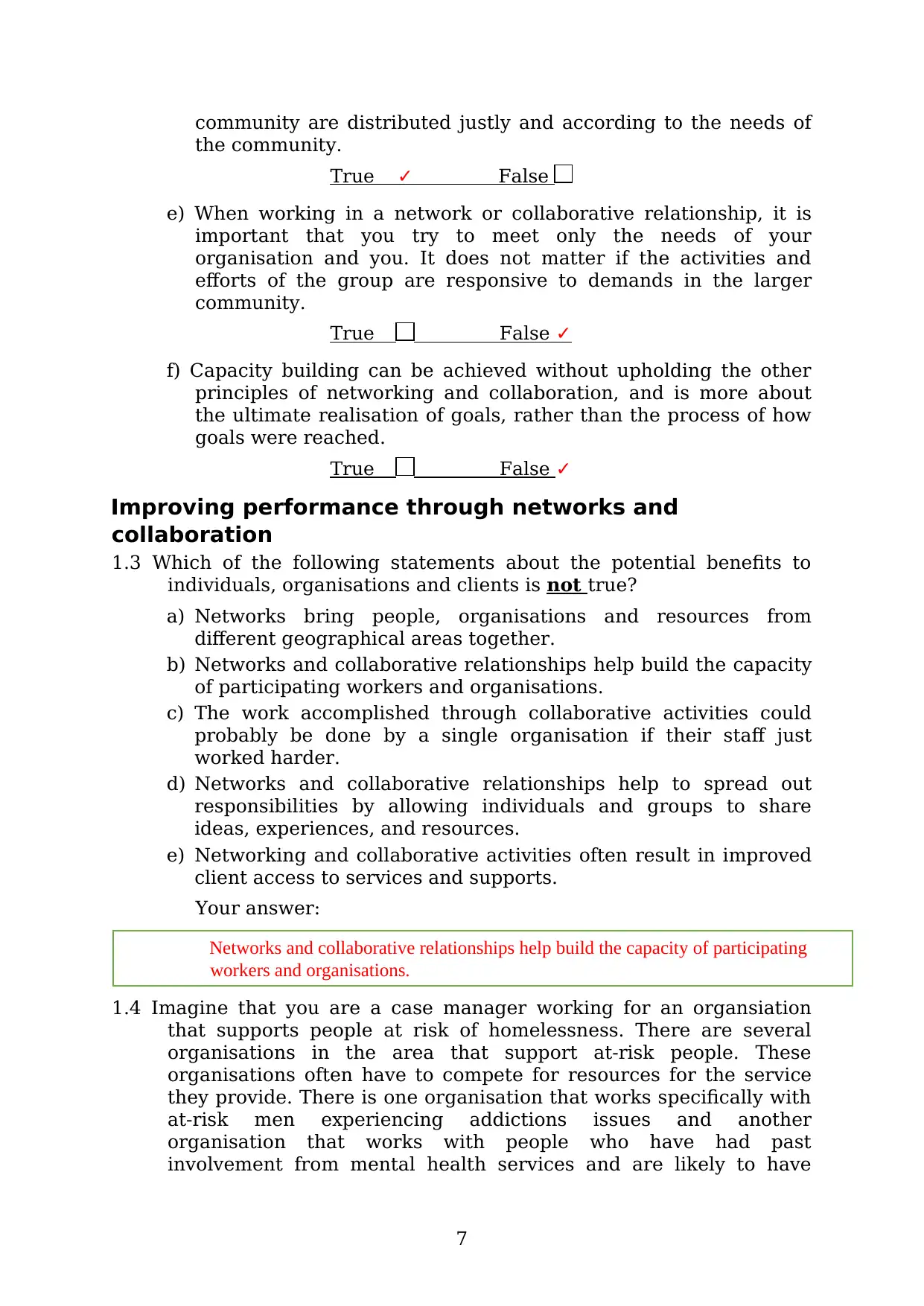
community are distributed justly and according to the needs of
the community.
True ✓ False
e) When working in a network or collaborative relationship, it is
important that you try to meet only the needs of your
organisation and you. It does not matter if the activities and
efforts of the group are responsive to demands in the larger
community.
True False ✓
f) Capacity building can be achieved without upholding the other
principles of networking and collaboration, and is more about
the ultimate realisation of goals, rather than the process of how
goals were reached.
True False ✓
Improving performance through networks and
collaboration
1.3 Which of the following statements about the potential benefits to
individuals, organisations and clients is not true?
a) Networks bring people, organisations and resources from
different geographical areas together.
b) Networks and collaborative relationships help build the capacity
of participating workers and organisations.
c) The work accomplished through collaborative activities could
probably be done by a single organisation if their staff just
worked harder.
d) Networks and collaborative relationships help to spread out
responsibilities by allowing individuals and groups to share
ideas, experiences, and resources.
e) Networking and collaborative activities often result in improved
client access to services and supports.
Your answer:
1.4 Imagine that you are a case manager working for an organsiation
that supports people at risk of homelessness. There are several
organisations in the area that support at-risk people. These
organisations often have to compete for resources for the service
they provide. There is one organisation that works specifically with
at-risk men experiencing addictions issues and another
organisation that works with people who have had past
involvement from mental health services and are likely to have
7
Networks and collaborative relationships help build the capacity of participating
workers and organisations.
the community.
True ✓ False
e) When working in a network or collaborative relationship, it is
important that you try to meet only the needs of your
organisation and you. It does not matter if the activities and
efforts of the group are responsive to demands in the larger
community.
True False ✓
f) Capacity building can be achieved without upholding the other
principles of networking and collaboration, and is more about
the ultimate realisation of goals, rather than the process of how
goals were reached.
True False ✓
Improving performance through networks and
collaboration
1.3 Which of the following statements about the potential benefits to
individuals, organisations and clients is not true?
a) Networks bring people, organisations and resources from
different geographical areas together.
b) Networks and collaborative relationships help build the capacity
of participating workers and organisations.
c) The work accomplished through collaborative activities could
probably be done by a single organisation if their staff just
worked harder.
d) Networks and collaborative relationships help to spread out
responsibilities by allowing individuals and groups to share
ideas, experiences, and resources.
e) Networking and collaborative activities often result in improved
client access to services and supports.
Your answer:
1.4 Imagine that you are a case manager working for an organsiation
that supports people at risk of homelessness. There are several
organisations in the area that support at-risk people. These
organisations often have to compete for resources for the service
they provide. There is one organisation that works specifically with
at-risk men experiencing addictions issues and another
organisation that works with people who have had past
involvement from mental health services and are likely to have
7
Networks and collaborative relationships help build the capacity of participating
workers and organisations.
Paraphrase This Document
Need a fresh take? Get an instant paraphrase of this document with our AI Paraphraser
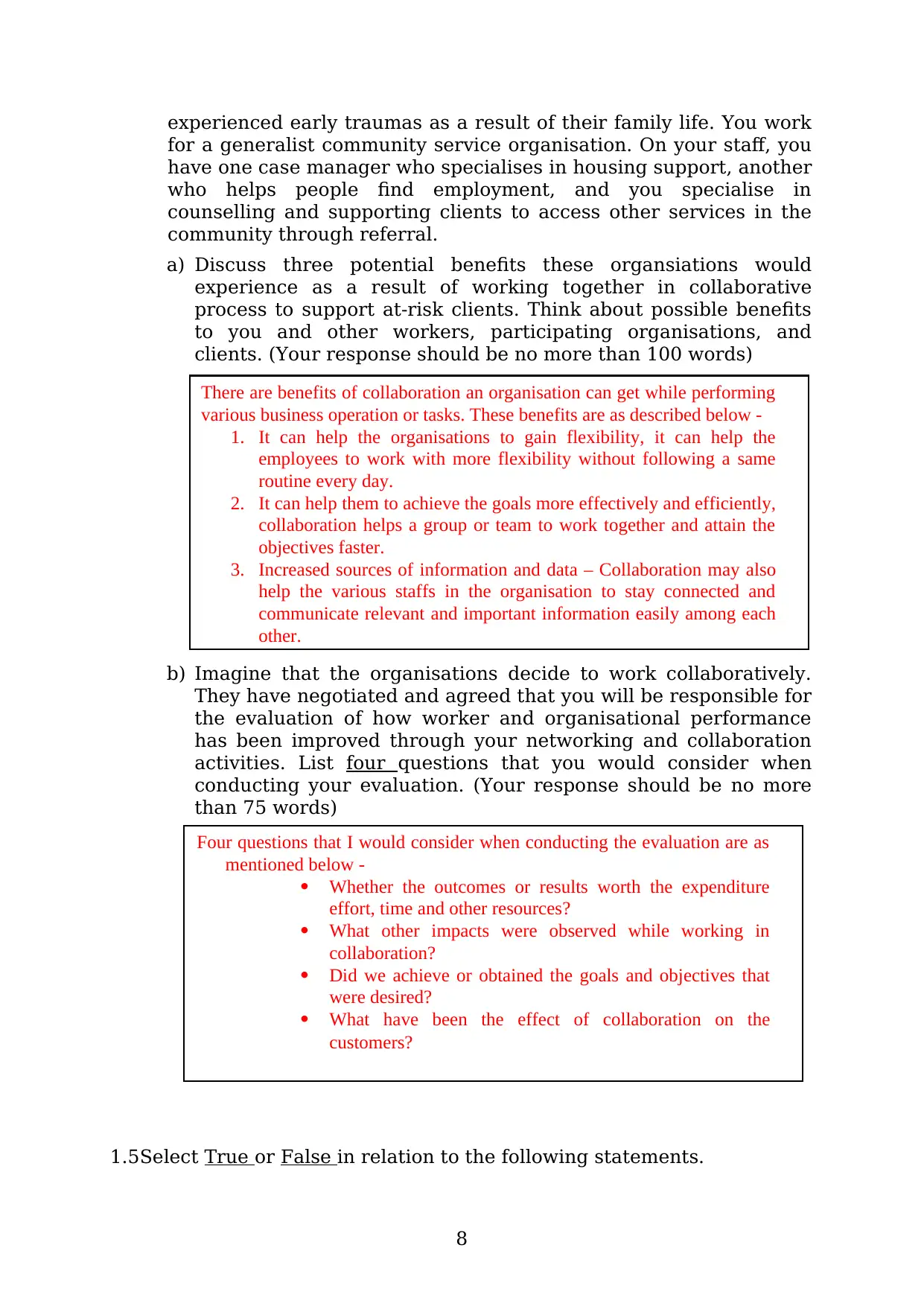
experienced early traumas as a result of their family life. You work
for a generalist community service organisation. On your staff, you
have one case manager who specialises in housing support, another
who helps people find employment, and you specialise in
counselling and supporting clients to access other services in the
community through referral.
a) Discuss three potential benefits these organsiations would
experience as a result of working together in collaborative
process to support at-risk clients. Think about possible benefits
to you and other workers, participating organisations, and
clients. (Your response should be no more than 100 words)
b) Imagine that the organisations decide to work collaboratively.
They have negotiated and agreed that you will be responsible for
the evaluation of how worker and organisational performance
has been improved through your networking and collaboration
activities. List four questions that you would consider when
conducting your evaluation. (Your response should be no more
than 75 words)
1.5Select True or False in relation to the following statements.
8
There are benefits of collaboration an organisation can get while performing
various business operation or tasks. These benefits are as described below -
1. It can help the organisations to gain flexibility, it can help the
employees to work with more flexibility without following a same
routine every day.
2. It can help them to achieve the goals more effectively and efficiently,
collaboration helps a group or team to work together and attain the
objectives faster.
3. Increased sources of information and data – Collaboration may also
help the various staffs in the organisation to stay connected and
communicate relevant and important information easily among each
other.
Four questions that I would consider when conducting the evaluation are as
mentioned below -
Whether the outcomes or results worth the expenditure
effort, time and other resources?
What other impacts were observed while working in
collaboration?
Did we achieve or obtained the goals and objectives that
were desired?
What have been the effect of collaboration on the
customers?
for a generalist community service organisation. On your staff, you
have one case manager who specialises in housing support, another
who helps people find employment, and you specialise in
counselling and supporting clients to access other services in the
community through referral.
a) Discuss three potential benefits these organsiations would
experience as a result of working together in collaborative
process to support at-risk clients. Think about possible benefits
to you and other workers, participating organisations, and
clients. (Your response should be no more than 100 words)
b) Imagine that the organisations decide to work collaboratively.
They have negotiated and agreed that you will be responsible for
the evaluation of how worker and organisational performance
has been improved through your networking and collaboration
activities. List four questions that you would consider when
conducting your evaluation. (Your response should be no more
than 75 words)
1.5Select True or False in relation to the following statements.
8
There are benefits of collaboration an organisation can get while performing
various business operation or tasks. These benefits are as described below -
1. It can help the organisations to gain flexibility, it can help the
employees to work with more flexibility without following a same
routine every day.
2. It can help them to achieve the goals more effectively and efficiently,
collaboration helps a group or team to work together and attain the
objectives faster.
3. Increased sources of information and data – Collaboration may also
help the various staffs in the organisation to stay connected and
communicate relevant and important information easily among each
other.
Four questions that I would consider when conducting the evaluation are as
mentioned below -
Whether the outcomes or results worth the expenditure
effort, time and other resources?
What other impacts were observed while working in
collaboration?
Did we achieve or obtained the goals and objectives that
were desired?
What have been the effect of collaboration on the
customers?
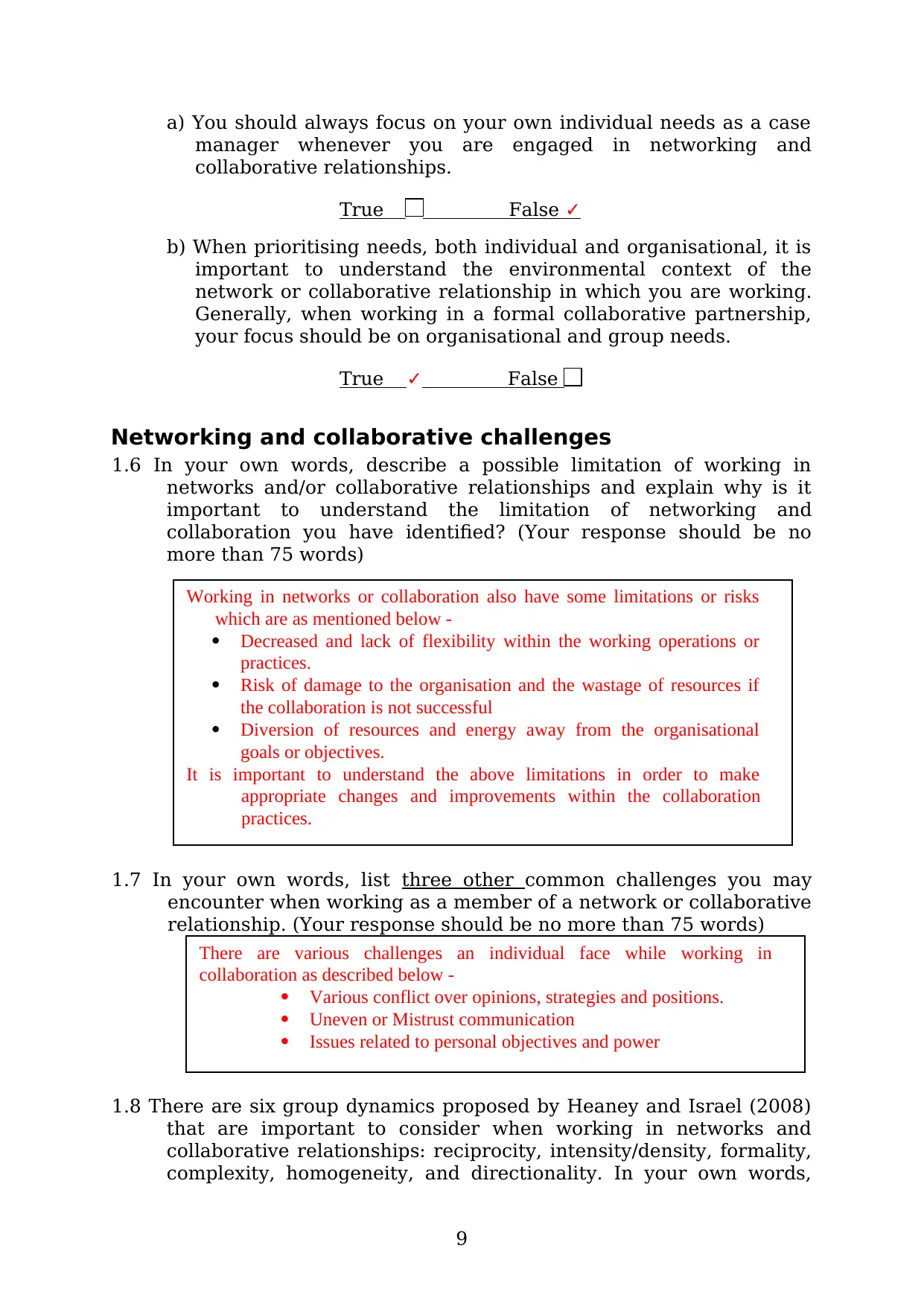
a) You should always focus on your own individual needs as a case
manager whenever you are engaged in networking and
collaborative relationships.
True False ✓
b) When prioritising needs, both individual and organisational, it is
important to understand the environmental context of the
network or collaborative relationship in which you are working.
Generally, when working in a formal collaborative partnership,
your focus should be on organisational and group needs.
True ✓ False
Networking and collaborative challenges
1.6 In your own words, describe a possible limitation of working in
networks and/or collaborative relationships and explain why is it
important to understand the limitation of networking and
collaboration you have identified? (Your response should be no
more than 75 words)
1.7 In your own words, list three other common challenges you may
encounter when working as a member of a network or collaborative
relationship. (Your response should be no more than 75 words)
1.8 There are six group dynamics proposed by Heaney and Israel (2008)
that are important to consider when working in networks and
collaborative relationships: reciprocity, intensity/density, formality,
complexity, homogeneity, and directionality. In your own words,
9
Working in networks or collaboration also have some limitations or risks
which are as mentioned below -
Decreased and lack of flexibility within the working operations or
practices.
Risk of damage to the organisation and the wastage of resources if
the collaboration is not successful
Diversion of resources and energy away from the organisational
goals or objectives.
It is important to understand the above limitations in order to make
appropriate changes and improvements within the collaboration
practices.
There are various challenges an individual face while working in
collaboration as described below -
Various conflict over opinions, strategies and positions.
Uneven or Mistrust communication
Issues related to personal objectives and power
manager whenever you are engaged in networking and
collaborative relationships.
True False ✓
b) When prioritising needs, both individual and organisational, it is
important to understand the environmental context of the
network or collaborative relationship in which you are working.
Generally, when working in a formal collaborative partnership,
your focus should be on organisational and group needs.
True ✓ False
Networking and collaborative challenges
1.6 In your own words, describe a possible limitation of working in
networks and/or collaborative relationships and explain why is it
important to understand the limitation of networking and
collaboration you have identified? (Your response should be no
more than 75 words)
1.7 In your own words, list three other common challenges you may
encounter when working as a member of a network or collaborative
relationship. (Your response should be no more than 75 words)
1.8 There are six group dynamics proposed by Heaney and Israel (2008)
that are important to consider when working in networks and
collaborative relationships: reciprocity, intensity/density, formality,
complexity, homogeneity, and directionality. In your own words,
9
Working in networks or collaboration also have some limitations or risks
which are as mentioned below -
Decreased and lack of flexibility within the working operations or
practices.
Risk of damage to the organisation and the wastage of resources if
the collaboration is not successful
Diversion of resources and energy away from the organisational
goals or objectives.
It is important to understand the above limitations in order to make
appropriate changes and improvements within the collaboration
practices.
There are various challenges an individual face while working in
collaboration as described below -
Various conflict over opinions, strategies and positions.
Uneven or Mistrust communication
Issues related to personal objectives and power
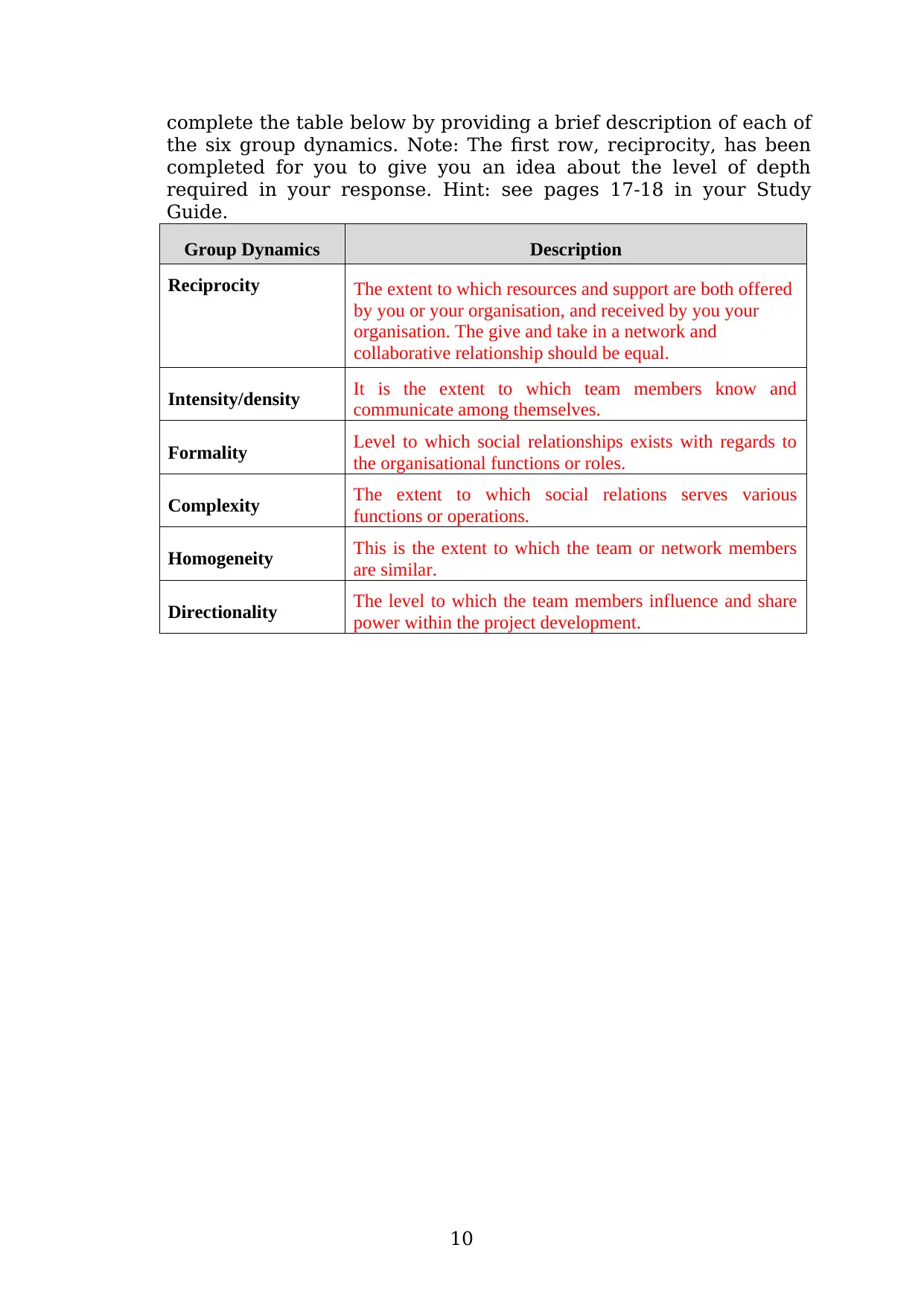
complete the table below by providing a brief description of each of
the six group dynamics. Note: The first row, reciprocity, has been
completed for you to give you an idea about the level of depth
required in your response. Hint: see pages 17-18 in your Study
Guide.
Group Dynamics Description
Reciprocity The extent to which resources and support are both offered
by you or your organisation, and received by you your
organisation. The give and take in a network and
collaborative relationship should be equal.
Intensity/density It is the extent to which team members know and
communicate among themselves.
Formality Level to which social relationships exists with regards to
the organisational functions or roles.
Complexity The extent to which social relations serves various
functions or operations.
Homogeneity This is the extent to which the team or network members
are similar.
Directionality The level to which the team members influence and share
power within the project development.
10
the six group dynamics. Note: The first row, reciprocity, has been
completed for you to give you an idea about the level of depth
required in your response. Hint: see pages 17-18 in your Study
Guide.
Group Dynamics Description
Reciprocity The extent to which resources and support are both offered
by you or your organisation, and received by you your
organisation. The give and take in a network and
collaborative relationship should be equal.
Intensity/density It is the extent to which team members know and
communicate among themselves.
Formality Level to which social relationships exists with regards to
the organisational functions or roles.
Complexity The extent to which social relations serves various
functions or operations.
Homogeneity This is the extent to which the team or network members
are similar.
Directionality The level to which the team members influence and share
power within the project development.
10
Secure Best Marks with AI Grader
Need help grading? Try our AI Grader for instant feedback on your assignments.
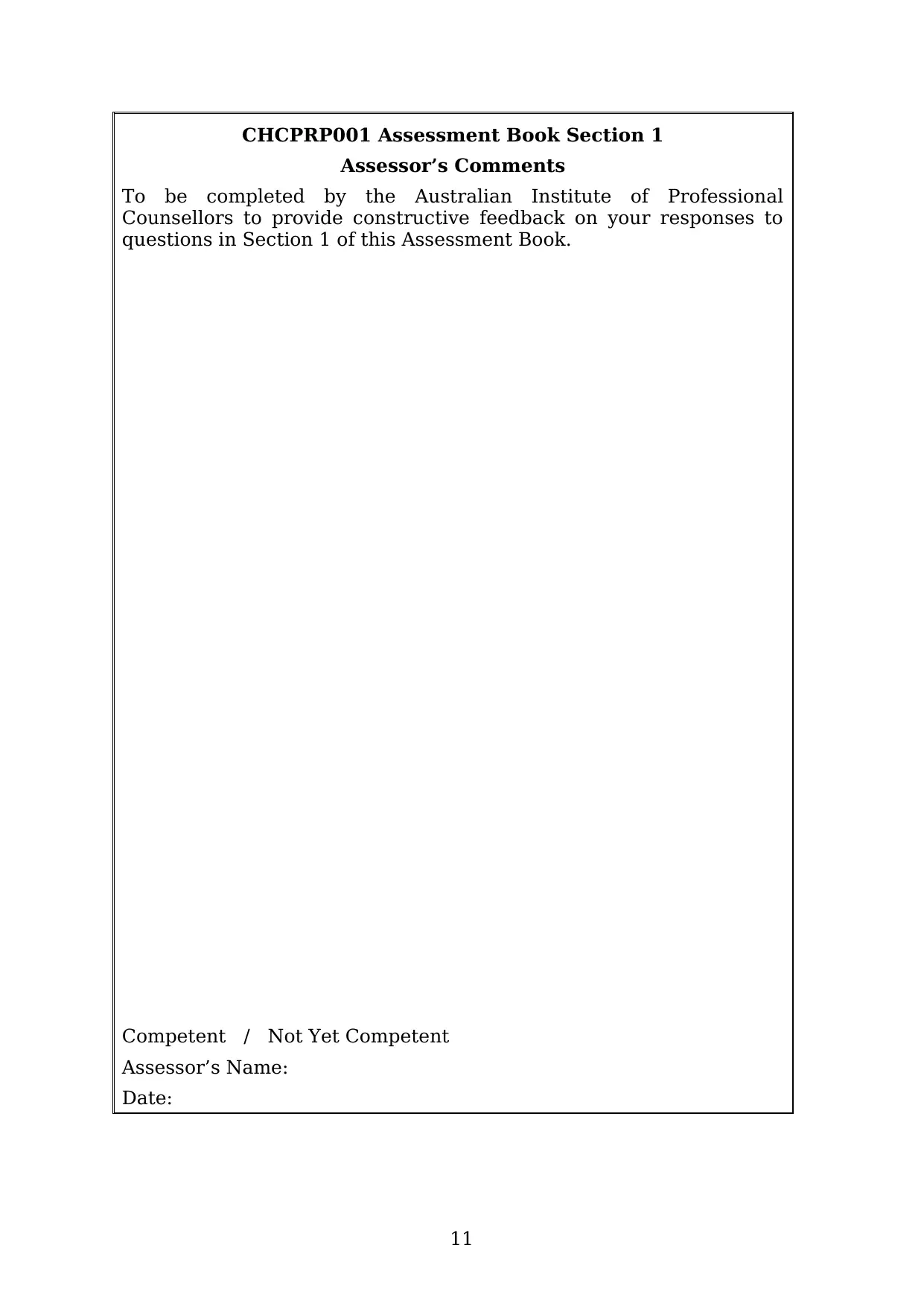
CHCPRP001 Assessment Book Section 1
Assessor’s Comments
To be completed by the Australian Institute of Professional
Counsellors to provide constructive feedback on your responses to
questions in Section 1 of this Assessment Book.
Competent / Not Yet Competent
Assessor’s Name:
Date:
11
Assessor’s Comments
To be completed by the Australian Institute of Professional
Counsellors to provide constructive feedback on your responses to
questions in Section 1 of this Assessment Book.
Competent / Not Yet Competent
Assessor’s Name:
Date:
11
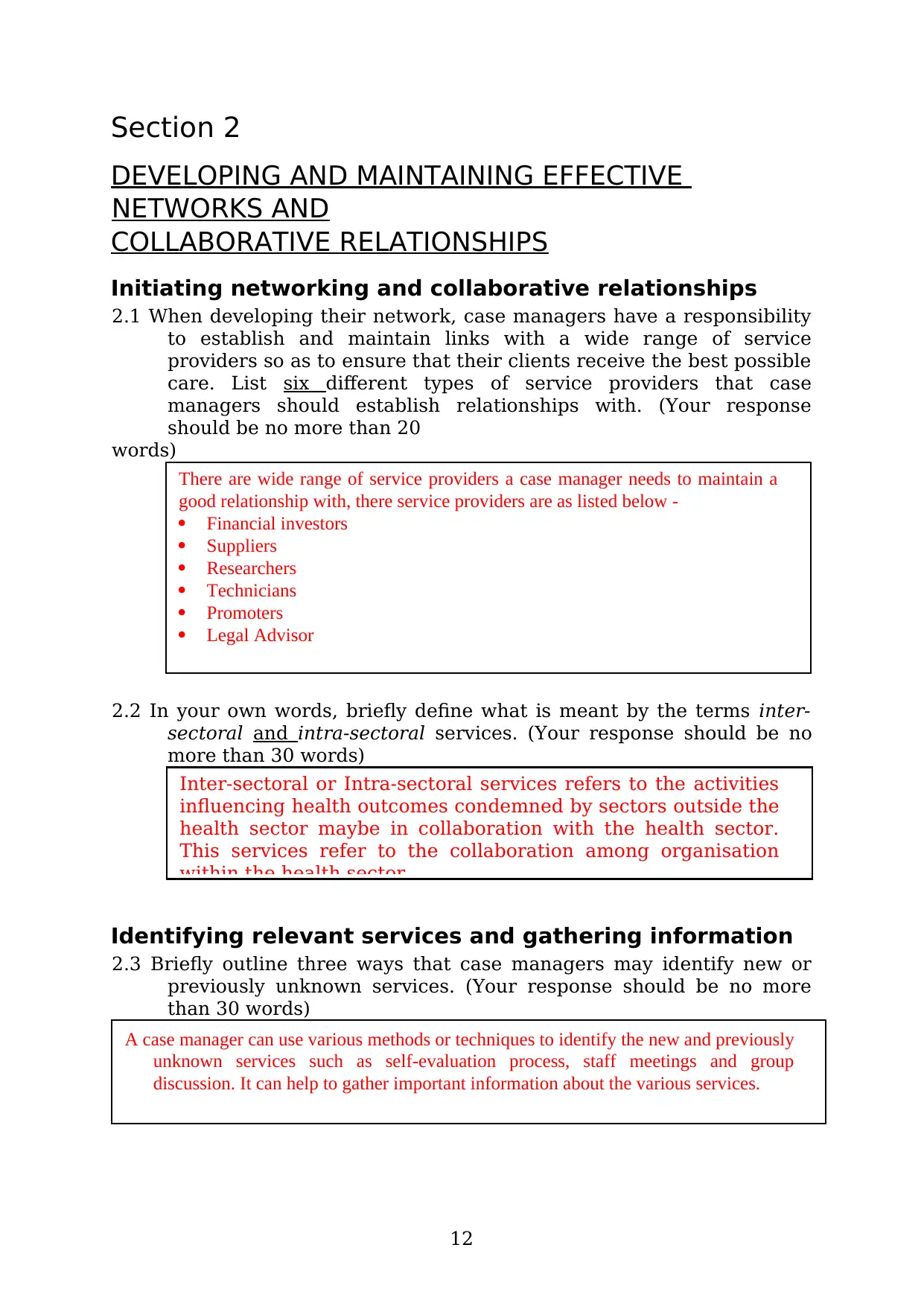
Section 2
DEVELOPING AND MAINTAINING EFFECTIVE
NETWORKS AND
COLLABORATIVE RELATIONSHIPS
Initiating networking and collaborative relationships
2.1 When developing their network, case managers have a responsibility
to establish and maintain links with a wide range of service
providers so as to ensure that their clients receive the best possible
care. List six different types of service providers that case
managers should establish relationships with. (Your response
should be no more than 20
words)
2.2 In your own words, briefly define what is meant by the terms inter-
sectoral and intra-sectoral services. (Your response should be no
more than 30 words)
Identifying relevant services and gathering information
2.3 Briefly outline three ways that case managers may identify new or
previously unknown services. (Your response should be no more
than 30 words)
12
There are wide range of service providers a case manager needs to maintain a
good relationship with, there service providers are as listed below -
Financial investors
Suppliers
Researchers
Technicians
Promoters
Legal Advisor
Inter-sectoral or Intra-sectoral services refers to the activities
influencing health outcomes condemned by sectors outside the
health sector maybe in collaboration with the health sector.
This services refer to the collaboration among organisation
within the health sector.
A case manager can use various methods or techniques to identify the new and previously
unknown services such as self-evaluation process, staff meetings and group
discussion. It can help to gather important information about the various services.
DEVELOPING AND MAINTAINING EFFECTIVE
NETWORKS AND
COLLABORATIVE RELATIONSHIPS
Initiating networking and collaborative relationships
2.1 When developing their network, case managers have a responsibility
to establish and maintain links with a wide range of service
providers so as to ensure that their clients receive the best possible
care. List six different types of service providers that case
managers should establish relationships with. (Your response
should be no more than 20
words)
2.2 In your own words, briefly define what is meant by the terms inter-
sectoral and intra-sectoral services. (Your response should be no
more than 30 words)
Identifying relevant services and gathering information
2.3 Briefly outline three ways that case managers may identify new or
previously unknown services. (Your response should be no more
than 30 words)
12
There are wide range of service providers a case manager needs to maintain a
good relationship with, there service providers are as listed below -
Financial investors
Suppliers
Researchers
Technicians
Promoters
Legal Advisor
Inter-sectoral or Intra-sectoral services refers to the activities
influencing health outcomes condemned by sectors outside the
health sector maybe in collaboration with the health sector.
This services refer to the collaboration among organisation
within the health sector.
A case manager can use various methods or techniques to identify the new and previously
unknown services such as self-evaluation process, staff meetings and group
discussion. It can help to gather important information about the various services.
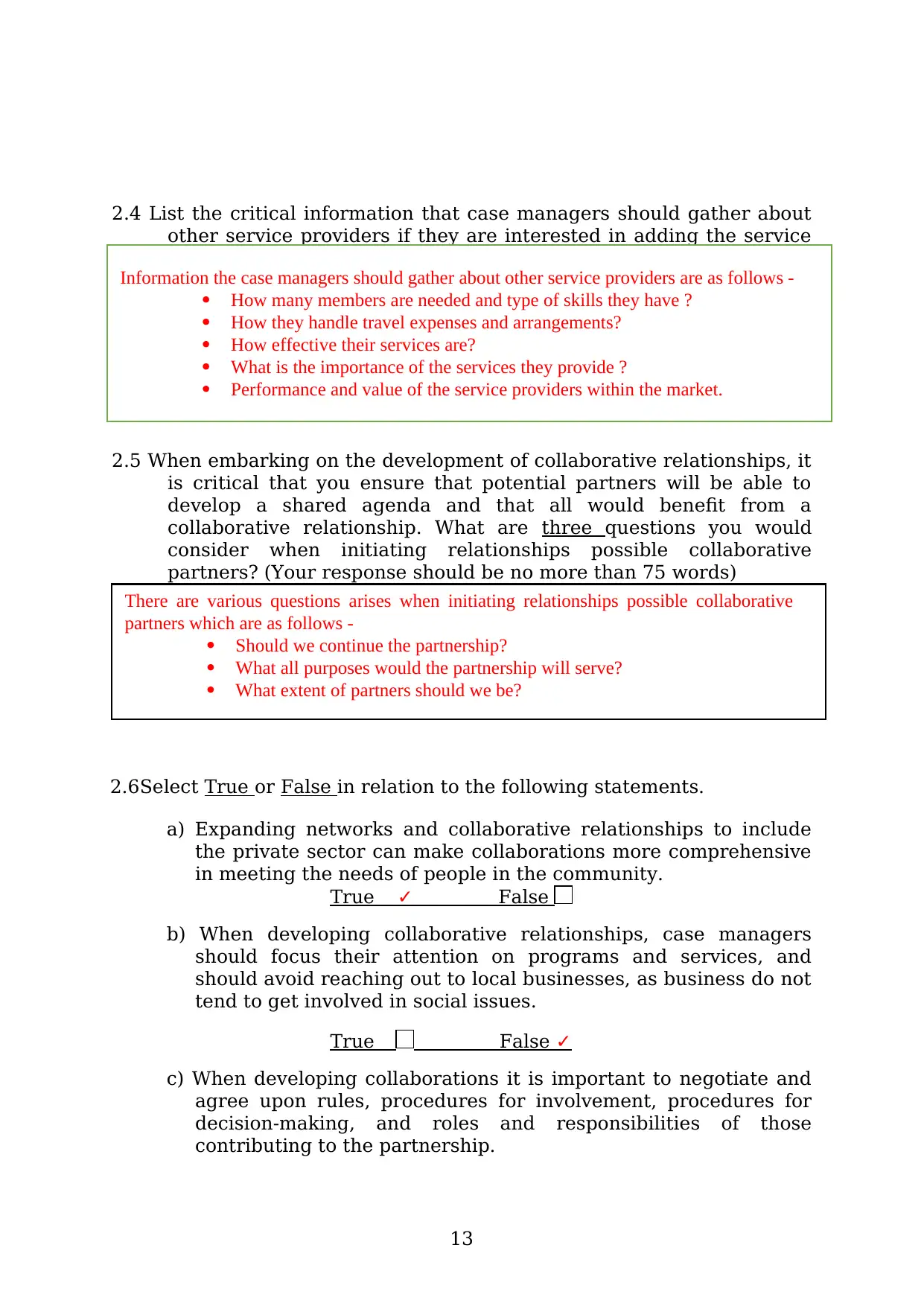
2.4 List the critical information that case managers should gather about
other service providers if they are interested in adding the service
to their referral network. Hint: see page 23 of your Study Guide.
(Your response should be no more than 75 words)
2.5 When embarking on the development of collaborative relationships, it
is critical that you ensure that potential partners will be able to
develop a shared agenda and that all would benefit from a
collaborative relationship. What are three questions you would
consider when initiating relationships possible collaborative
partners? (Your response should be no more than 75 words)
2.6Select True or False in relation to the following statements.
a) Expanding networks and collaborative relationships to include
the private sector can make collaborations more comprehensive
in meeting the needs of people in the community.
True ✓ False
b) When developing collaborative relationships, case managers
should focus their attention on programs and services, and
should avoid reaching out to local businesses, as business do not
tend to get involved in social issues.
True False ✓
c) When developing collaborations it is important to negotiate and
agree upon rules, procedures for involvement, procedures for
decision-making, and roles and responsibilities of those
contributing to the partnership.
13
There are various questions arises when initiating relationships possible collaborative
partners which are as follows -
Should we continue the partnership?
What all purposes would the partnership will serve?
What extent of partners should we be?
Information the case managers should gather about other service providers are as follows -
How many members are needed and type of skills they have ?
How they handle travel expenses and arrangements?
How effective their services are?
What is the importance of the services they provide ?
Performance and value of the service providers within the market.
other service providers if they are interested in adding the service
to their referral network. Hint: see page 23 of your Study Guide.
(Your response should be no more than 75 words)
2.5 When embarking on the development of collaborative relationships, it
is critical that you ensure that potential partners will be able to
develop a shared agenda and that all would benefit from a
collaborative relationship. What are three questions you would
consider when initiating relationships possible collaborative
partners? (Your response should be no more than 75 words)
2.6Select True or False in relation to the following statements.
a) Expanding networks and collaborative relationships to include
the private sector can make collaborations more comprehensive
in meeting the needs of people in the community.
True ✓ False
b) When developing collaborative relationships, case managers
should focus their attention on programs and services, and
should avoid reaching out to local businesses, as business do not
tend to get involved in social issues.
True False ✓
c) When developing collaborations it is important to negotiate and
agree upon rules, procedures for involvement, procedures for
decision-making, and roles and responsibilities of those
contributing to the partnership.
13
There are various questions arises when initiating relationships possible collaborative
partners which are as follows -
Should we continue the partnership?
What all purposes would the partnership will serve?
What extent of partners should we be?
Information the case managers should gather about other service providers are as follows -
How many members are needed and type of skills they have ?
How they handle travel expenses and arrangements?
How effective their services are?
What is the importance of the services they provide ?
Performance and value of the service providers within the market.
Paraphrase This Document
Need a fresh take? Get an instant paraphrase of this document with our AI Paraphraser
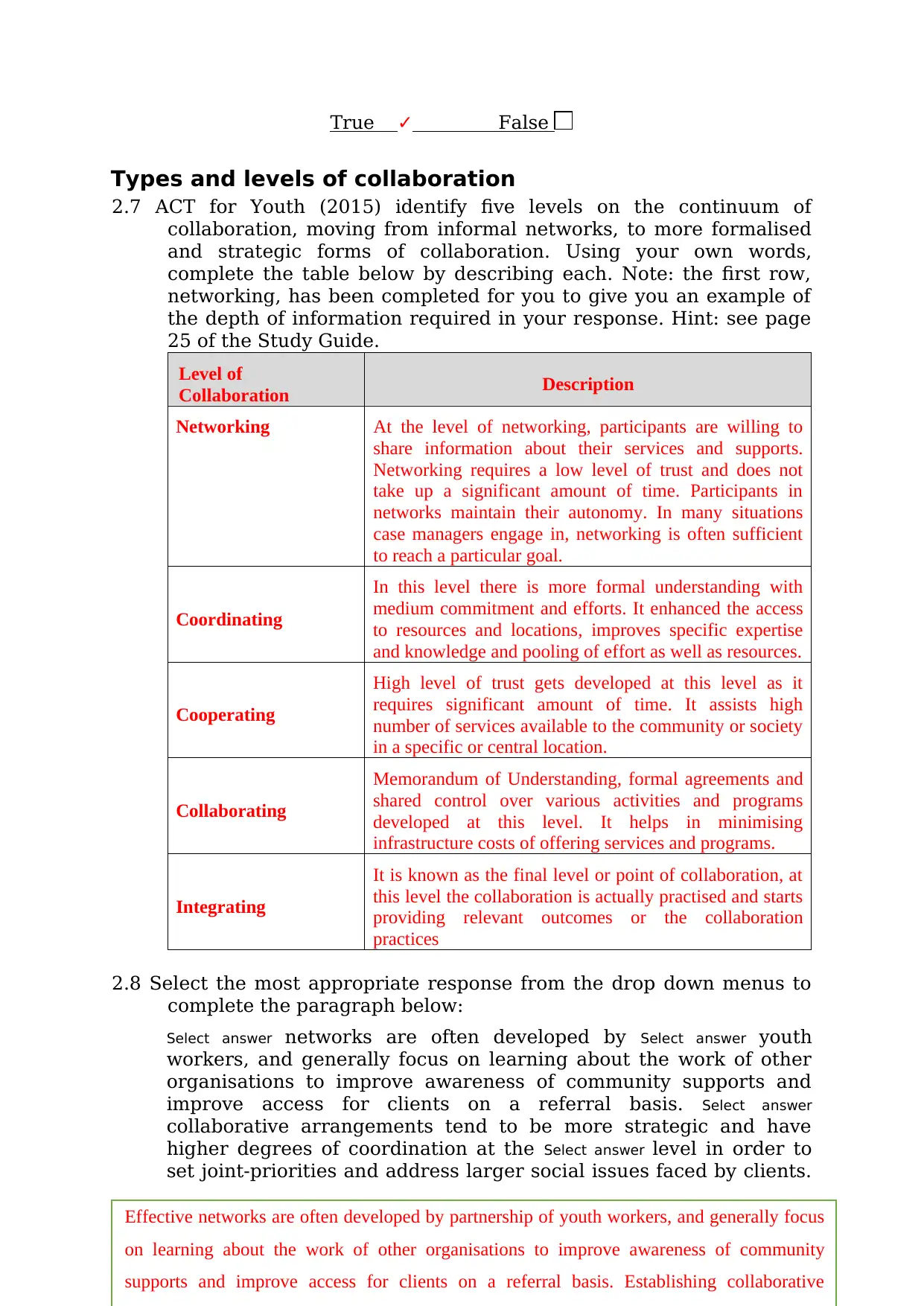
True ✓ False
Types and levels of collaboration
2.7 ACT for Youth (2015) identify five levels on the continuum of
collaboration, moving from informal networks, to more formalised
and strategic forms of collaboration. Using your own words,
complete the table below by describing each. Note: the first row,
networking, has been completed for you to give you an example of
the depth of information required in your response. Hint: see page
25 of the Study Guide.
Level of
Collaboration Description
Networking At the level of networking, participants are willing to
share information about their services and supports.
Networking requires a low level of trust and does not
take up a significant amount of time. Participants in
networks maintain their autonomy. In many situations
case managers engage in, networking is often sufficient
to reach a particular goal.
Coordinating
In this level there is more formal understanding with
medium commitment and efforts. It enhanced the access
to resources and locations, improves specific expertise
and knowledge and pooling of effort as well as resources.
Cooperating
High level of trust gets developed at this level as it
requires significant amount of time. It assists high
number of services available to the community or society
in a specific or central location.
Collaborating
Memorandum of Understanding, formal agreements and
shared control over various activities and programs
developed at this level. It helps in minimising
infrastructure costs of offering services and programs.
Integrating
It is known as the final level or point of collaboration, at
this level the collaboration is actually practised and starts
providing relevant outcomes or the collaboration
practices
2.8 Select the most appropriate response from the drop down menus to
complete the paragraph below:
Select answer networks are often developed by Select answer youth
workers, and generally focus on learning about the work of other
organisations to improve awareness of community supports and
improve access for clients on a referral basis. Select answer
collaborative arrangements tend to be more strategic and have
higher degrees of coordination at the Select answer level in order to
set joint-priorities and address larger social issues faced by clients.
14
Effective networks are often developed by partnership of youth workers, and generally focus
on learning about the work of other organisations to improve awareness of community
supports and improve access for clients on a referral basis. Establishing collaborative
Types and levels of collaboration
2.7 ACT for Youth (2015) identify five levels on the continuum of
collaboration, moving from informal networks, to more formalised
and strategic forms of collaboration. Using your own words,
complete the table below by describing each. Note: the first row,
networking, has been completed for you to give you an example of
the depth of information required in your response. Hint: see page
25 of the Study Guide.
Level of
Collaboration Description
Networking At the level of networking, participants are willing to
share information about their services and supports.
Networking requires a low level of trust and does not
take up a significant amount of time. Participants in
networks maintain their autonomy. In many situations
case managers engage in, networking is often sufficient
to reach a particular goal.
Coordinating
In this level there is more formal understanding with
medium commitment and efforts. It enhanced the access
to resources and locations, improves specific expertise
and knowledge and pooling of effort as well as resources.
Cooperating
High level of trust gets developed at this level as it
requires significant amount of time. It assists high
number of services available to the community or society
in a specific or central location.
Collaborating
Memorandum of Understanding, formal agreements and
shared control over various activities and programs
developed at this level. It helps in minimising
infrastructure costs of offering services and programs.
Integrating
It is known as the final level or point of collaboration, at
this level the collaboration is actually practised and starts
providing relevant outcomes or the collaboration
practices
2.8 Select the most appropriate response from the drop down menus to
complete the paragraph below:
Select answer networks are often developed by Select answer youth
workers, and generally focus on learning about the work of other
organisations to improve awareness of community supports and
improve access for clients on a referral basis. Select answer
collaborative arrangements tend to be more strategic and have
higher degrees of coordination at the Select answer level in order to
set joint-priorities and address larger social issues faced by clients.
14
Effective networks are often developed by partnership of youth workers, and generally focus
on learning about the work of other organisations to improve awareness of community
supports and improve access for clients on a referral basis. Establishing collaborative
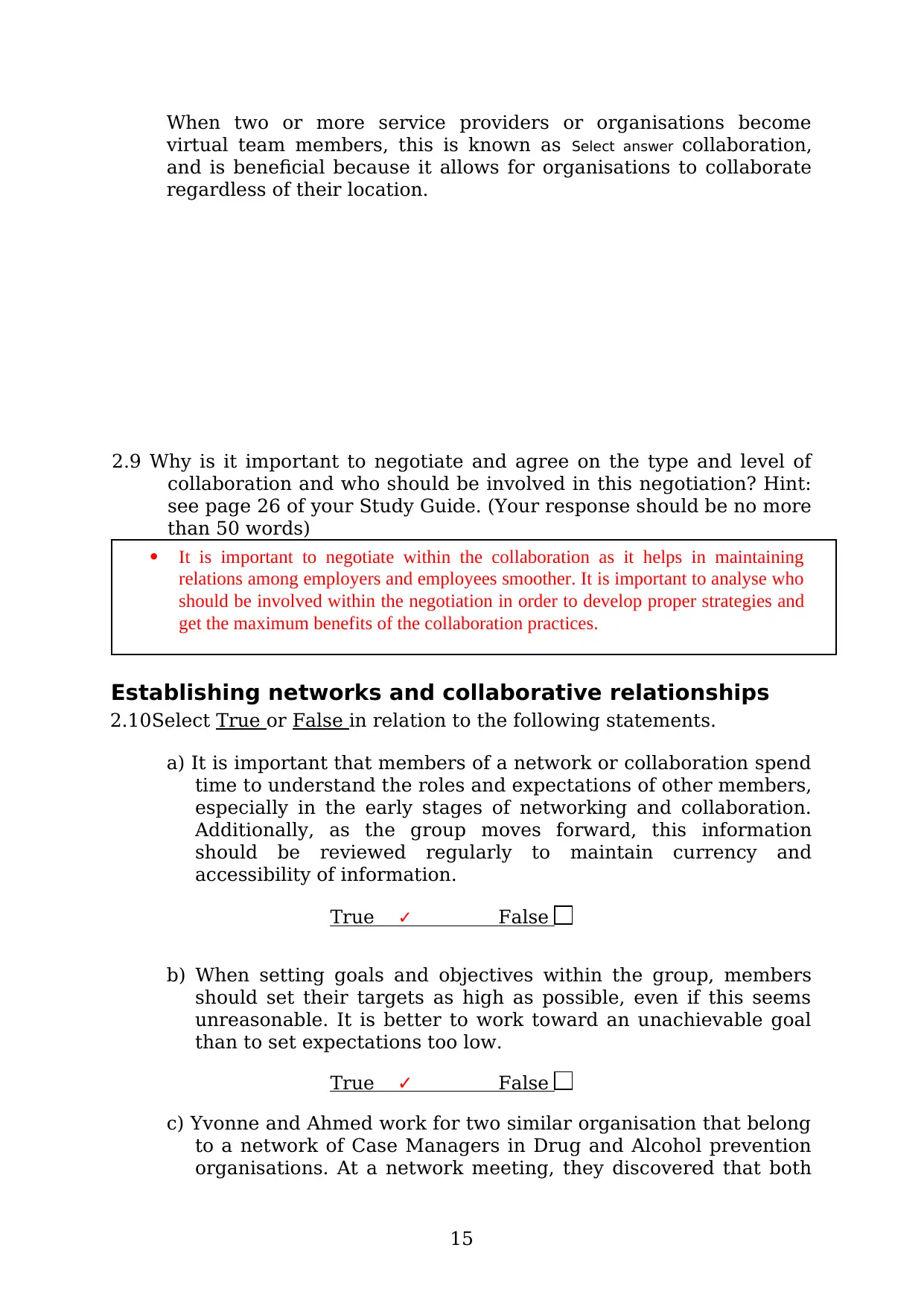
When two or more service providers or organisations become
virtual team members, this is known as Select answer collaboration,
and is beneficial because it allows for organisations to collaborate
regardless of their location.
2.9 Why is it important to negotiate and agree on the type and level of
collaboration and who should be involved in this negotiation? Hint:
see page 26 of your Study Guide. (Your response should be no more
than 50 words)
Establishing networks and collaborative relationships
2.10Select True or False in relation to the following statements.
a) It is important that members of a network or collaboration spend
time to understand the roles and expectations of other members,
especially in the early stages of networking and collaboration.
Additionally, as the group moves forward, this information
should be reviewed regularly to maintain currency and
accessibility of information.
True ✓ False
b) When setting goals and objectives within the group, members
should set their targets as high as possible, even if this seems
unreasonable. It is better to work toward an unachievable goal
than to set expectations too low.
True ✓ False
c) Yvonne and Ahmed work for two similar organisation that belong
to a network of Case Managers in Drug and Alcohol prevention
organisations. At a network meeting, they discovered that both
15
It is important to negotiate within the collaboration as it helps in maintaining
relations among employers and employees smoother. It is important to analyse who
should be involved within the negotiation in order to develop proper strategies and
get the maximum benefits of the collaboration practices.
virtual team members, this is known as Select answer collaboration,
and is beneficial because it allows for organisations to collaborate
regardless of their location.
2.9 Why is it important to negotiate and agree on the type and level of
collaboration and who should be involved in this negotiation? Hint:
see page 26 of your Study Guide. (Your response should be no more
than 50 words)
Establishing networks and collaborative relationships
2.10Select True or False in relation to the following statements.
a) It is important that members of a network or collaboration spend
time to understand the roles and expectations of other members,
especially in the early stages of networking and collaboration.
Additionally, as the group moves forward, this information
should be reviewed regularly to maintain currency and
accessibility of information.
True ✓ False
b) When setting goals and objectives within the group, members
should set their targets as high as possible, even if this seems
unreasonable. It is better to work toward an unachievable goal
than to set expectations too low.
True ✓ False
c) Yvonne and Ahmed work for two similar organisation that belong
to a network of Case Managers in Drug and Alcohol prevention
organisations. At a network meeting, they discovered that both
15
It is important to negotiate within the collaboration as it helps in maintaining
relations among employers and employees smoother. It is important to analyse who
should be involved within the negotiation in order to develop proper strategies and
get the maximum benefits of the collaboration practices.
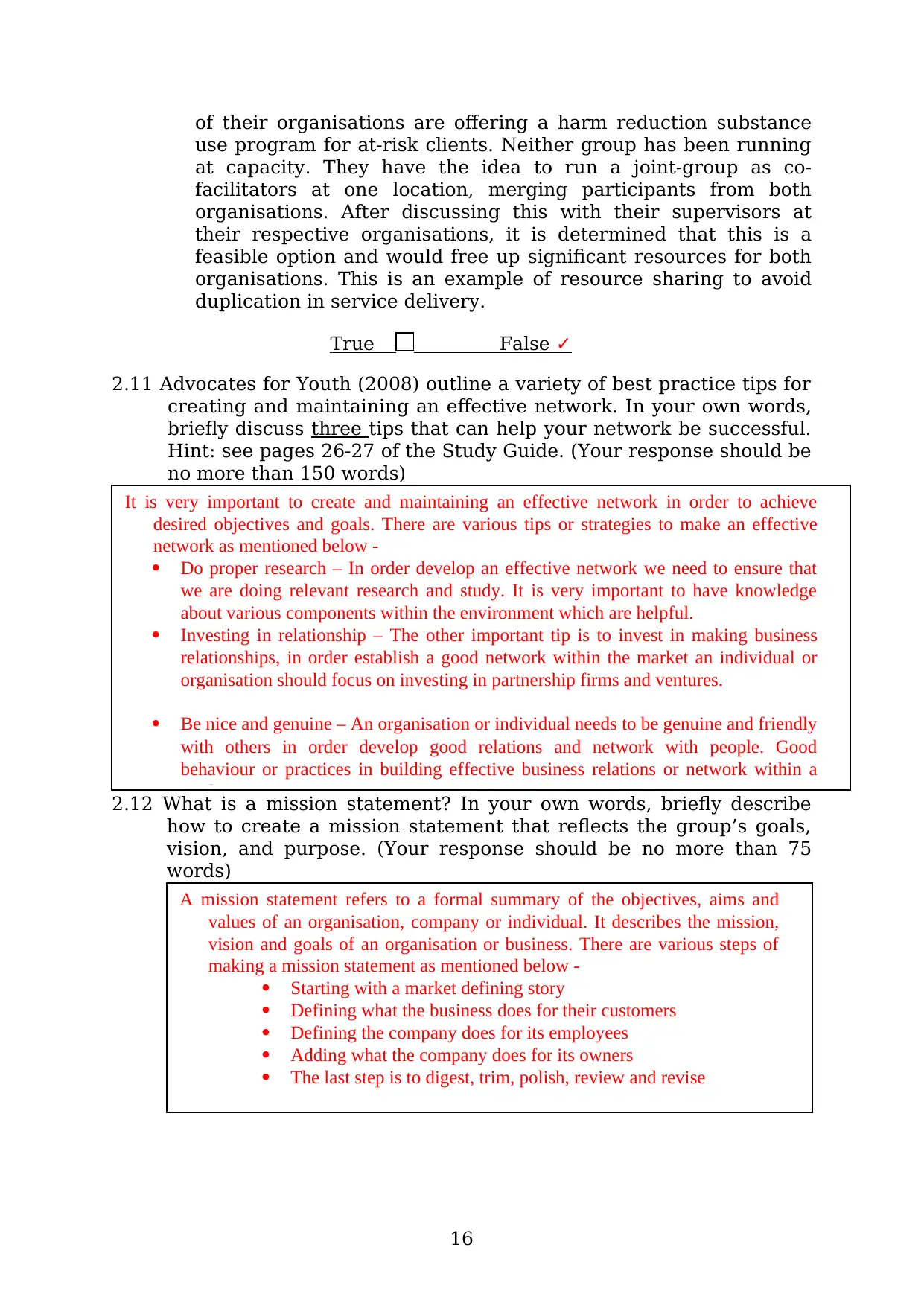
of their organisations are offering a harm reduction substance
use program for at-risk clients. Neither group has been running
at capacity. They have the idea to run a joint-group as co-
facilitators at one location, merging participants from both
organisations. After discussing this with their supervisors at
their respective organisations, it is determined that this is a
feasible option and would free up significant resources for both
organisations. This is an example of resource sharing to avoid
duplication in service delivery.
True False ✓
2.11 Advocates for Youth (2008) outline a variety of best practice tips for
creating and maintaining an effective network. In your own words,
briefly discuss three tips that can help your network be successful.
Hint: see pages 26-27 of the Study Guide. (Your response should be
no more than 150 words)
2.12 What is a mission statement? In your own words, briefly describe
how to create a mission statement that reflects the group’s goals,
vision, and purpose. (Your response should be no more than 75
words)
16
It is very important to create and maintaining an effective network in order to achieve
desired objectives and goals. There are various tips or strategies to make an effective
network as mentioned below -
Do proper research – In order develop an effective network we need to ensure that
we are doing relevant research and study. It is very important to have knowledge
about various components within the environment which are helpful.
Investing in relationship – The other important tip is to invest in making business
relationships, in order establish a good network within the market an individual or
organisation should focus on investing in partnership firms and ventures.
Be nice and genuine – An organisation or individual needs to be genuine and friendly
with others in order develop good relations and network with people. Good
behaviour or practices in building effective business relations or network within a
market
A mission statement refers to a formal summary of the objectives, aims and
values of an organisation, company or individual. It describes the mission,
vision and goals of an organisation or business. There are various steps of
making a mission statement as mentioned below -
Starting with a market defining story
Defining what the business does for their customers
Defining the company does for its employees
Adding what the company does for its owners
The last step is to digest, trim, polish, review and revise
use program for at-risk clients. Neither group has been running
at capacity. They have the idea to run a joint-group as co-
facilitators at one location, merging participants from both
organisations. After discussing this with their supervisors at
their respective organisations, it is determined that this is a
feasible option and would free up significant resources for both
organisations. This is an example of resource sharing to avoid
duplication in service delivery.
True False ✓
2.11 Advocates for Youth (2008) outline a variety of best practice tips for
creating and maintaining an effective network. In your own words,
briefly discuss three tips that can help your network be successful.
Hint: see pages 26-27 of the Study Guide. (Your response should be
no more than 150 words)
2.12 What is a mission statement? In your own words, briefly describe
how to create a mission statement that reflects the group’s goals,
vision, and purpose. (Your response should be no more than 75
words)
16
It is very important to create and maintaining an effective network in order to achieve
desired objectives and goals. There are various tips or strategies to make an effective
network as mentioned below -
Do proper research – In order develop an effective network we need to ensure that
we are doing relevant research and study. It is very important to have knowledge
about various components within the environment which are helpful.
Investing in relationship – The other important tip is to invest in making business
relationships, in order establish a good network within the market an individual or
organisation should focus on investing in partnership firms and ventures.
Be nice and genuine – An organisation or individual needs to be genuine and friendly
with others in order develop good relations and network with people. Good
behaviour or practices in building effective business relations or network within a
market
A mission statement refers to a formal summary of the objectives, aims and
values of an organisation, company or individual. It describes the mission,
vision and goals of an organisation or business. There are various steps of
making a mission statement as mentioned below -
Starting with a market defining story
Defining what the business does for their customers
Defining the company does for its employees
Adding what the company does for its owners
The last step is to digest, trim, polish, review and revise
Secure Best Marks with AI Grader
Need help grading? Try our AI Grader for instant feedback on your assignments.
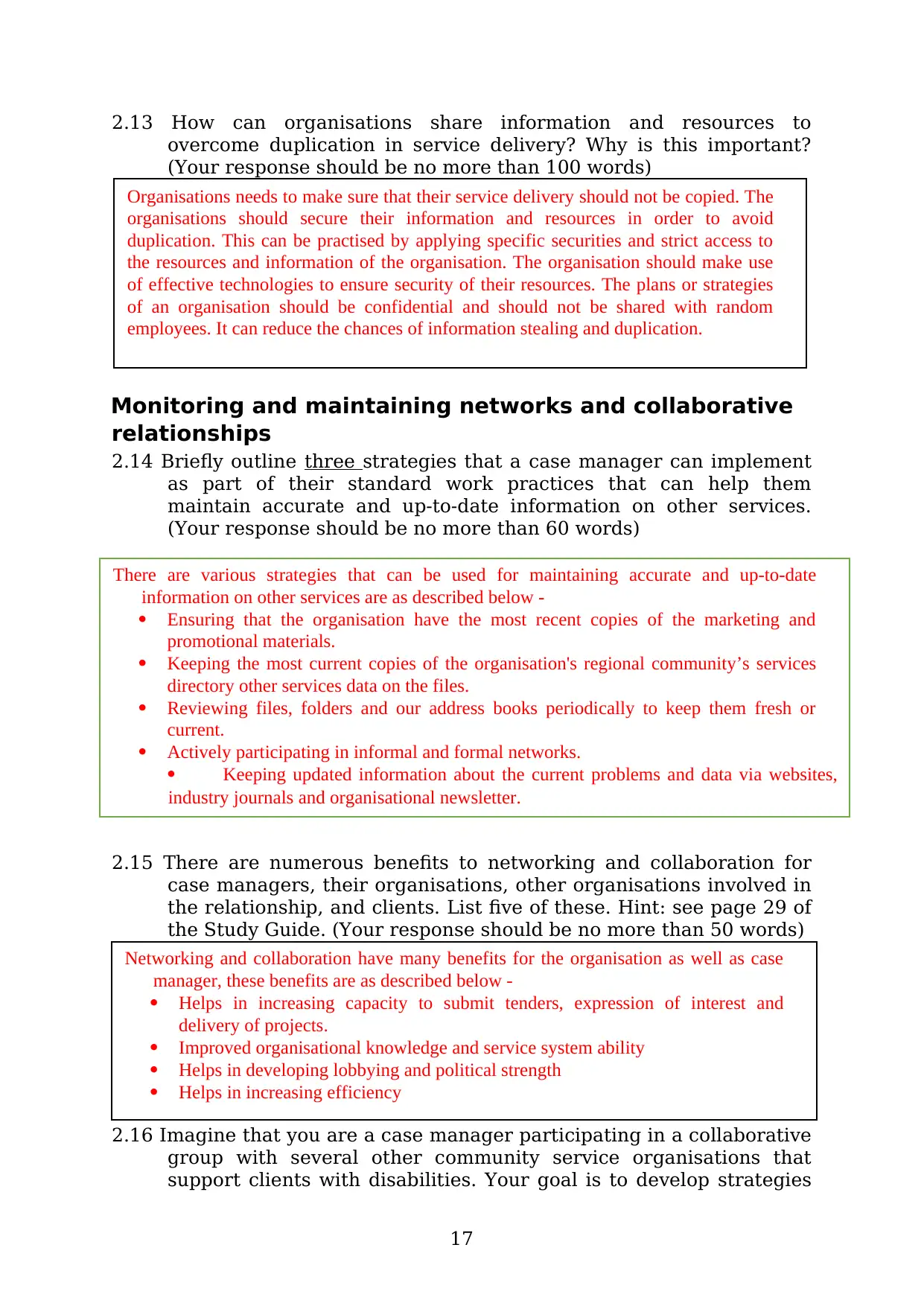
2.13 How can organisations share information and resources to
overcome duplication in service delivery? Why is this important?
(Your response should be no more than 100 words)
Monitoring and maintaining networks and collaborative
relationships
2.14 Briefly outline three strategies that a case manager can implement
as part of their standard work practices that can help them
maintain accurate and up-to-date information on other services.
(Your response should be no more than 60 words)
2.15 There are numerous benefits to networking and collaboration for
case managers, their organisations, other organisations involved in
the relationship, and clients. List five of these. Hint: see page 29 of
the Study Guide. (Your response should be no more than 50 words)
2.16 Imagine that you are a case manager participating in a collaborative
group with several other community service organisations that
support clients with disabilities. Your goal is to develop strategies
17
Organisations needs to make sure that their service delivery should not be copied. The
organisations should secure their information and resources in order to avoid
duplication. This can be practised by applying specific securities and strict access to
the resources and information of the organisation. The organisation should make use
of effective technologies to ensure security of their resources. The plans or strategies
of an organisation should be confidential and should not be shared with random
employees. It can reduce the chances of information stealing and duplication.
Networking and collaboration have many benefits for the organisation as well as case
manager, these benefits are as described below -
Helps in increasing capacity to submit tenders, expression of interest and
delivery of projects.
Improved organisational knowledge and service system ability
Helps in developing lobbying and political strength
Helps in increasing efficiency
There are various strategies that can be used for maintaining accurate and up-to-date
information on other services are as described below -
Ensuring that the organisation have the most recent copies of the marketing and
promotional materials.
Keeping the most current copies of the organisation's regional community’s services
directory other services data on the files.
Reviewing files, folders and our address books periodically to keep them fresh or
current.
Actively participating in informal and formal networks.
Keeping updated information about the current problems and data via websites,
industry journals and organisational newsletter.
overcome duplication in service delivery? Why is this important?
(Your response should be no more than 100 words)
Monitoring and maintaining networks and collaborative
relationships
2.14 Briefly outline three strategies that a case manager can implement
as part of their standard work practices that can help them
maintain accurate and up-to-date information on other services.
(Your response should be no more than 60 words)
2.15 There are numerous benefits to networking and collaboration for
case managers, their organisations, other organisations involved in
the relationship, and clients. List five of these. Hint: see page 29 of
the Study Guide. (Your response should be no more than 50 words)
2.16 Imagine that you are a case manager participating in a collaborative
group with several other community service organisations that
support clients with disabilities. Your goal is to develop strategies
17
Organisations needs to make sure that their service delivery should not be copied. The
organisations should secure their information and resources in order to avoid
duplication. This can be practised by applying specific securities and strict access to
the resources and information of the organisation. The organisation should make use
of effective technologies to ensure security of their resources. The plans or strategies
of an organisation should be confidential and should not be shared with random
employees. It can reduce the chances of information stealing and duplication.
Networking and collaboration have many benefits for the organisation as well as case
manager, these benefits are as described below -
Helps in increasing capacity to submit tenders, expression of interest and
delivery of projects.
Improved organisational knowledge and service system ability
Helps in developing lobbying and political strength
Helps in increasing efficiency
There are various strategies that can be used for maintaining accurate and up-to-date
information on other services are as described below -
Ensuring that the organisation have the most recent copies of the marketing and
promotional materials.
Keeping the most current copies of the organisation's regional community’s services
directory other services data on the files.
Reviewing files, folders and our address books periodically to keep them fresh or
current.
Actively participating in informal and formal networks.
Keeping updated information about the current problems and data via websites,
industry journals and organisational newsletter.
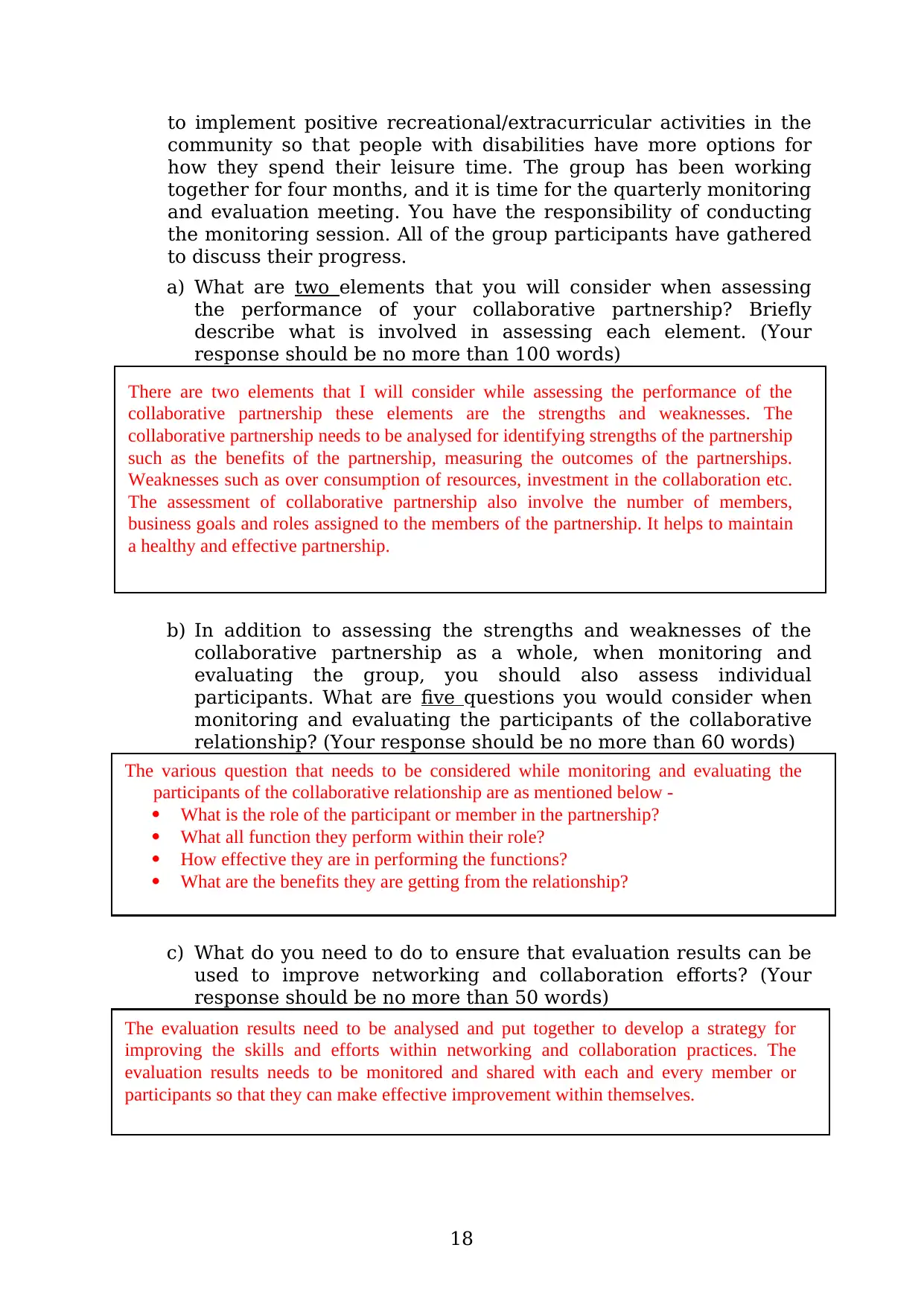
to implement positive recreational/extracurricular activities in the
community so that people with disabilities have more options for
how they spend their leisure time. The group has been working
together for four months, and it is time for the quarterly monitoring
and evaluation meeting. You have the responsibility of conducting
the monitoring session. All of the group participants have gathered
to discuss their progress.
a) What are two elements that you will consider when assessing
the performance of your collaborative partnership? Briefly
describe what is involved in assessing each element. (Your
response should be no more than 100 words)
b) In addition to assessing the strengths and weaknesses of the
collaborative partnership as a whole, when monitoring and
evaluating the group, you should also assess individual
participants. What are five questions you would consider when
monitoring and evaluating the participants of the collaborative
relationship? (Your response should be no more than 60 words)
c) What do you need to do to ensure that evaluation results can be
used to improve networking and collaboration efforts? (Your
response should be no more than 50 words)
18
There are two elements that I will consider while assessing the performance of the
collaborative partnership these elements are the strengths and weaknesses. The
collaborative partnership needs to be analysed for identifying strengths of the partnership
such as the benefits of the partnership, measuring the outcomes of the partnerships.
Weaknesses such as over consumption of resources, investment in the collaboration etc.
The assessment of collaborative partnership also involve the number of members,
business goals and roles assigned to the members of the partnership. It helps to maintain
a healthy and effective partnership.
The various question that needs to be considered while monitoring and evaluating the
participants of the collaborative relationship are as mentioned below -
What is the role of the participant or member in the partnership?
What all function they perform within their role?
How effective they are in performing the functions?
What are the benefits they are getting from the relationship?
The evaluation results need to be analysed and put together to develop a strategy for
improving the skills and efforts within networking and collaboration practices. The
evaluation results needs to be monitored and shared with each and every member or
participants so that they can make effective improvement within themselves.
community so that people with disabilities have more options for
how they spend their leisure time. The group has been working
together for four months, and it is time for the quarterly monitoring
and evaluation meeting. You have the responsibility of conducting
the monitoring session. All of the group participants have gathered
to discuss their progress.
a) What are two elements that you will consider when assessing
the performance of your collaborative partnership? Briefly
describe what is involved in assessing each element. (Your
response should be no more than 100 words)
b) In addition to assessing the strengths and weaknesses of the
collaborative partnership as a whole, when monitoring and
evaluating the group, you should also assess individual
participants. What are five questions you would consider when
monitoring and evaluating the participants of the collaborative
relationship? (Your response should be no more than 60 words)
c) What do you need to do to ensure that evaluation results can be
used to improve networking and collaboration efforts? (Your
response should be no more than 50 words)
18
There are two elements that I will consider while assessing the performance of the
collaborative partnership these elements are the strengths and weaknesses. The
collaborative partnership needs to be analysed for identifying strengths of the partnership
such as the benefits of the partnership, measuring the outcomes of the partnerships.
Weaknesses such as over consumption of resources, investment in the collaboration etc.
The assessment of collaborative partnership also involve the number of members,
business goals and roles assigned to the members of the partnership. It helps to maintain
a healthy and effective partnership.
The various question that needs to be considered while monitoring and evaluating the
participants of the collaborative relationship are as mentioned below -
What is the role of the participant or member in the partnership?
What all function they perform within their role?
How effective they are in performing the functions?
What are the benefits they are getting from the relationship?
The evaluation results need to be analysed and put together to develop a strategy for
improving the skills and efforts within networking and collaboration practices. The
evaluation results needs to be monitored and shared with each and every member or
participants so that they can make effective improvement within themselves.
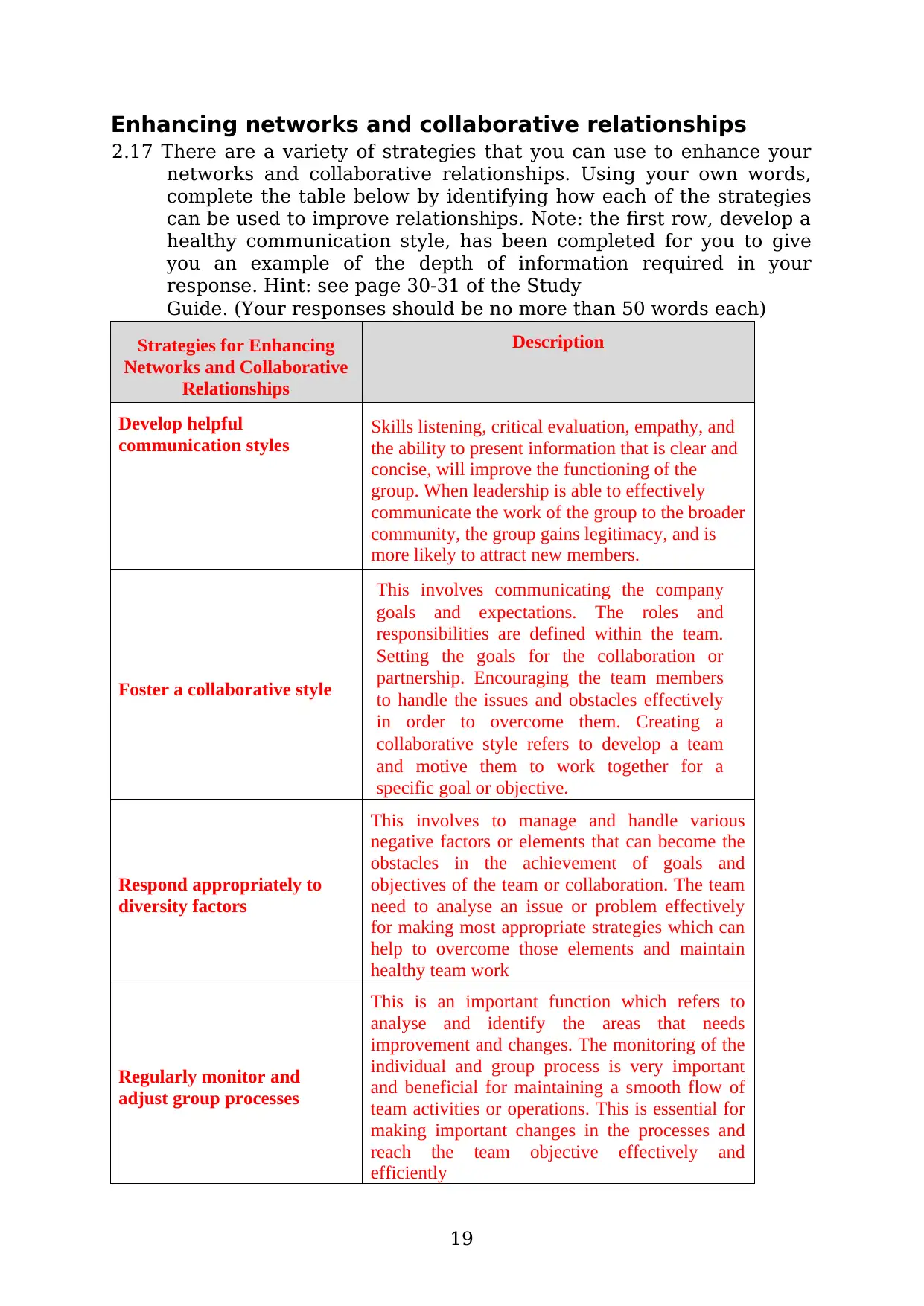
Enhancing networks and collaborative relationships
2.17 There are a variety of strategies that you can use to enhance your
networks and collaborative relationships. Using your own words,
complete the table below by identifying how each of the strategies
can be used to improve relationships. Note: the first row, develop a
healthy communication style, has been completed for you to give
you an example of the depth of information required in your
response. Hint: see page 30-31 of the Study
Guide. (Your responses should be no more than 50 words each)
Strategies for Enhancing
Networks and Collaborative
Relationships
Description
Develop helpful
communication styles Skills listening, critical evaluation, empathy, and
the ability to present information that is clear and
concise, will improve the functioning of the
group. When leadership is able to effectively
communicate the work of the group to the broader
community, the group gains legitimacy, and is
more likely to attract new members.
Foster a collaborative style
This involves communicating the company
goals and expectations. The roles and
responsibilities are defined within the team.
Setting the goals for the collaboration or
partnership. Encouraging the team members
to handle the issues and obstacles effectively
in order to overcome them. Creating a
collaborative style refers to develop a team
and motive them to work together for a
specific goal or objective.
Respond appropriately to
diversity factors
This involves to manage and handle various
negative factors or elements that can become the
obstacles in the achievement of goals and
objectives of the team or collaboration. The team
need to analyse an issue or problem effectively
for making most appropriate strategies which can
help to overcome those elements and maintain
healthy team work
Regularly monitor and
adjust group processes
This is an important function which refers to
analyse and identify the areas that needs
improvement and changes. The monitoring of the
individual and group process is very important
and beneficial for maintaining a smooth flow of
team activities or operations. This is essential for
making important changes in the processes and
reach the team objective effectively and
efficiently
19
2.17 There are a variety of strategies that you can use to enhance your
networks and collaborative relationships. Using your own words,
complete the table below by identifying how each of the strategies
can be used to improve relationships. Note: the first row, develop a
healthy communication style, has been completed for you to give
you an example of the depth of information required in your
response. Hint: see page 30-31 of the Study
Guide. (Your responses should be no more than 50 words each)
Strategies for Enhancing
Networks and Collaborative
Relationships
Description
Develop helpful
communication styles Skills listening, critical evaluation, empathy, and
the ability to present information that is clear and
concise, will improve the functioning of the
group. When leadership is able to effectively
communicate the work of the group to the broader
community, the group gains legitimacy, and is
more likely to attract new members.
Foster a collaborative style
This involves communicating the company
goals and expectations. The roles and
responsibilities are defined within the team.
Setting the goals for the collaboration or
partnership. Encouraging the team members
to handle the issues and obstacles effectively
in order to overcome them. Creating a
collaborative style refers to develop a team
and motive them to work together for a
specific goal or objective.
Respond appropriately to
diversity factors
This involves to manage and handle various
negative factors or elements that can become the
obstacles in the achievement of goals and
objectives of the team or collaboration. The team
need to analyse an issue or problem effectively
for making most appropriate strategies which can
help to overcome those elements and maintain
healthy team work
Regularly monitor and
adjust group processes
This is an important function which refers to
analyse and identify the areas that needs
improvement and changes. The monitoring of the
individual and group process is very important
and beneficial for maintaining a smooth flow of
team activities or operations. This is essential for
making important changes in the processes and
reach the team objective effectively and
efficiently
19
Paraphrase This Document
Need a fresh take? Get an instant paraphrase of this document with our AI Paraphraser
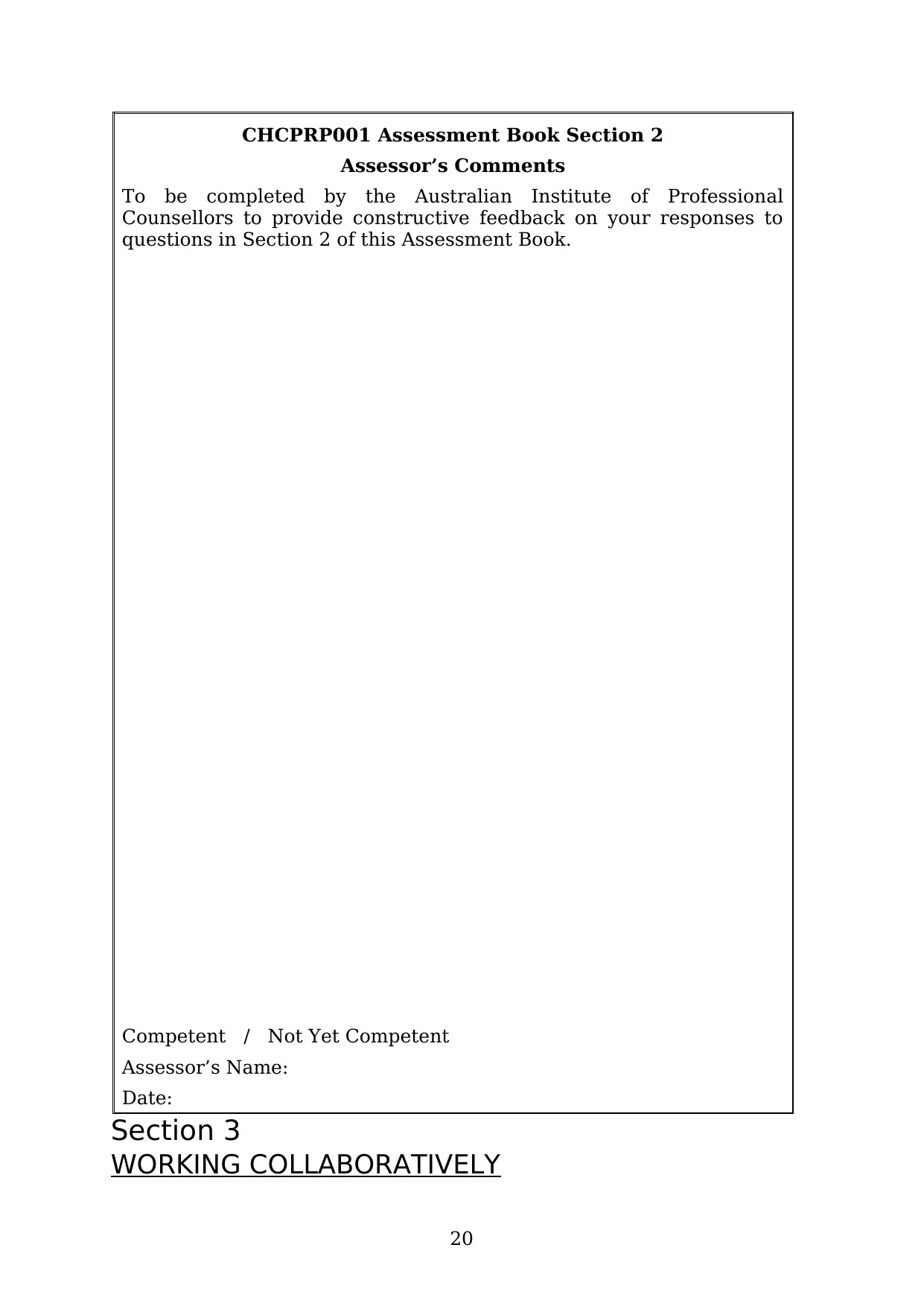
CHCPRP001 Assessment Book Section 2
Assessor’s Comments
To be completed by the Australian Institute of Professional
Counsellors to provide constructive feedback on your responses to
questions in Section 2 of this Assessment Book.
Competent / Not Yet Competent
Assessor’s Name:
Date:
Section 3
WORKING COLLABORATIVELY
20
Assessor’s Comments
To be completed by the Australian Institute of Professional
Counsellors to provide constructive feedback on your responses to
questions in Section 2 of this Assessment Book.
Competent / Not Yet Competent
Assessor’s Name:
Date:
Section 3
WORKING COLLABORATIVELY
20
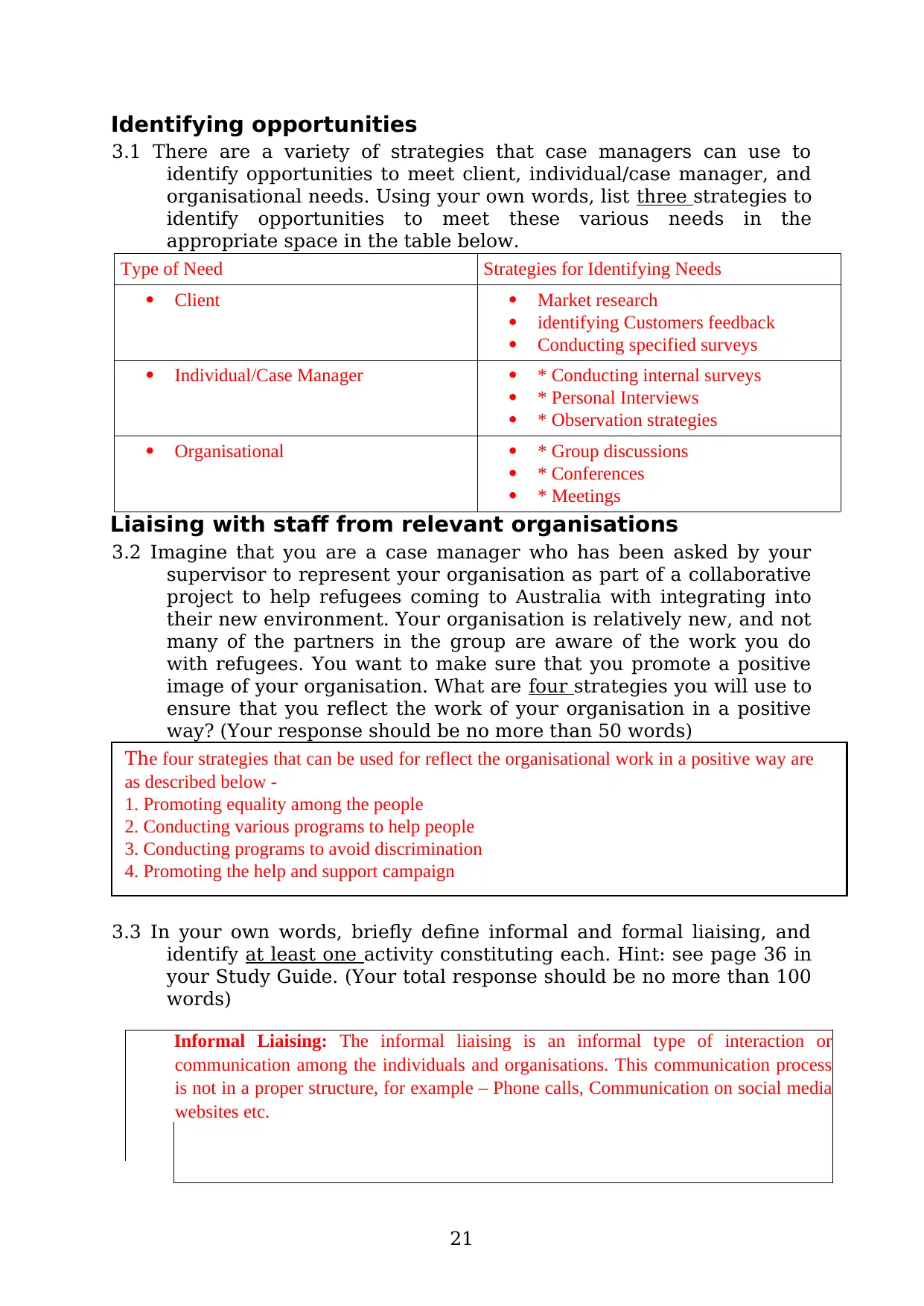
Identifying opportunities
3.1 There are a variety of strategies that case managers can use to
identify opportunities to meet client, individual/case manager, and
organisational needs. Using your own words, list three strategies to
identify opportunities to meet these various needs in the
appropriate space in the table below.
Type of Need Strategies for Identifying Needs
Client Market research
identifying Customers feedback
Conducting specified surveys
Individual/Case Manager * Conducting internal surveys
* Personal Interviews
* Observation strategies
Organisational * Group discussions
* Conferences
* Meetings
Liaising with staff from relevant organisations
3.2 Imagine that you are a case manager who has been asked by your
supervisor to represent your organisation as part of a collaborative
project to help refugees coming to Australia with integrating into
their new environment. Your organisation is relatively new, and not
many of the partners in the group are aware of the work you do
with refugees. You want to make sure that you promote a positive
image of your organisation. What are four strategies you will use to
ensure that you reflect the work of your organisation in a positive
way? (Your response should be no more than 50 words)
3.3 In your own words, briefly define informal and formal liaising, and
identify at least one activity constituting each. Hint: see page 36 in
your Study Guide. (Your total response should be no more than 100
words)
Informal Liaising: The informal liaising is an informal type of interaction or
communication among the individuals and organisations. This communication process
is not in a proper structure, for example – Phone calls, Communication on social media
websites etc.
21
The four strategies that can be used for reflect the organisational work in a positive way are
as described below -
1. Promoting equality among the people
2. Conducting various programs to help people
3. Conducting programs to avoid discrimination
4. Promoting the help and support campaign
3.1 There are a variety of strategies that case managers can use to
identify opportunities to meet client, individual/case manager, and
organisational needs. Using your own words, list three strategies to
identify opportunities to meet these various needs in the
appropriate space in the table below.
Type of Need Strategies for Identifying Needs
Client Market research
identifying Customers feedback
Conducting specified surveys
Individual/Case Manager * Conducting internal surveys
* Personal Interviews
* Observation strategies
Organisational * Group discussions
* Conferences
* Meetings
Liaising with staff from relevant organisations
3.2 Imagine that you are a case manager who has been asked by your
supervisor to represent your organisation as part of a collaborative
project to help refugees coming to Australia with integrating into
their new environment. Your organisation is relatively new, and not
many of the partners in the group are aware of the work you do
with refugees. You want to make sure that you promote a positive
image of your organisation. What are four strategies you will use to
ensure that you reflect the work of your organisation in a positive
way? (Your response should be no more than 50 words)
3.3 In your own words, briefly define informal and formal liaising, and
identify at least one activity constituting each. Hint: see page 36 in
your Study Guide. (Your total response should be no more than 100
words)
Informal Liaising: The informal liaising is an informal type of interaction or
communication among the individuals and organisations. This communication process
is not in a proper structure, for example – Phone calls, Communication on social media
websites etc.
21
The four strategies that can be used for reflect the organisational work in a positive way are
as described below -
1. Promoting equality among the people
2. Conducting various programs to help people
3. Conducting programs to avoid discrimination
4. Promoting the help and support campaign
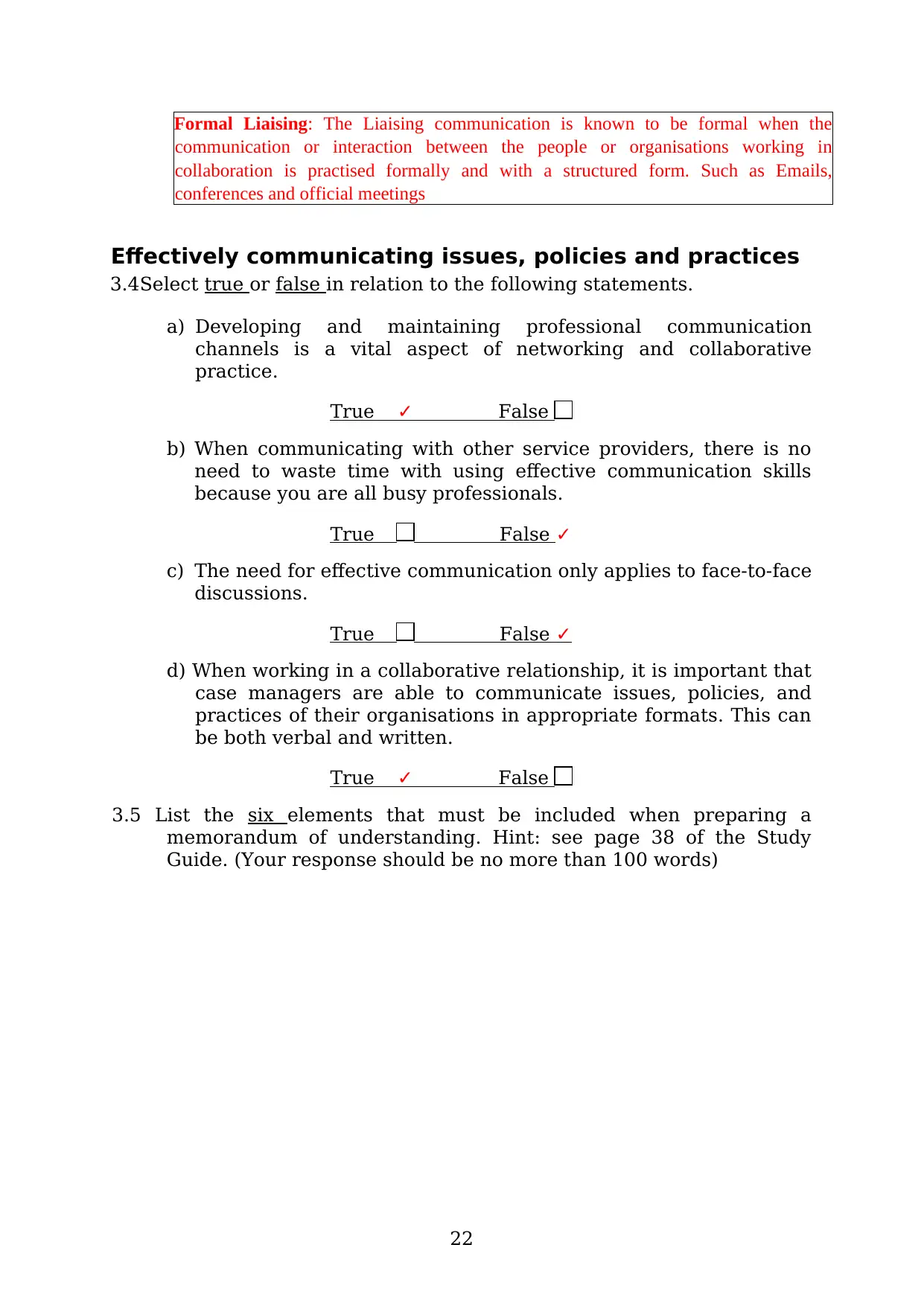
Formal Liaising: The Liaising communication is known to be formal when the
communication or interaction between the people or organisations working in
collaboration is practised formally and with a structured form. Such as Emails,
conferences and official meetings
Effectively communicating issues, policies and practices
3.4Select true or false in relation to the following statements.
a) Developing and maintaining professional communication
channels is a vital aspect of networking and collaborative
practice.
True ✓ False
b) When communicating with other service providers, there is no
need to waste time with using effective communication skills
because you are all busy professionals.
True False ✓
c) The need for effective communication only applies to face-to-face
discussions.
True False ✓
d) When working in a collaborative relationship, it is important that
case managers are able to communicate issues, policies, and
practices of their organisations in appropriate formats. This can
be both verbal and written.
True ✓ False
3.5 List the six elements that must be included when preparing a
memorandum of understanding. Hint: see page 38 of the Study
Guide. (Your response should be no more than 100 words)
22
communication or interaction between the people or organisations working in
collaboration is practised formally and with a structured form. Such as Emails,
conferences and official meetings
Effectively communicating issues, policies and practices
3.4Select true or false in relation to the following statements.
a) Developing and maintaining professional communication
channels is a vital aspect of networking and collaborative
practice.
True ✓ False
b) When communicating with other service providers, there is no
need to waste time with using effective communication skills
because you are all busy professionals.
True False ✓
c) The need for effective communication only applies to face-to-face
discussions.
True False ✓
d) When working in a collaborative relationship, it is important that
case managers are able to communicate issues, policies, and
practices of their organisations in appropriate formats. This can
be both verbal and written.
True ✓ False
3.5 List the six elements that must be included when preparing a
memorandum of understanding. Hint: see page 38 of the Study
Guide. (Your response should be no more than 100 words)
22
Secure Best Marks with AI Grader
Need help grading? Try our AI Grader for instant feedback on your assignments.
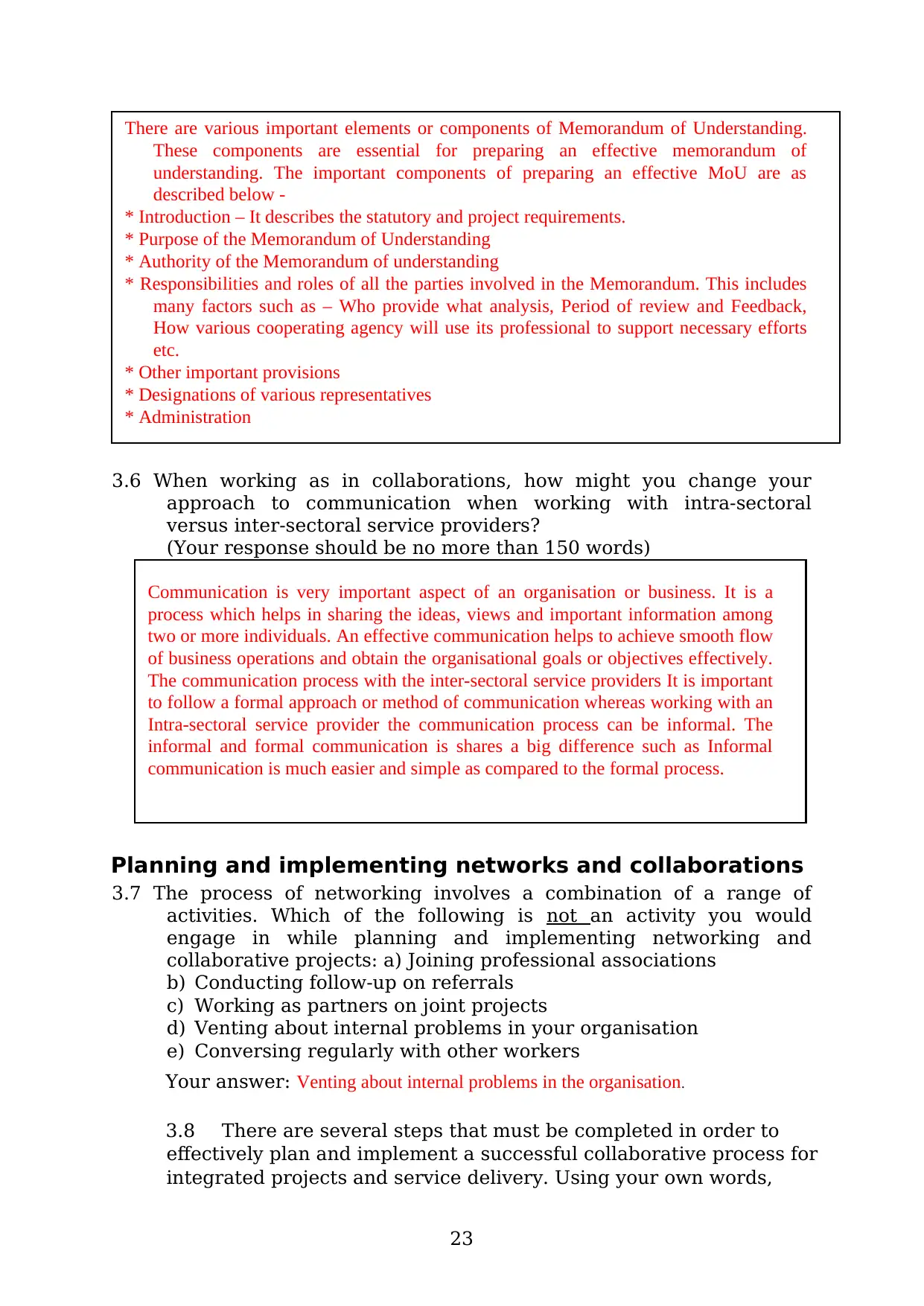
3.6 When working as in collaborations, how might you change your
approach to communication when working with intra-sectoral
versus inter-sectoral service providers?
(Your response should be no more than 150 words)
Planning and implementing networks and collaborations
3.7 The process of networking involves a combination of a range of
activities. Which of the following is not an activity you would
engage in while planning and implementing networking and
collaborative projects: a) Joining professional associations
b) Conducting follow-up on referrals
c) Working as partners on joint projects
d) Venting about internal problems in your organisation
e) Conversing regularly with other workers
Your answer: Venting about internal problems in the organisation.
3.8 There are several steps that must be completed in order to
effectively plan and implement a successful collaborative process for
integrated projects and service delivery. Using your own words,
23
There are various important elements or components of Memorandum of Understanding.
These components are essential for preparing an effective memorandum of
understanding. The important components of preparing an effective MoU are as
described below -
* Introduction – It describes the statutory and project requirements.
* Purpose of the Memorandum of Understanding
* Authority of the Memorandum of understanding
* Responsibilities and roles of all the parties involved in the Memorandum. This includes
many factors such as – Who provide what analysis, Period of review and Feedback,
How various cooperating agency will use its professional to support necessary efforts
etc.
* Other important provisions
* Designations of various representatives
* Administration
Communication is very important aspect of an organisation or business. It is a
process which helps in sharing the ideas, views and important information among
two or more individuals. An effective communication helps to achieve smooth flow
of business operations and obtain the organisational goals or objectives effectively.
The communication process with the inter-sectoral service providers It is important
to follow a formal approach or method of communication whereas working with an
Intra-sectoral service provider the communication process can be informal. The
informal and formal communication is shares a big difference such as Informal
communication is much easier and simple as compared to the formal process.
approach to communication when working with intra-sectoral
versus inter-sectoral service providers?
(Your response should be no more than 150 words)
Planning and implementing networks and collaborations
3.7 The process of networking involves a combination of a range of
activities. Which of the following is not an activity you would
engage in while planning and implementing networking and
collaborative projects: a) Joining professional associations
b) Conducting follow-up on referrals
c) Working as partners on joint projects
d) Venting about internal problems in your organisation
e) Conversing regularly with other workers
Your answer: Venting about internal problems in the organisation.
3.8 There are several steps that must be completed in order to
effectively plan and implement a successful collaborative process for
integrated projects and service delivery. Using your own words,
23
There are various important elements or components of Memorandum of Understanding.
These components are essential for preparing an effective memorandum of
understanding. The important components of preparing an effective MoU are as
described below -
* Introduction – It describes the statutory and project requirements.
* Purpose of the Memorandum of Understanding
* Authority of the Memorandum of understanding
* Responsibilities and roles of all the parties involved in the Memorandum. This includes
many factors such as – Who provide what analysis, Period of review and Feedback,
How various cooperating agency will use its professional to support necessary efforts
etc.
* Other important provisions
* Designations of various representatives
* Administration
Communication is very important aspect of an organisation or business. It is a
process which helps in sharing the ideas, views and important information among
two or more individuals. An effective communication helps to achieve smooth flow
of business operations and obtain the organisational goals or objectives effectively.
The communication process with the inter-sectoral service providers It is important
to follow a formal approach or method of communication whereas working with an
Intra-sectoral service provider the communication process can be informal. The
informal and formal communication is shares a big difference such as Informal
communication is much easier and simple as compared to the formal process.
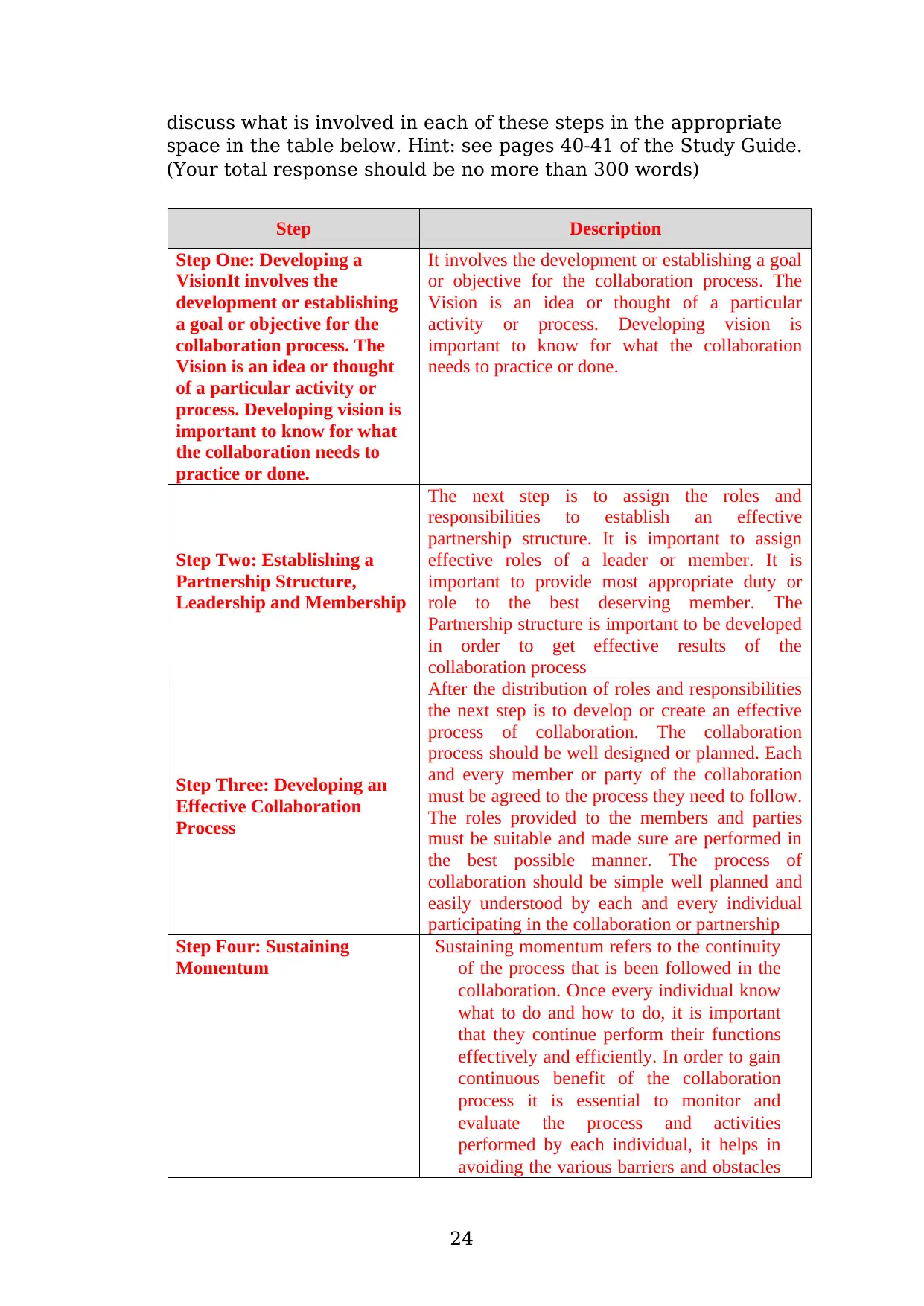
discuss what is involved in each of these steps in the appropriate
space in the table below. Hint: see pages 40-41 of the Study Guide.
(Your total response should be no more than 300 words)
Step Description
Step One: Developing a
VisionIt involves the
development or establishing
a goal or objective for the
collaboration process. The
Vision is an idea or thought
of a particular activity or
process. Developing vision is
important to know for what
the collaboration needs to
practice or done.
It involves the development or establishing a goal
or objective for the collaboration process. The
Vision is an idea or thought of a particular
activity or process. Developing vision is
important to know for what the collaboration
needs to practice or done.
Step Two: Establishing a
Partnership Structure,
Leadership and Membership
The next step is to assign the roles and
responsibilities to establish an effective
partnership structure. It is important to assign
effective roles of a leader or member. It is
important to provide most appropriate duty or
role to the best deserving member. The
Partnership structure is important to be developed
in order to get effective results of the
collaboration process
Step Three: Developing an
Effective Collaboration
Process
After the distribution of roles and responsibilities
the next step is to develop or create an effective
process of collaboration. The collaboration
process should be well designed or planned. Each
and every member or party of the collaboration
must be agreed to the process they need to follow.
The roles provided to the members and parties
must be suitable and made sure are performed in
the best possible manner. The process of
collaboration should be simple well planned and
easily understood by each and every individual
participating in the collaboration or partnership
Step Four: Sustaining
Momentum
Sustaining momentum refers to the continuity
of the process that is been followed in the
collaboration. Once every individual know
what to do and how to do, it is important
that they continue perform their functions
effectively and efficiently. In order to gain
continuous benefit of the collaboration
process it is essential to monitor and
evaluate the process and activities
performed by each individual, it helps in
avoiding the various barriers and obstacles
24
space in the table below. Hint: see pages 40-41 of the Study Guide.
(Your total response should be no more than 300 words)
Step Description
Step One: Developing a
VisionIt involves the
development or establishing
a goal or objective for the
collaboration process. The
Vision is an idea or thought
of a particular activity or
process. Developing vision is
important to know for what
the collaboration needs to
practice or done.
It involves the development or establishing a goal
or objective for the collaboration process. The
Vision is an idea or thought of a particular
activity or process. Developing vision is
important to know for what the collaboration
needs to practice or done.
Step Two: Establishing a
Partnership Structure,
Leadership and Membership
The next step is to assign the roles and
responsibilities to establish an effective
partnership structure. It is important to assign
effective roles of a leader or member. It is
important to provide most appropriate duty or
role to the best deserving member. The
Partnership structure is important to be developed
in order to get effective results of the
collaboration process
Step Three: Developing an
Effective Collaboration
Process
After the distribution of roles and responsibilities
the next step is to develop or create an effective
process of collaboration. The collaboration
process should be well designed or planned. Each
and every member or party of the collaboration
must be agreed to the process they need to follow.
The roles provided to the members and parties
must be suitable and made sure are performed in
the best possible manner. The process of
collaboration should be simple well planned and
easily understood by each and every individual
participating in the collaboration or partnership
Step Four: Sustaining
Momentum
Sustaining momentum refers to the continuity
of the process that is been followed in the
collaboration. Once every individual know
what to do and how to do, it is important
that they continue perform their functions
effectively and efficiently. In order to gain
continuous benefit of the collaboration
process it is essential to monitor and
evaluate the process and activities
performed by each individual, it helps in
avoiding the various barriers and obstacles
24
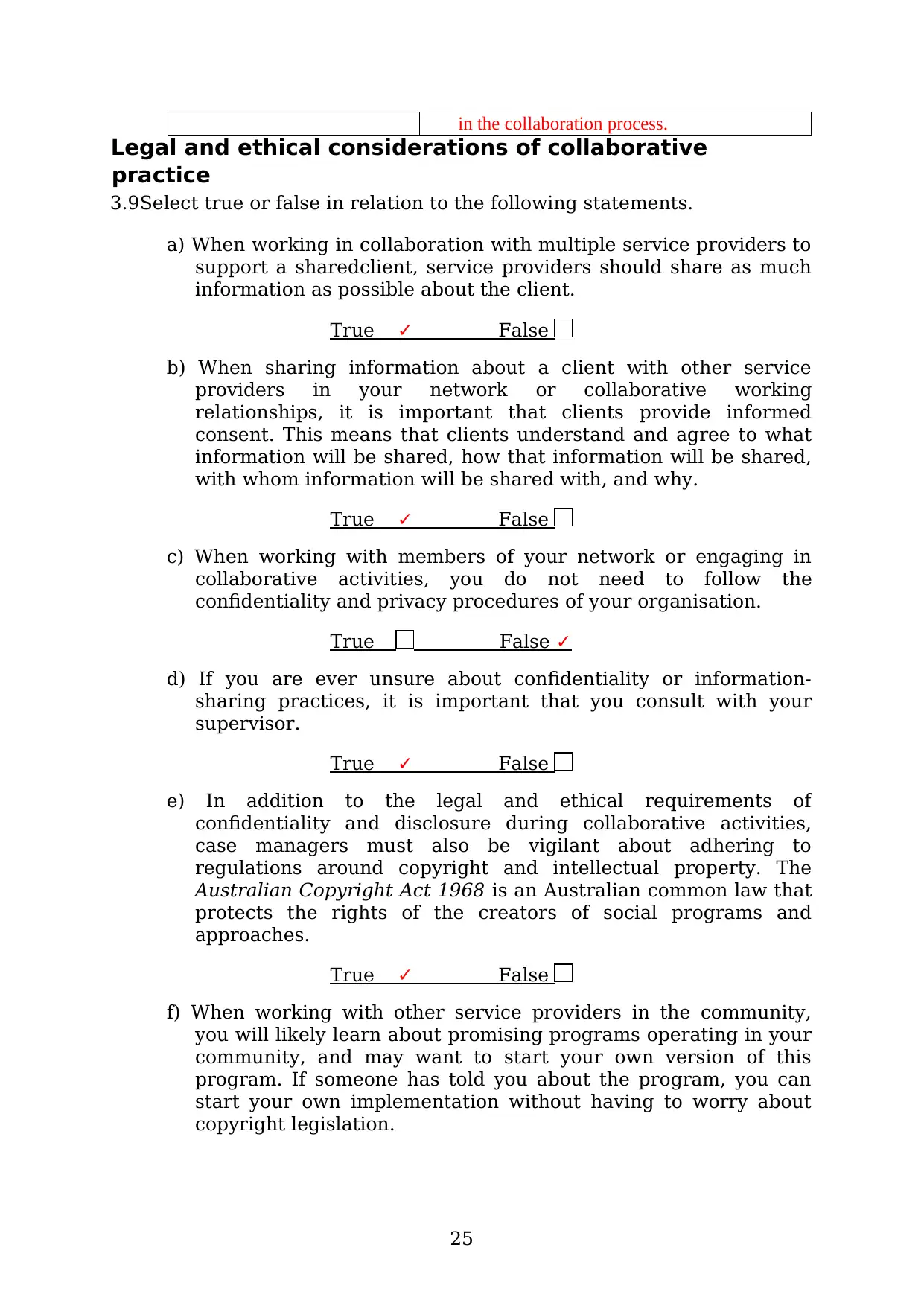
in the collaboration process.
Legal and ethical considerations of collaborative
practice
3.9Select true or false in relation to the following statements.
a) When working in collaboration with multiple service providers to
support a sharedclient, service providers should share as much
information as possible about the client.
True ✓ False
b) When sharing information about a client with other service
providers in your network or collaborative working
relationships, it is important that clients provide informed
consent. This means that clients understand and agree to what
information will be shared, how that information will be shared,
with whom information will be shared with, and why.
True ✓ False
c) When working with members of your network or engaging in
collaborative activities, you do not need to follow the
confidentiality and privacy procedures of your organisation.
True False ✓
d) If you are ever unsure about confidentiality or information-
sharing practices, it is important that you consult with your
supervisor.
True ✓ False
e) In addition to the legal and ethical requirements of
confidentiality and disclosure during collaborative activities,
case managers must also be vigilant about adhering to
regulations around copyright and intellectual property. The
Australian Copyright Act 1968 is an Australian common law that
protects the rights of the creators of social programs and
approaches.
True ✓ False
f) When working with other service providers in the community,
you will likely learn about promising programs operating in your
community, and may want to start your own version of this
program. If someone has told you about the program, you can
start your own implementation without having to worry about
copyright legislation.
25
Legal and ethical considerations of collaborative
practice
3.9Select true or false in relation to the following statements.
a) When working in collaboration with multiple service providers to
support a sharedclient, service providers should share as much
information as possible about the client.
True ✓ False
b) When sharing information about a client with other service
providers in your network or collaborative working
relationships, it is important that clients provide informed
consent. This means that clients understand and agree to what
information will be shared, how that information will be shared,
with whom information will be shared with, and why.
True ✓ False
c) When working with members of your network or engaging in
collaborative activities, you do not need to follow the
confidentiality and privacy procedures of your organisation.
True False ✓
d) If you are ever unsure about confidentiality or information-
sharing practices, it is important that you consult with your
supervisor.
True ✓ False
e) In addition to the legal and ethical requirements of
confidentiality and disclosure during collaborative activities,
case managers must also be vigilant about adhering to
regulations around copyright and intellectual property. The
Australian Copyright Act 1968 is an Australian common law that
protects the rights of the creators of social programs and
approaches.
True ✓ False
f) When working with other service providers in the community,
you will likely learn about promising programs operating in your
community, and may want to start your own version of this
program. If someone has told you about the program, you can
start your own implementation without having to worry about
copyright legislation.
25
Paraphrase This Document
Need a fresh take? Get an instant paraphrase of this document with our AI Paraphraser
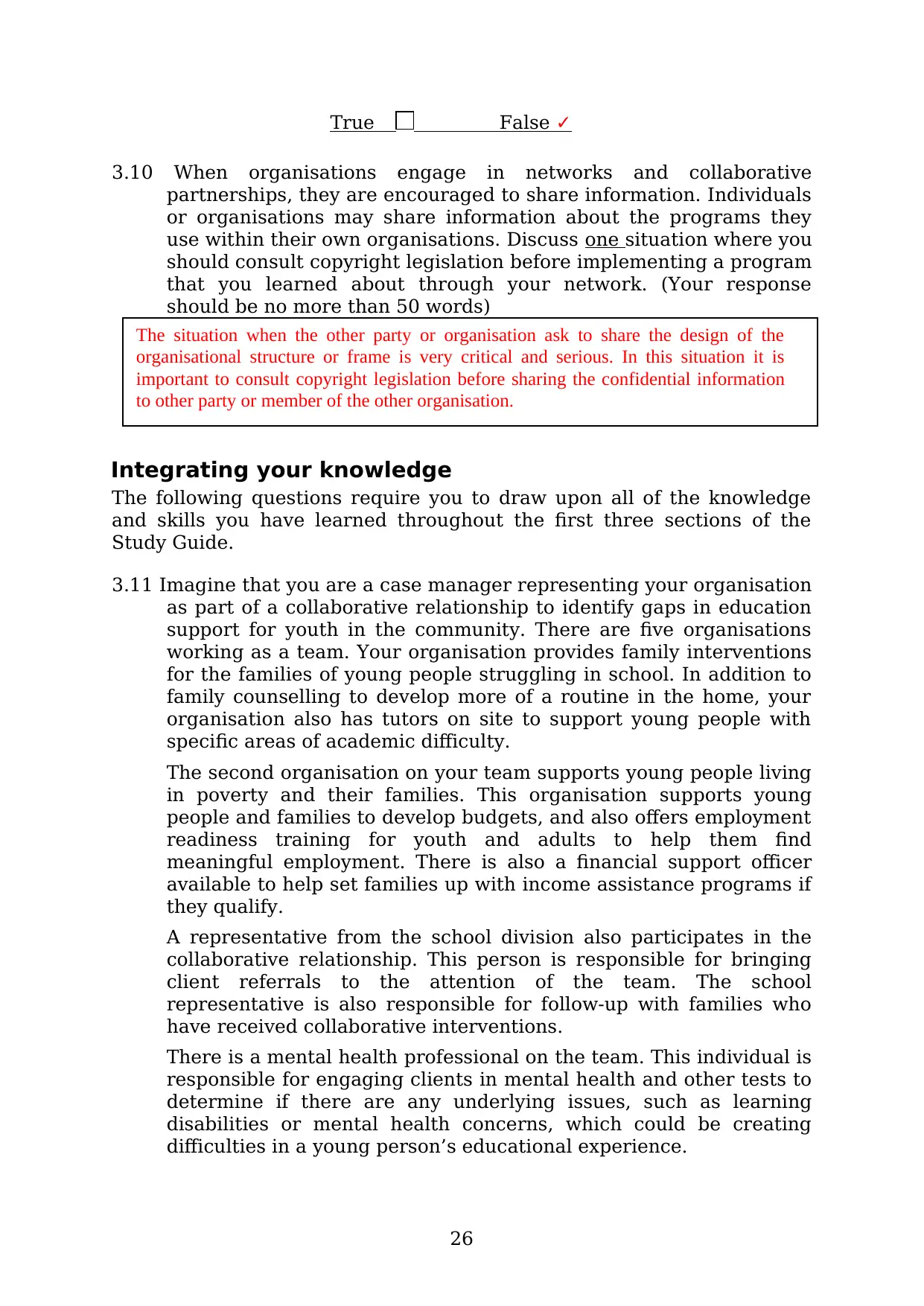
True False ✓
3.10 When organisations engage in networks and collaborative
partnerships, they are encouraged to share information. Individuals
or organisations may share information about the programs they
use within their own organisations. Discuss one situation where you
should consult copyright legislation before implementing a program
that you learned about through your network. (Your response
should be no more than 50 words)
Integrating your knowledge
The following questions require you to draw upon all of the knowledge
and skills you have learned throughout the first three sections of the
Study Guide.
3.11 Imagine that you are a case manager representing your organisation
as part of a collaborative relationship to identify gaps in education
support for youth in the community. There are five organisations
working as a team. Your organisation provides family interventions
for the families of young people struggling in school. In addition to
family counselling to develop more of a routine in the home, your
organisation also has tutors on site to support young people with
specific areas of academic difficulty.
The second organisation on your team supports young people living
in poverty and their families. This organisation supports young
people and families to develop budgets, and also offers employment
readiness training for youth and adults to help them find
meaningful employment. There is also a financial support officer
available to help set families up with income assistance programs if
they qualify.
A representative from the school division also participates in the
collaborative relationship. This person is responsible for bringing
client referrals to the attention of the team. The school
representative is also responsible for follow-up with families who
have received collaborative interventions.
There is a mental health professional on the team. This individual is
responsible for engaging clients in mental health and other tests to
determine if there are any underlying issues, such as learning
disabilities or mental health concerns, which could be creating
difficulties in a young person’s educational experience.
26
The situation when the other party or organisation ask to share the design of the
organisational structure or frame is very critical and serious. In this situation it is
important to consult copyright legislation before sharing the confidential information
to other party or member of the other organisation.
3.10 When organisations engage in networks and collaborative
partnerships, they are encouraged to share information. Individuals
or organisations may share information about the programs they
use within their own organisations. Discuss one situation where you
should consult copyright legislation before implementing a program
that you learned about through your network. (Your response
should be no more than 50 words)
Integrating your knowledge
The following questions require you to draw upon all of the knowledge
and skills you have learned throughout the first three sections of the
Study Guide.
3.11 Imagine that you are a case manager representing your organisation
as part of a collaborative relationship to identify gaps in education
support for youth in the community. There are five organisations
working as a team. Your organisation provides family interventions
for the families of young people struggling in school. In addition to
family counselling to develop more of a routine in the home, your
organisation also has tutors on site to support young people with
specific areas of academic difficulty.
The second organisation on your team supports young people living
in poverty and their families. This organisation supports young
people and families to develop budgets, and also offers employment
readiness training for youth and adults to help them find
meaningful employment. There is also a financial support officer
available to help set families up with income assistance programs if
they qualify.
A representative from the school division also participates in the
collaborative relationship. This person is responsible for bringing
client referrals to the attention of the team. The school
representative is also responsible for follow-up with families who
have received collaborative interventions.
There is a mental health professional on the team. This individual is
responsible for engaging clients in mental health and other tests to
determine if there are any underlying issues, such as learning
disabilities or mental health concerns, which could be creating
difficulties in a young person’s educational experience.
26
The situation when the other party or organisation ask to share the design of the
organisational structure or frame is very critical and serious. In this situation it is
important to consult copyright legislation before sharing the confidential information
to other party or member of the other organisation.
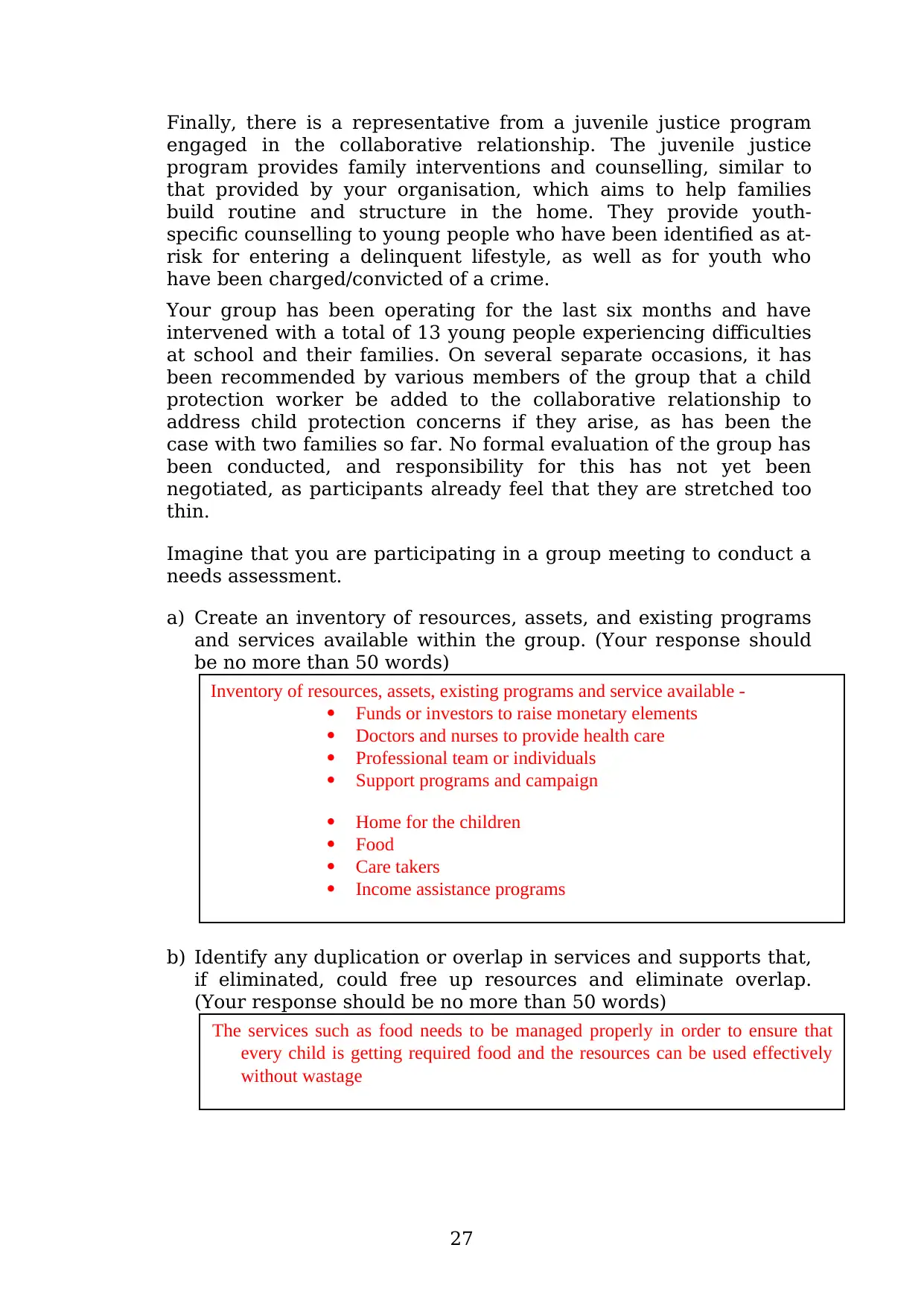
Finally, there is a representative from a juvenile justice program
engaged in the collaborative relationship. The juvenile justice
program provides family interventions and counselling, similar to
that provided by your organisation, which aims to help families
build routine and structure in the home. They provide youth-
specific counselling to young people who have been identified as at-
risk for entering a delinquent lifestyle, as well as for youth who
have been charged/convicted of a crime.
Your group has been operating for the last six months and have
intervened with a total of 13 young people experiencing difficulties
at school and their families. On several separate occasions, it has
been recommended by various members of the group that a child
protection worker be added to the collaborative relationship to
address child protection concerns if they arise, as has been the
case with two families so far. No formal evaluation of the group has
been conducted, and responsibility for this has not yet been
negotiated, as participants already feel that they are stretched too
thin.
Imagine that you are participating in a group meeting to conduct a
needs assessment.
a) Create an inventory of resources, assets, and existing programs
and services available within the group. (Your response should
be no more than 50 words)
b) Identify any duplication or overlap in services and supports that,
if eliminated, could free up resources and eliminate overlap.
(Your response should be no more than 50 words)
27
Inventory of resources, assets, existing programs and service available -
Funds or investors to raise monetary elements
Doctors and nurses to provide health care
Professional team or individuals
Support programs and campaign
Home for the children
Food
Care takers
Income assistance programs
The services such as food needs to be managed properly in order to ensure that
every child is getting required food and the resources can be used effectively
without wastage
engaged in the collaborative relationship. The juvenile justice
program provides family interventions and counselling, similar to
that provided by your organisation, which aims to help families
build routine and structure in the home. They provide youth-
specific counselling to young people who have been identified as at-
risk for entering a delinquent lifestyle, as well as for youth who
have been charged/convicted of a crime.
Your group has been operating for the last six months and have
intervened with a total of 13 young people experiencing difficulties
at school and their families. On several separate occasions, it has
been recommended by various members of the group that a child
protection worker be added to the collaborative relationship to
address child protection concerns if they arise, as has been the
case with two families so far. No formal evaluation of the group has
been conducted, and responsibility for this has not yet been
negotiated, as participants already feel that they are stretched too
thin.
Imagine that you are participating in a group meeting to conduct a
needs assessment.
a) Create an inventory of resources, assets, and existing programs
and services available within the group. (Your response should
be no more than 50 words)
b) Identify any duplication or overlap in services and supports that,
if eliminated, could free up resources and eliminate overlap.
(Your response should be no more than 50 words)
27
Inventory of resources, assets, existing programs and service available -
Funds or investors to raise monetary elements
Doctors and nurses to provide health care
Professional team or individuals
Support programs and campaign
Home for the children
Food
Care takers
Income assistance programs
The services such as food needs to be managed properly in order to ensure that
every child is getting required food and the resources can be used effectively
without wastage
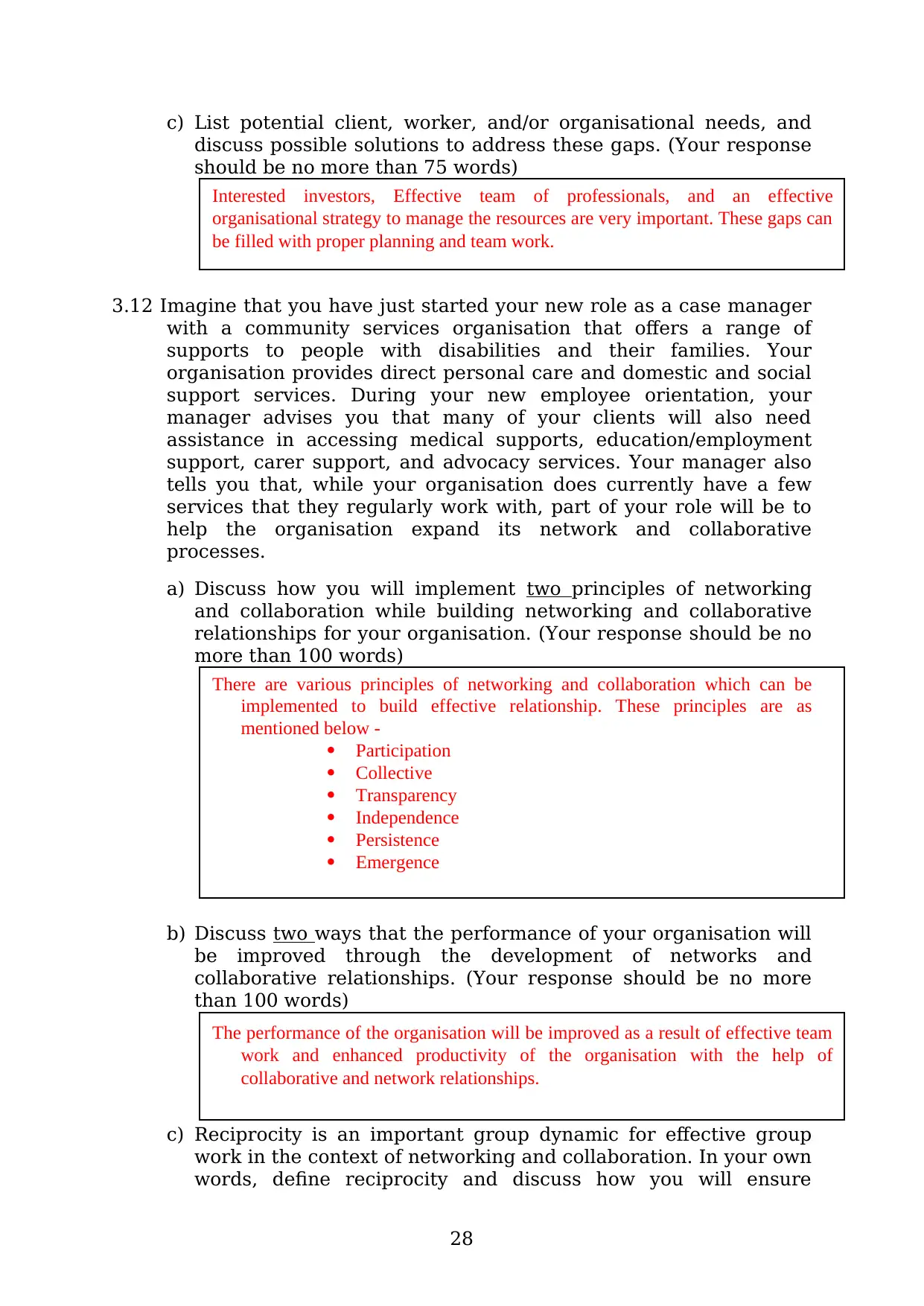
c) List potential client, worker, and/or organisational needs, and
discuss possible solutions to address these gaps. (Your response
should be no more than 75 words)
3.12 Imagine that you have just started your new role as a case manager
with a community services organisation that offers a range of
supports to people with disabilities and their families. Your
organisation provides direct personal care and domestic and social
support services. During your new employee orientation, your
manager advises you that many of your clients will also need
assistance in accessing medical supports, education/employment
support, carer support, and advocacy services. Your manager also
tells you that, while your organisation does currently have a few
services that they regularly work with, part of your role will be to
help the organisation expand its network and collaborative
processes.
a) Discuss how you will implement two principles of networking
and collaboration while building networking and collaborative
relationships for your organisation. (Your response should be no
more than 100 words)
b) Discuss two ways that the performance of your organisation will
be improved through the development of networks and
collaborative relationships. (Your response should be no more
than 100 words)
c) Reciprocity is an important group dynamic for effective group
work in the context of networking and collaboration. In your own
words, define reciprocity and discuss how you will ensure
28
Interested investors, Effective team of professionals, and an effective
organisational strategy to manage the resources are very important. These gaps can
be filled with proper planning and team work.
There are various principles of networking and collaboration which can be
implemented to build effective relationship. These principles are as
mentioned below -
Participation
Collective
Transparency
Independence
Persistence
Emergence
The performance of the organisation will be improved as a result of effective team
work and enhanced productivity of the organisation with the help of
collaborative and network relationships.
discuss possible solutions to address these gaps. (Your response
should be no more than 75 words)
3.12 Imagine that you have just started your new role as a case manager
with a community services organisation that offers a range of
supports to people with disabilities and their families. Your
organisation provides direct personal care and domestic and social
support services. During your new employee orientation, your
manager advises you that many of your clients will also need
assistance in accessing medical supports, education/employment
support, carer support, and advocacy services. Your manager also
tells you that, while your organisation does currently have a few
services that they regularly work with, part of your role will be to
help the organisation expand its network and collaborative
processes.
a) Discuss how you will implement two principles of networking
and collaboration while building networking and collaborative
relationships for your organisation. (Your response should be no
more than 100 words)
b) Discuss two ways that the performance of your organisation will
be improved through the development of networks and
collaborative relationships. (Your response should be no more
than 100 words)
c) Reciprocity is an important group dynamic for effective group
work in the context of networking and collaboration. In your own
words, define reciprocity and discuss how you will ensure
28
Interested investors, Effective team of professionals, and an effective
organisational strategy to manage the resources are very important. These gaps can
be filled with proper planning and team work.
There are various principles of networking and collaboration which can be
implemented to build effective relationship. These principles are as
mentioned below -
Participation
Collective
Transparency
Independence
Persistence
Emergence
The performance of the organisation will be improved as a result of effective team
work and enhanced productivity of the organisation with the help of
collaborative and network relationships.
Secure Best Marks with AI Grader
Need help grading? Try our AI Grader for instant feedback on your assignments.
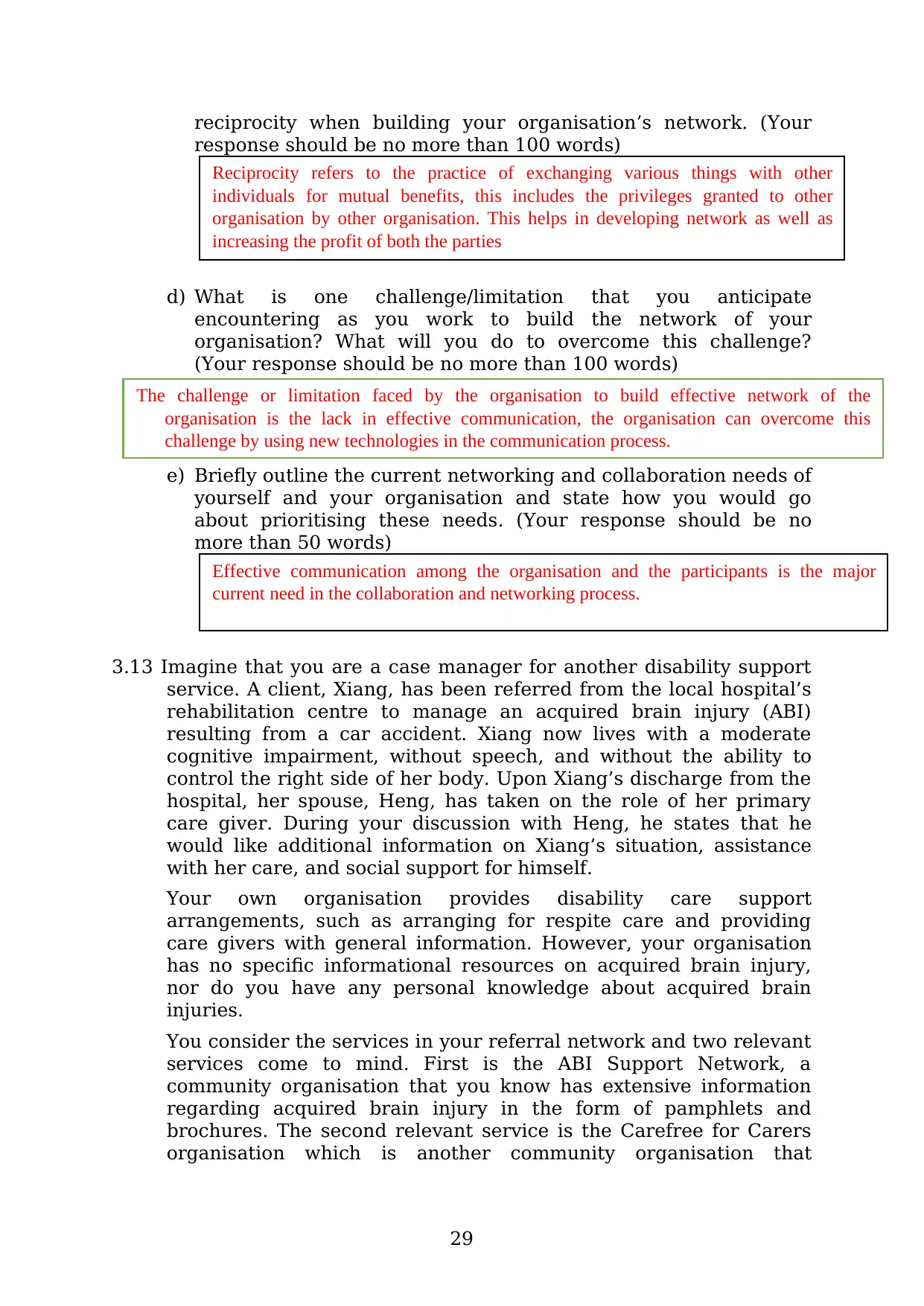
reciprocity when building your organisation’s network. (Your
response should be no more than 100 words)
d) What is one challenge/limitation that you anticipate
encountering as you work to build the network of your
organisation? What will you do to overcome this challenge?
(Your response should be no more than 100 words)
e) Briefly outline the current networking and collaboration needs of
yourself and your organisation and state how you would go
about prioritising these needs. (Your response should be no
more than 50 words)
3.13 Imagine that you are a case manager for another disability support
service. A client, Xiang, has been referred from the local hospital’s
rehabilitation centre to manage an acquired brain injury (ABI)
resulting from a car accident. Xiang now lives with a moderate
cognitive impairment, without speech, and without the ability to
control the right side of her body. Upon Xiang’s discharge from the
hospital, her spouse, Heng, has taken on the role of her primary
care giver. During your discussion with Heng, he states that he
would like additional information on Xiang’s situation, assistance
with her care, and social support for himself.
Your own organisation provides disability care support
arrangements, such as arranging for respite care and providing
care givers with general information. However, your organisation
has no specific informational resources on acquired brain injury,
nor do you have any personal knowledge about acquired brain
injuries.
You consider the services in your referral network and two relevant
services come to mind. First is the ABI Support Network, a
community organisation that you know has extensive information
regarding acquired brain injury in the form of pamphlets and
brochures. The second relevant service is the Carefree for Carers
organisation which is another community organisation that
29
Reciprocity refers to the practice of exchanging various things with other
individuals for mutual benefits, this includes the privileges granted to other
organisation by other organisation. This helps in developing network as well as
increasing the profit of both the parties
Effective communication among the organisation and the participants is the major
current need in the collaboration and networking process.
The challenge or limitation faced by the organisation to build effective network of the
organisation is the lack in effective communication, the organisation can overcome this
challenge by using new technologies in the communication process.
response should be no more than 100 words)
d) What is one challenge/limitation that you anticipate
encountering as you work to build the network of your
organisation? What will you do to overcome this challenge?
(Your response should be no more than 100 words)
e) Briefly outline the current networking and collaboration needs of
yourself and your organisation and state how you would go
about prioritising these needs. (Your response should be no
more than 50 words)
3.13 Imagine that you are a case manager for another disability support
service. A client, Xiang, has been referred from the local hospital’s
rehabilitation centre to manage an acquired brain injury (ABI)
resulting from a car accident. Xiang now lives with a moderate
cognitive impairment, without speech, and without the ability to
control the right side of her body. Upon Xiang’s discharge from the
hospital, her spouse, Heng, has taken on the role of her primary
care giver. During your discussion with Heng, he states that he
would like additional information on Xiang’s situation, assistance
with her care, and social support for himself.
Your own organisation provides disability care support
arrangements, such as arranging for respite care and providing
care givers with general information. However, your organisation
has no specific informational resources on acquired brain injury,
nor do you have any personal knowledge about acquired brain
injuries.
You consider the services in your referral network and two relevant
services come to mind. First is the ABI Support Network, a
community organisation that you know has extensive information
regarding acquired brain injury in the form of pamphlets and
brochures. The second relevant service is the Carefree for Carers
organisation which is another community organisation that
29
Reciprocity refers to the practice of exchanging various things with other
individuals for mutual benefits, this includes the privileges granted to other
organisation by other organisation. This helps in developing network as well as
increasing the profit of both the parties
Effective communication among the organisation and the participants is the major
current need in the collaboration and networking process.
The challenge or limitation faced by the organisation to build effective network of the
organisation is the lack in effective communication, the organisation can overcome this
challenge by using new technologies in the communication process.
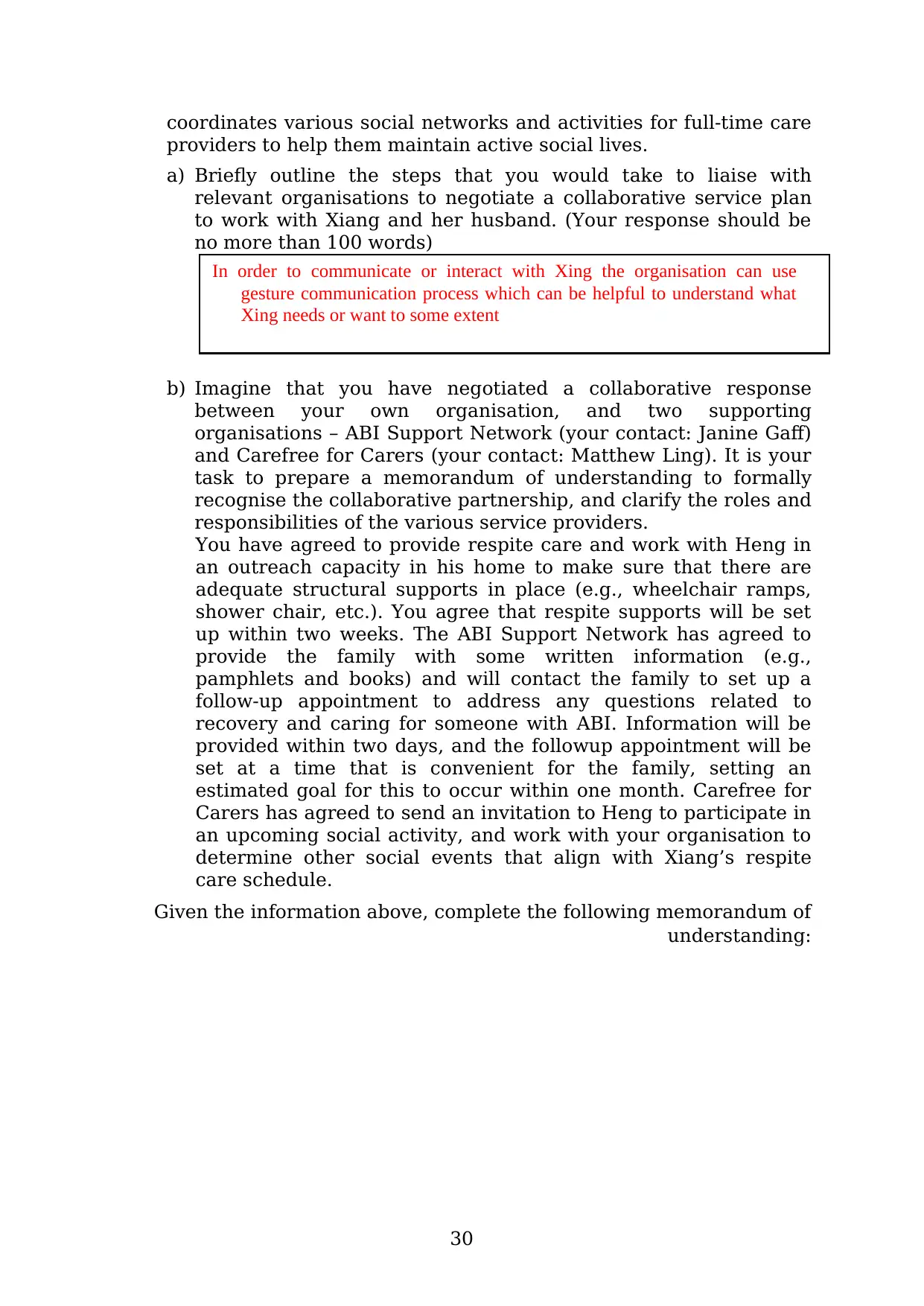
coordinates various social networks and activities for full-time care
providers to help them maintain active social lives.
a) Briefly outline the steps that you would take to liaise with
relevant organisations to negotiate a collaborative service plan
to work with Xiang and her husband. (Your response should be
no more than 100 words)
b) Imagine that you have negotiated a collaborative response
between your own organisation, and two supporting
organisations – ABI Support Network (your contact: Janine Gaff)
and Carefree for Carers (your contact: Matthew Ling). It is your
task to prepare a memorandum of understanding to formally
recognise the collaborative partnership, and clarify the roles and
responsibilities of the various service providers.
You have agreed to provide respite care and work with Heng in
an outreach capacity in his home to make sure that there are
adequate structural supports in place (e.g., wheelchair ramps,
shower chair, etc.). You agree that respite supports will be set
up within two weeks. The ABI Support Network has agreed to
provide the family with some written information (e.g.,
pamphlets and books) and will contact the family to set up a
follow-up appointment to address any questions related to
recovery and caring for someone with ABI. Information will be
provided within two days, and the followup appointment will be
set at a time that is convenient for the family, setting an
estimated goal for this to occur within one month. Carefree for
Carers has agreed to send an invitation to Heng to participate in
an upcoming social activity, and work with your organisation to
determine other social events that align with Xiang’s respite
care schedule.
Given the information above, complete the following memorandum of
understanding:
30
In order to communicate or interact with Xing the organisation can use
gesture communication process which can be helpful to understand what
Xing needs or want to some extent
providers to help them maintain active social lives.
a) Briefly outline the steps that you would take to liaise with
relevant organisations to negotiate a collaborative service plan
to work with Xiang and her husband. (Your response should be
no more than 100 words)
b) Imagine that you have negotiated a collaborative response
between your own organisation, and two supporting
organisations – ABI Support Network (your contact: Janine Gaff)
and Carefree for Carers (your contact: Matthew Ling). It is your
task to prepare a memorandum of understanding to formally
recognise the collaborative partnership, and clarify the roles and
responsibilities of the various service providers.
You have agreed to provide respite care and work with Heng in
an outreach capacity in his home to make sure that there are
adequate structural supports in place (e.g., wheelchair ramps,
shower chair, etc.). You agree that respite supports will be set
up within two weeks. The ABI Support Network has agreed to
provide the family with some written information (e.g.,
pamphlets and books) and will contact the family to set up a
follow-up appointment to address any questions related to
recovery and caring for someone with ABI. Information will be
provided within two days, and the followup appointment will be
set at a time that is convenient for the family, setting an
estimated goal for this to occur within one month. Carefree for
Carers has agreed to send an invitation to Heng to participate in
an upcoming social activity, and work with your organisation to
determine other social events that align with Xiang’s respite
care schedule.
Given the information above, complete the following memorandum of
understanding:
30
In order to communicate or interact with Xing the organisation can use
gesture communication process which can be helpful to understand what
Xing needs or want to some extent
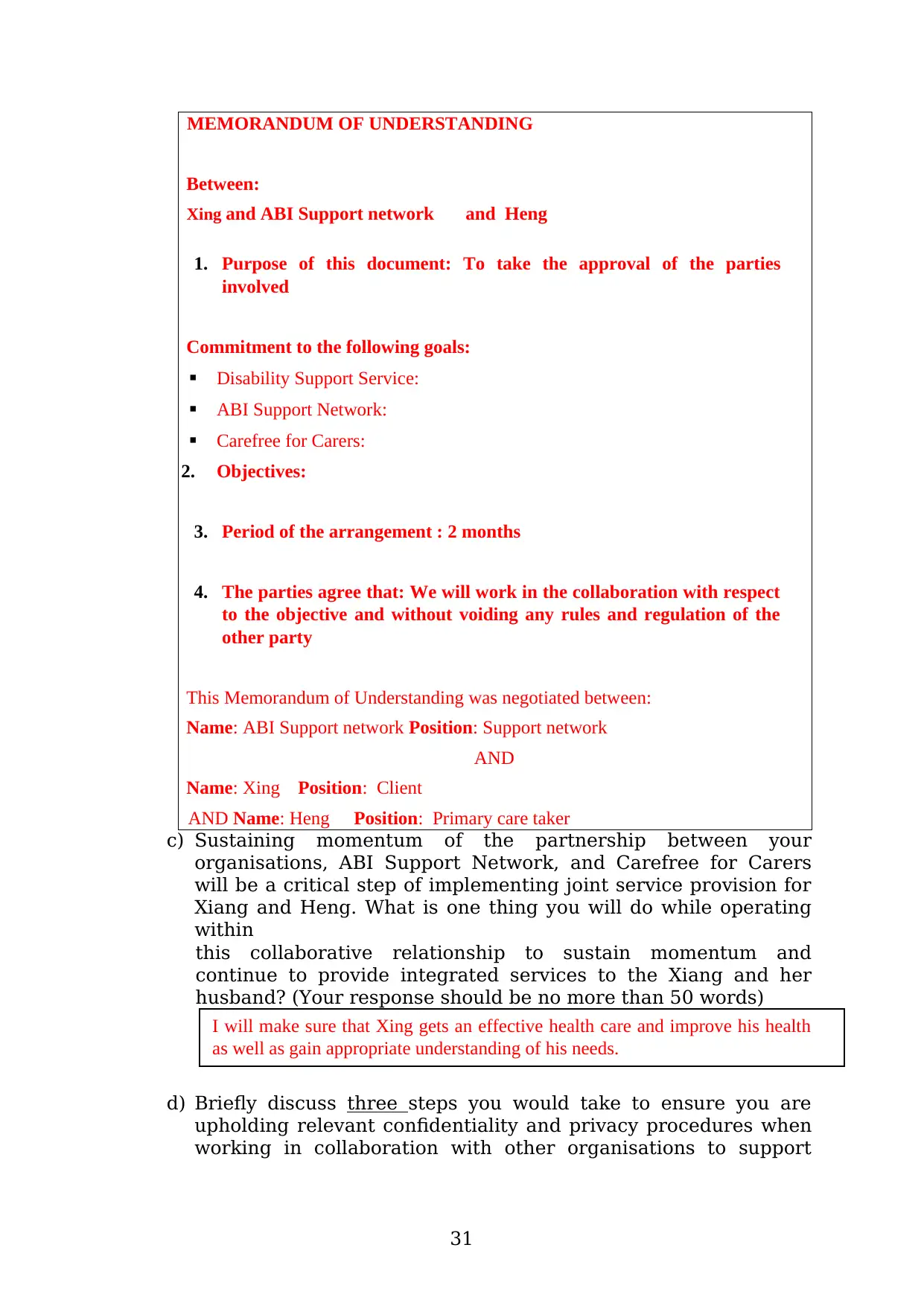
MEMORANDUM OF UNDERSTANDING
Between:
Xing and ABI Support network and Heng
1. Purpose of this document: To take the approval of the parties
involved
Commitment to the following goals:
Disability Support Service:
ABI Support Network:
Carefree for Carers:
2. Objectives:
3. Period of the arrangement : 2 months
4. The parties agree that: We will work in the collaboration with respect
to the objective and without voiding any rules and regulation of the
other party
This Memorandum of Understanding was negotiated between:
Name: ABI Support network Position: Support network
AND
Name: Xing Position: Client
AND Name: Heng Position: Primary care taker
c) Sustaining momentum of the partnership between your
organisations, ABI Support Network, and Carefree for Carers
will be a critical step of implementing joint service provision for
Xiang and Heng. What is one thing you will do while operating
within
this collaborative relationship to sustain momentum and
continue to provide integrated services to the Xiang and her
husband? (Your response should be no more than 50 words)
d) Briefly discuss three steps you would take to ensure you are
upholding relevant confidentiality and privacy procedures when
working in collaboration with other organisations to support
31
I will make sure that Xing gets an effective health care and improve his health
as well as gain appropriate understanding of his needs.
Between:
Xing and ABI Support network and Heng
1. Purpose of this document: To take the approval of the parties
involved
Commitment to the following goals:
Disability Support Service:
ABI Support Network:
Carefree for Carers:
2. Objectives:
3. Period of the arrangement : 2 months
4. The parties agree that: We will work in the collaboration with respect
to the objective and without voiding any rules and regulation of the
other party
This Memorandum of Understanding was negotiated between:
Name: ABI Support network Position: Support network
AND
Name: Xing Position: Client
AND Name: Heng Position: Primary care taker
c) Sustaining momentum of the partnership between your
organisations, ABI Support Network, and Carefree for Carers
will be a critical step of implementing joint service provision for
Xiang and Heng. What is one thing you will do while operating
within
this collaborative relationship to sustain momentum and
continue to provide integrated services to the Xiang and her
husband? (Your response should be no more than 50 words)
d) Briefly discuss three steps you would take to ensure you are
upholding relevant confidentiality and privacy procedures when
working in collaboration with other organisations to support
31
I will make sure that Xing gets an effective health care and improve his health
as well as gain appropriate understanding of his needs.
Paraphrase This Document
Need a fresh take? Get an instant paraphrase of this document with our AI Paraphraser

Xiang and Heng. (Your response should be no more than 100
words)
32
1. Make sure no one forces Xeng to discuss or communicate with any other
individual
2. Provide proper security to him in terms of technology and documents
3. The information collected through him is secured.
words)
32
1. Make sure no one forces Xeng to discuss or communicate with any other
individual
2. Provide proper security to him in terms of technology and documents
3. The information collected through him is secured.
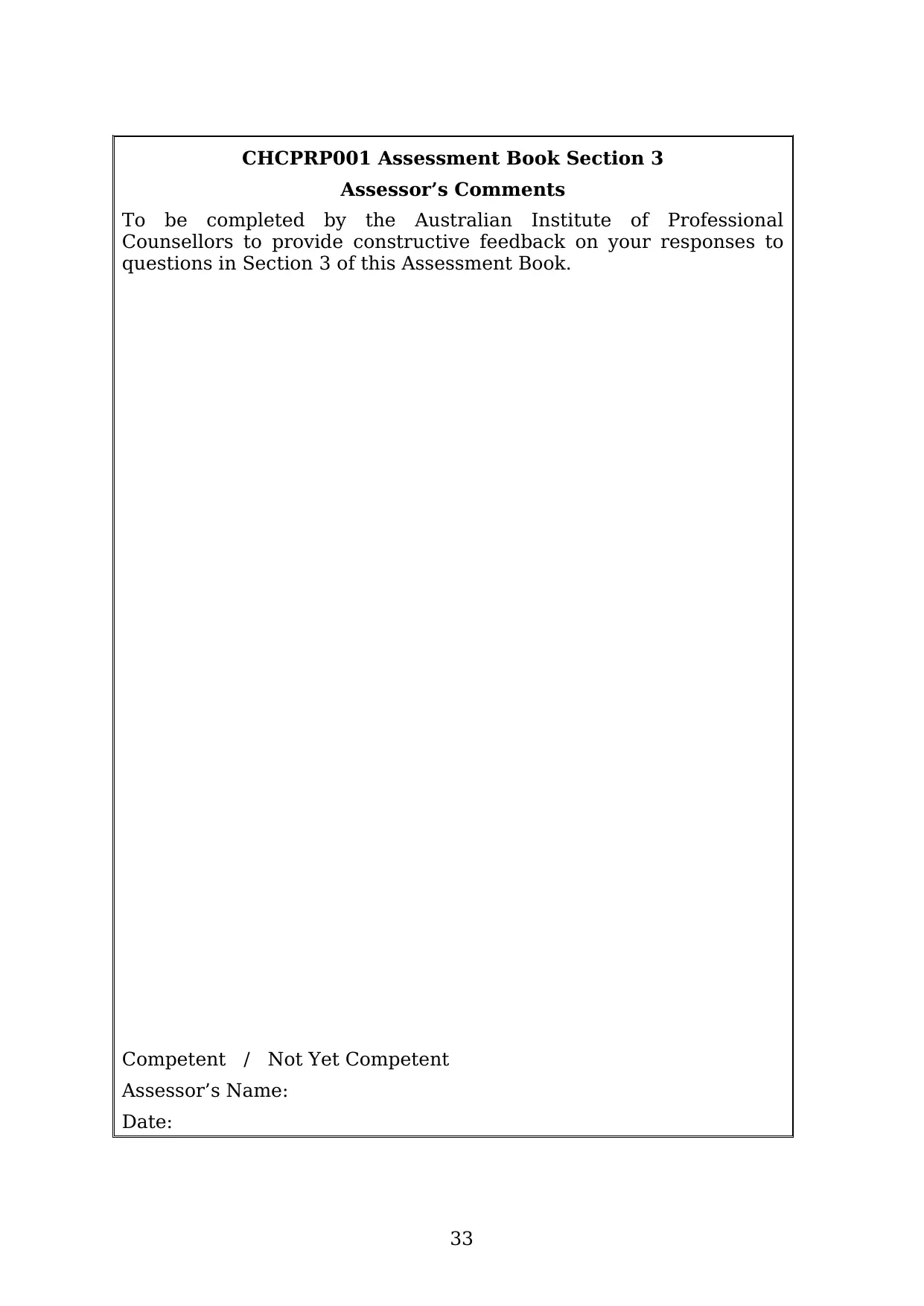
CHCPRP001 Assessment Book Section 3
Assessor’s Comments
To be completed by the Australian Institute of Professional
Counsellors to provide constructive feedback on your responses to
questions in Section 3 of this Assessment Book.
Competent / Not Yet Competent
Assessor’s Name:
Date:
33
Assessor’s Comments
To be completed by the Australian Institute of Professional
Counsellors to provide constructive feedback on your responses to
questions in Section 3 of this Assessment Book.
Competent / Not Yet Competent
Assessor’s Name:
Date:
33
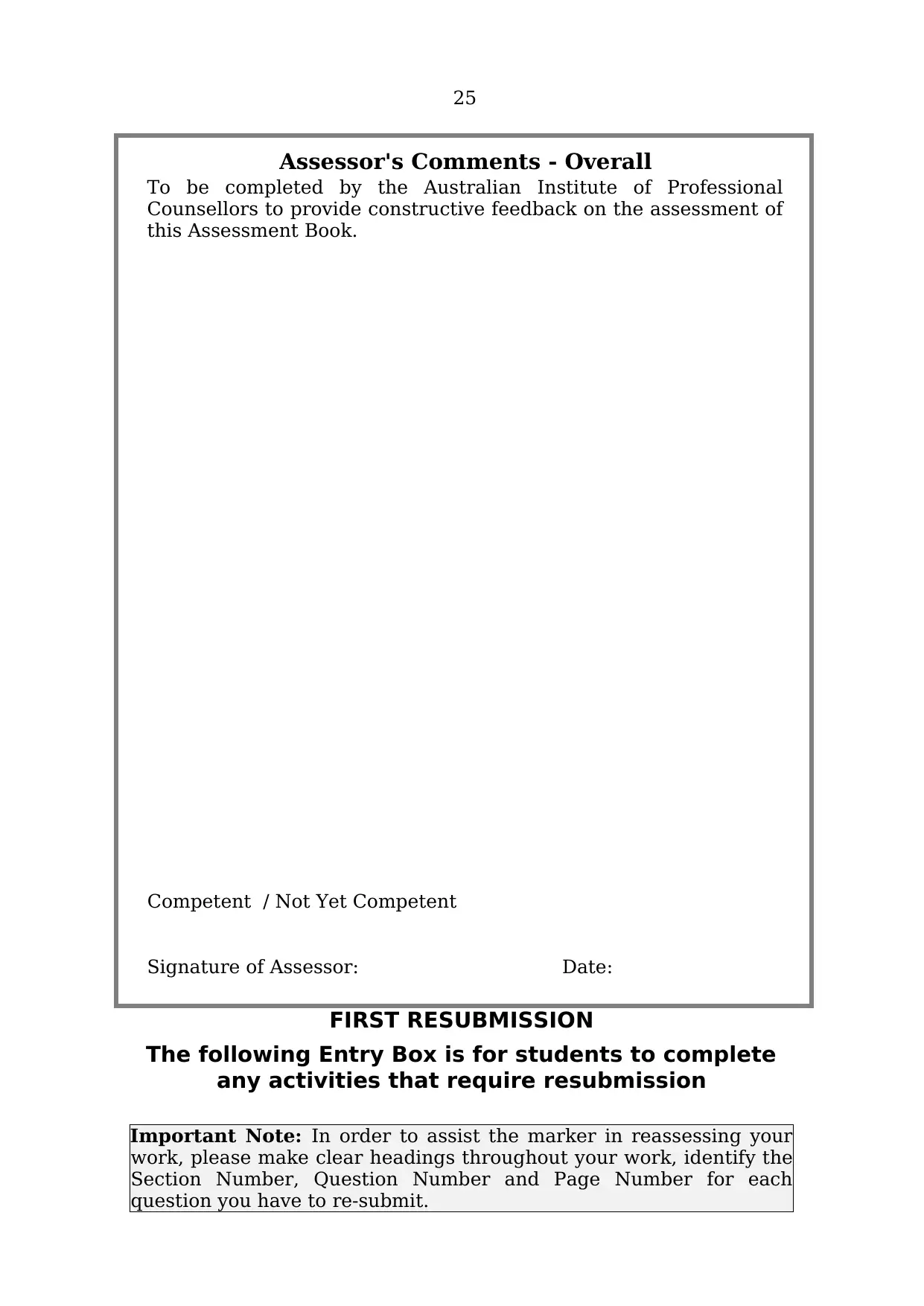
25
Assessor's Comments - Overall
To be completed by the Australian Institute of Professional
Counsellors to provide constructive feedback on the assessment of
this Assessment Book.
Competent / Not Yet Competent
Signature of Assessor: Date:
FIRST RESUBMISSION
The following Entry Box is for students to complete
any activities that require resubmission
Important Note: In order to assist the marker in reassessing your
work, please make clear headings throughout your work, identify the
Section Number, Question Number and Page Number for each
question you have to re-submit.
Assessor's Comments - Overall
To be completed by the Australian Institute of Professional
Counsellors to provide constructive feedback on the assessment of
this Assessment Book.
Competent / Not Yet Competent
Signature of Assessor: Date:
FIRST RESUBMISSION
The following Entry Box is for students to complete
any activities that require resubmission
Important Note: In order to assist the marker in reassessing your
work, please make clear headings throughout your work, identify the
Section Number, Question Number and Page Number for each
question you have to re-submit.
Secure Best Marks with AI Grader
Need help grading? Try our AI Grader for instant feedback on your assignments.
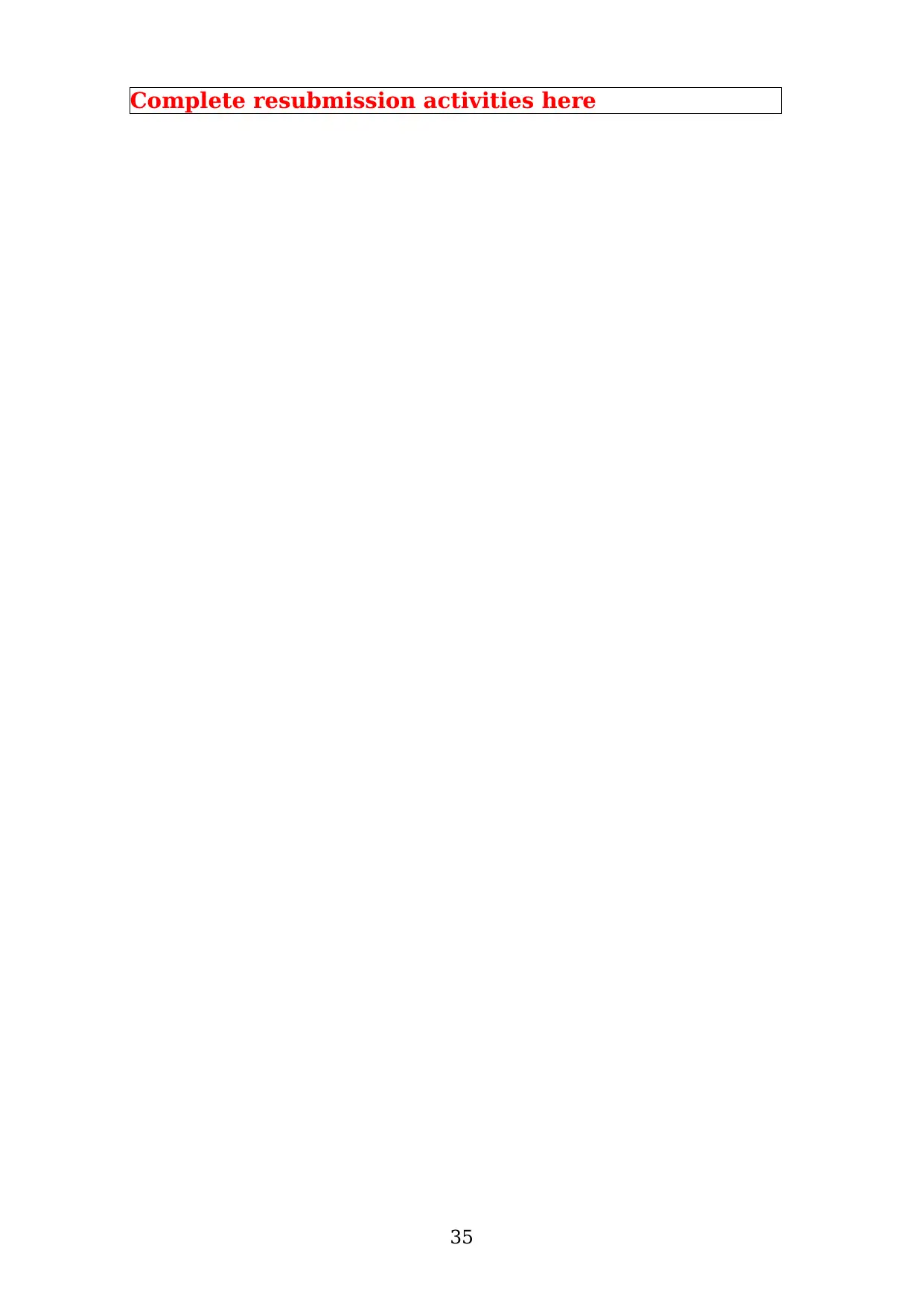
Complete resubmission activities here
35
35
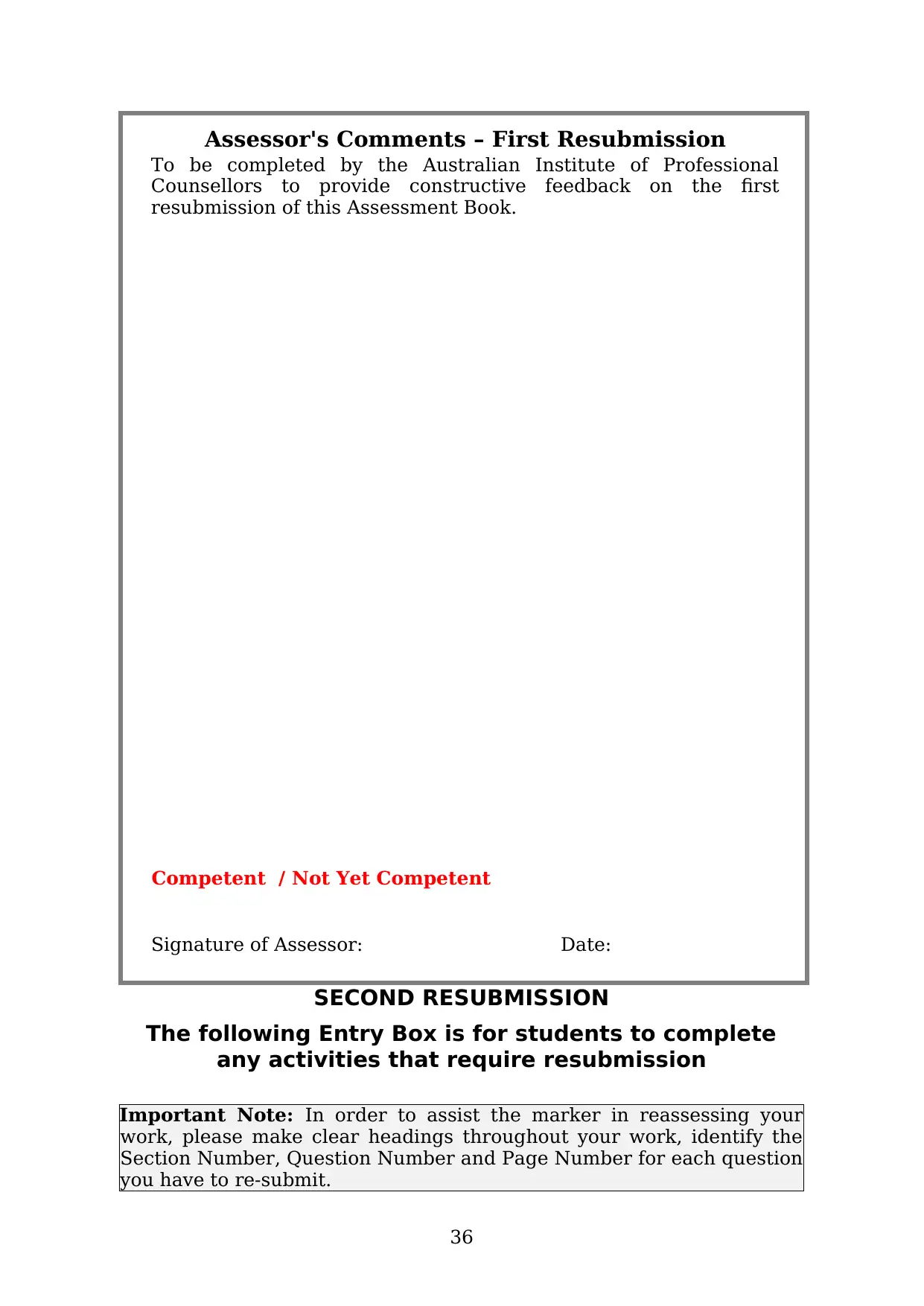
Assessor's Comments – First Resubmission
To be completed by the Australian Institute of Professional
Counsellors to provide constructive feedback on the first
resubmission of this Assessment Book.
Competent / Not Yet Competent
Signature of Assessor: Date:
SECOND RESUBMISSION
The following Entry Box is for students to complete
any activities that require resubmission
Important Note: In order to assist the marker in reassessing your
work, please make clear headings throughout your work, identify the
Section Number, Question Number and Page Number for each question
you have to re-submit.
36
To be completed by the Australian Institute of Professional
Counsellors to provide constructive feedback on the first
resubmission of this Assessment Book.
Competent / Not Yet Competent
Signature of Assessor: Date:
SECOND RESUBMISSION
The following Entry Box is for students to complete
any activities that require resubmission
Important Note: In order to assist the marker in reassessing your
work, please make clear headings throughout your work, identify the
Section Number, Question Number and Page Number for each question
you have to re-submit.
36

Complete second resubmission activities here
37
37
Paraphrase This Document
Need a fresh take? Get an instant paraphrase of this document with our AI Paraphraser
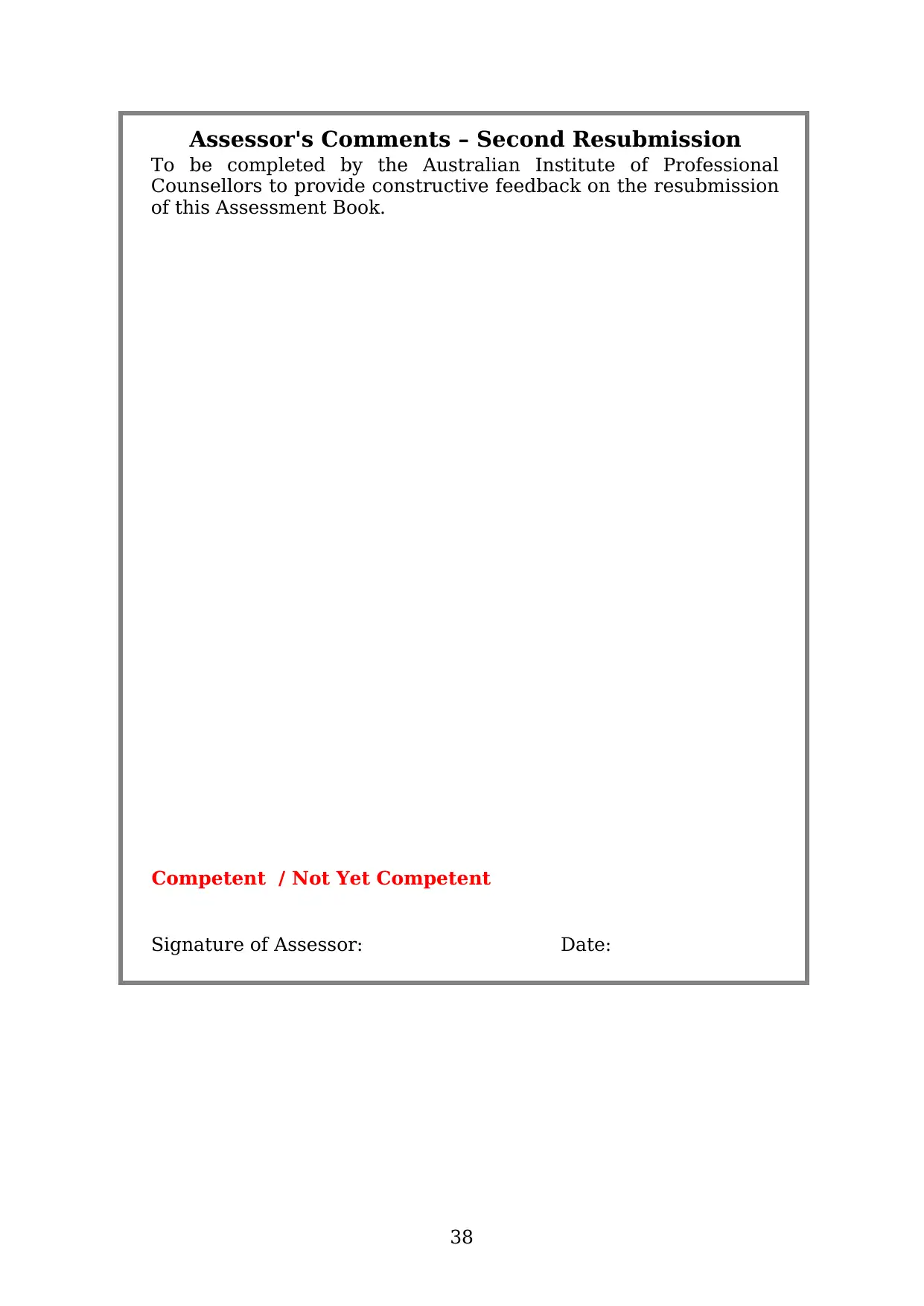
Assessor's Comments – Second Resubmission
To be completed by the Australian Institute of Professional
Counsellors to provide constructive feedback on the resubmission
of this Assessment Book.
Competent / Not Yet Competent
Signature of Assessor: Date:
38
To be completed by the Australian Institute of Professional
Counsellors to provide constructive feedback on the resubmission
of this Assessment Book.
Competent / Not Yet Competent
Signature of Assessor: Date:
38
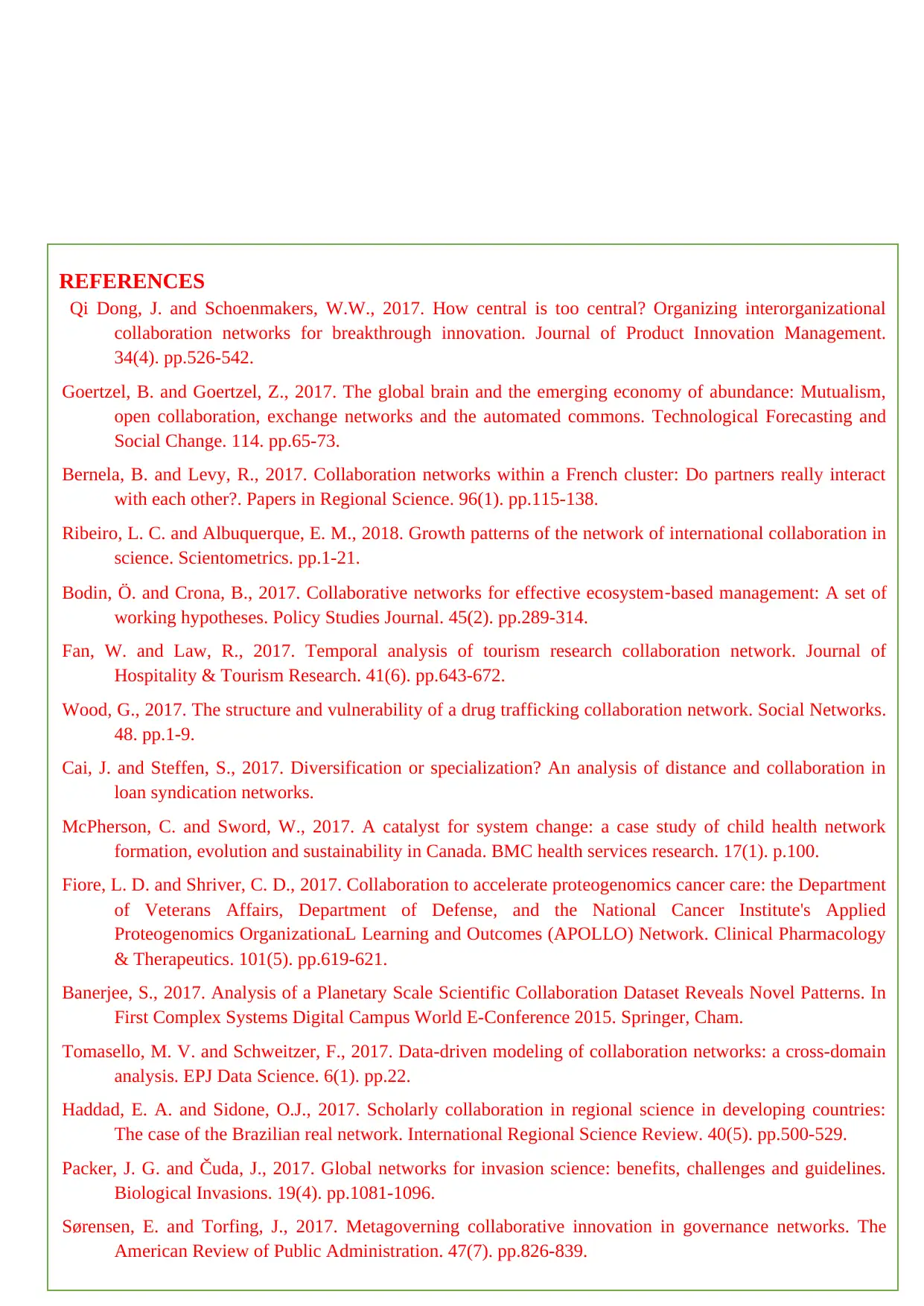
39
REFERENCES
Qi Dong, J. and Schoenmakers, W.W., 2017. How central is too central? Organizing interorganizational
collaboration networks for breakthrough innovation. Journal of Product Innovation Management.
34(4). pp.526-542.
Goertzel, B. and Goertzel, Z., 2017. The global brain and the emerging economy of abundance: Mutualism,
open collaboration, exchange networks and the automated commons. Technological Forecasting and
Social Change. 114. pp.65-73.
Bernela, B. and Levy, R., 2017. Collaboration networks within a French cluster: Do partners really interact
with each other?. Papers in Regional Science. 96(1). pp.115-138.
Ribeiro, L. C. and Albuquerque, E. M., 2018. Growth patterns of the network of international collaboration in
science. Scientometrics. pp.1-21.
Bodin, Ö. and Crona, B., 2017. Collaborative networks for effective ecosystem‐based management: A set of
working hypotheses. Policy Studies Journal. 45(2). pp.289-314.
Fan, W. and Law, R., 2017. Temporal analysis of tourism research collaboration network. Journal of
Hospitality & Tourism Research. 41(6). pp.643-672.
Wood, G., 2017. The structure and vulnerability of a drug trafficking collaboration network. Social Networks.
48. pp.1-9.
Cai, J. and Steffen, S., 2017. Diversification or specialization? An analysis of distance and collaboration in
loan syndication networks.
McPherson, C. and Sword, W., 2017. A catalyst for system change: a case study of child health network
formation, evolution and sustainability in Canada. BMC health services research. 17(1). p.100.
Fiore, L. D. and Shriver, C. D., 2017. Collaboration to accelerate proteogenomics cancer care: the Department
of Veterans Affairs, Department of Defense, and the National Cancer Institute's Applied
Proteogenomics OrganizationaL Learning and Outcomes (APOLLO) Network. Clinical Pharmacology
& Therapeutics. 101(5). pp.619-621.
Banerjee, S., 2017. Analysis of a Planetary Scale Scientific Collaboration Dataset Reveals Novel Patterns. In
First Complex Systems Digital Campus World E-Conference 2015. Springer, Cham.
Tomasello, M. V. and Schweitzer, F., 2017. Data-driven modeling of collaboration networks: a cross-domain
analysis. EPJ Data Science. 6(1). pp.22.
Haddad, E. A. and Sidone, O.J., 2017. Scholarly collaboration in regional science in developing countries:
The case of the Brazilian real network. International Regional Science Review. 40(5). pp.500-529.
Packer, J. G. and Čuda, J., 2017. Global networks for invasion science: benefits, challenges and guidelines.
Biological Invasions. 19(4). pp.1081-1096.
Sørensen, E. and Torfing, J., 2017. Metagoverning collaborative innovation in governance networks. The
American Review of Public Administration. 47(7). pp.826-839.
REFERENCES
Qi Dong, J. and Schoenmakers, W.W., 2017. How central is too central? Organizing interorganizational
collaboration networks for breakthrough innovation. Journal of Product Innovation Management.
34(4). pp.526-542.
Goertzel, B. and Goertzel, Z., 2017. The global brain and the emerging economy of abundance: Mutualism,
open collaboration, exchange networks and the automated commons. Technological Forecasting and
Social Change. 114. pp.65-73.
Bernela, B. and Levy, R., 2017. Collaboration networks within a French cluster: Do partners really interact
with each other?. Papers in Regional Science. 96(1). pp.115-138.
Ribeiro, L. C. and Albuquerque, E. M., 2018. Growth patterns of the network of international collaboration in
science. Scientometrics. pp.1-21.
Bodin, Ö. and Crona, B., 2017. Collaborative networks for effective ecosystem‐based management: A set of
working hypotheses. Policy Studies Journal. 45(2). pp.289-314.
Fan, W. and Law, R., 2017. Temporal analysis of tourism research collaboration network. Journal of
Hospitality & Tourism Research. 41(6). pp.643-672.
Wood, G., 2017. The structure and vulnerability of a drug trafficking collaboration network. Social Networks.
48. pp.1-9.
Cai, J. and Steffen, S., 2017. Diversification or specialization? An analysis of distance and collaboration in
loan syndication networks.
McPherson, C. and Sword, W., 2017. A catalyst for system change: a case study of child health network
formation, evolution and sustainability in Canada. BMC health services research. 17(1). p.100.
Fiore, L. D. and Shriver, C. D., 2017. Collaboration to accelerate proteogenomics cancer care: the Department
of Veterans Affairs, Department of Defense, and the National Cancer Institute's Applied
Proteogenomics OrganizationaL Learning and Outcomes (APOLLO) Network. Clinical Pharmacology
& Therapeutics. 101(5). pp.619-621.
Banerjee, S., 2017. Analysis of a Planetary Scale Scientific Collaboration Dataset Reveals Novel Patterns. In
First Complex Systems Digital Campus World E-Conference 2015. Springer, Cham.
Tomasello, M. V. and Schweitzer, F., 2017. Data-driven modeling of collaboration networks: a cross-domain
analysis. EPJ Data Science. 6(1). pp.22.
Haddad, E. A. and Sidone, O.J., 2017. Scholarly collaboration in regional science in developing countries:
The case of the Brazilian real network. International Regional Science Review. 40(5). pp.500-529.
Packer, J. G. and Čuda, J., 2017. Global networks for invasion science: benefits, challenges and guidelines.
Biological Invasions. 19(4). pp.1081-1096.
Sørensen, E. and Torfing, J., 2017. Metagoverning collaborative innovation in governance networks. The
American Review of Public Administration. 47(7). pp.826-839.
1 out of 39
Related Documents
Your All-in-One AI-Powered Toolkit for Academic Success.
+13062052269
info@desklib.com
Available 24*7 on WhatsApp / Email
![[object Object]](/_next/static/media/star-bottom.7253800d.svg)
Unlock your academic potential
© 2024 | Zucol Services PVT LTD | All rights reserved.





